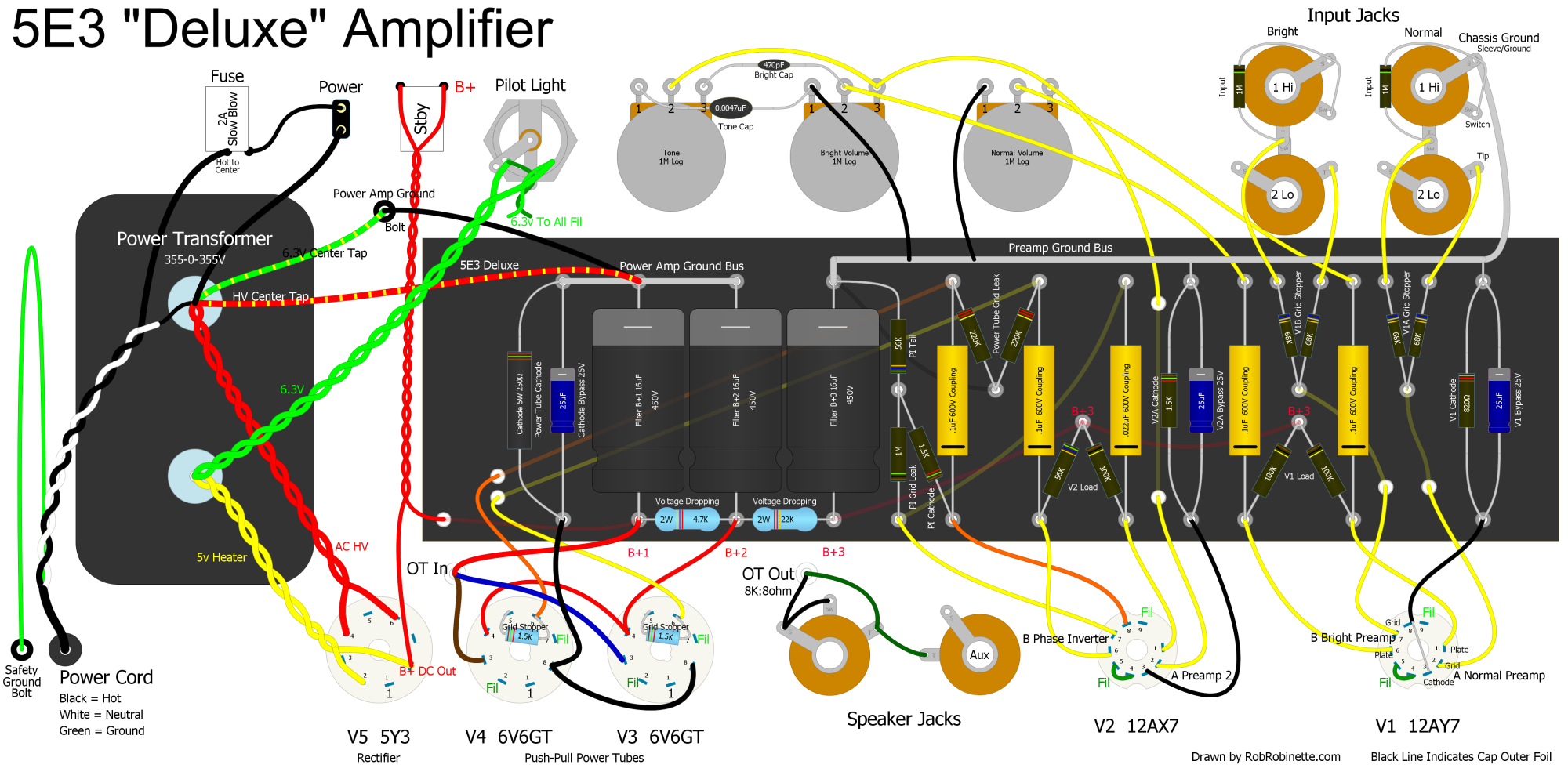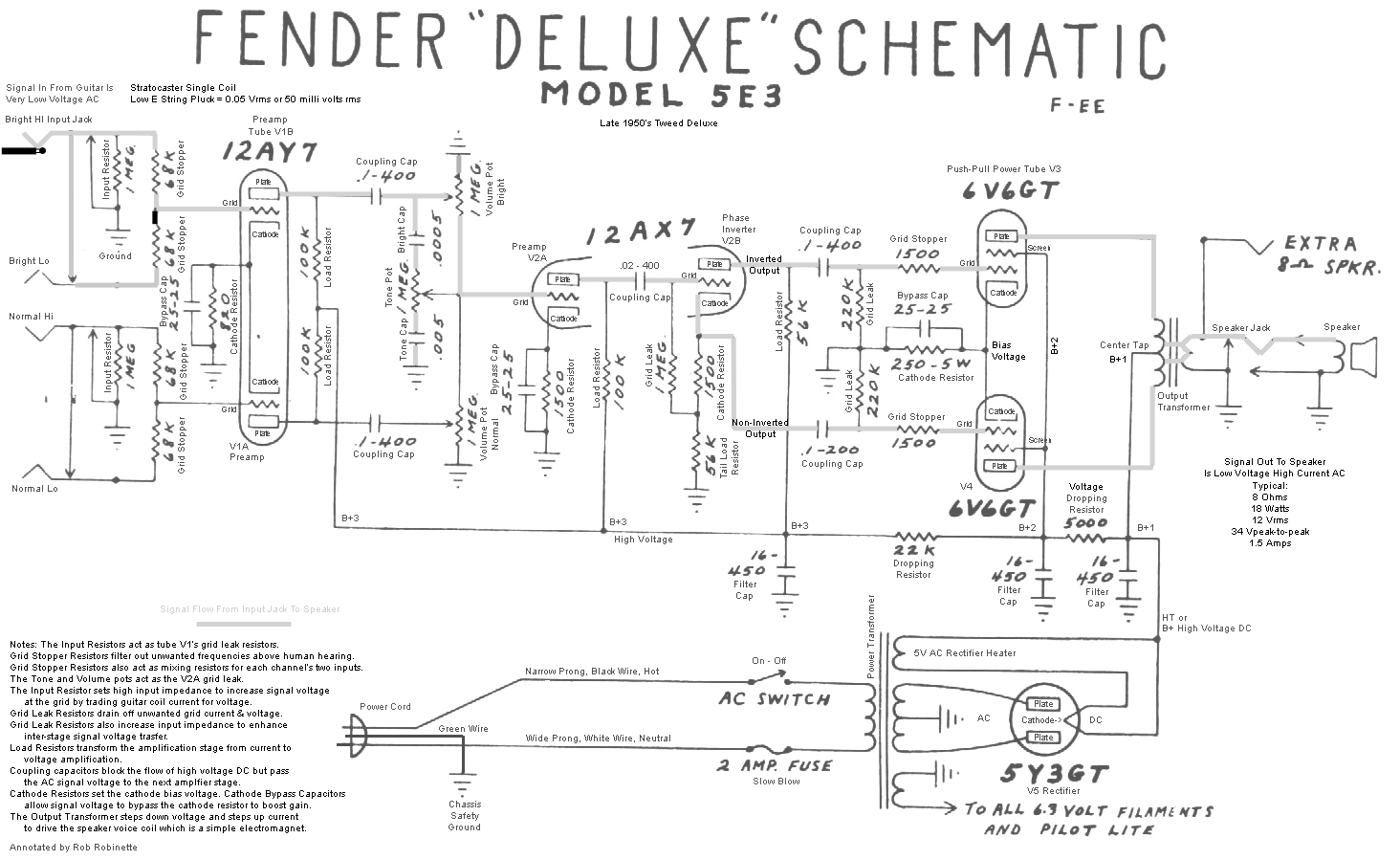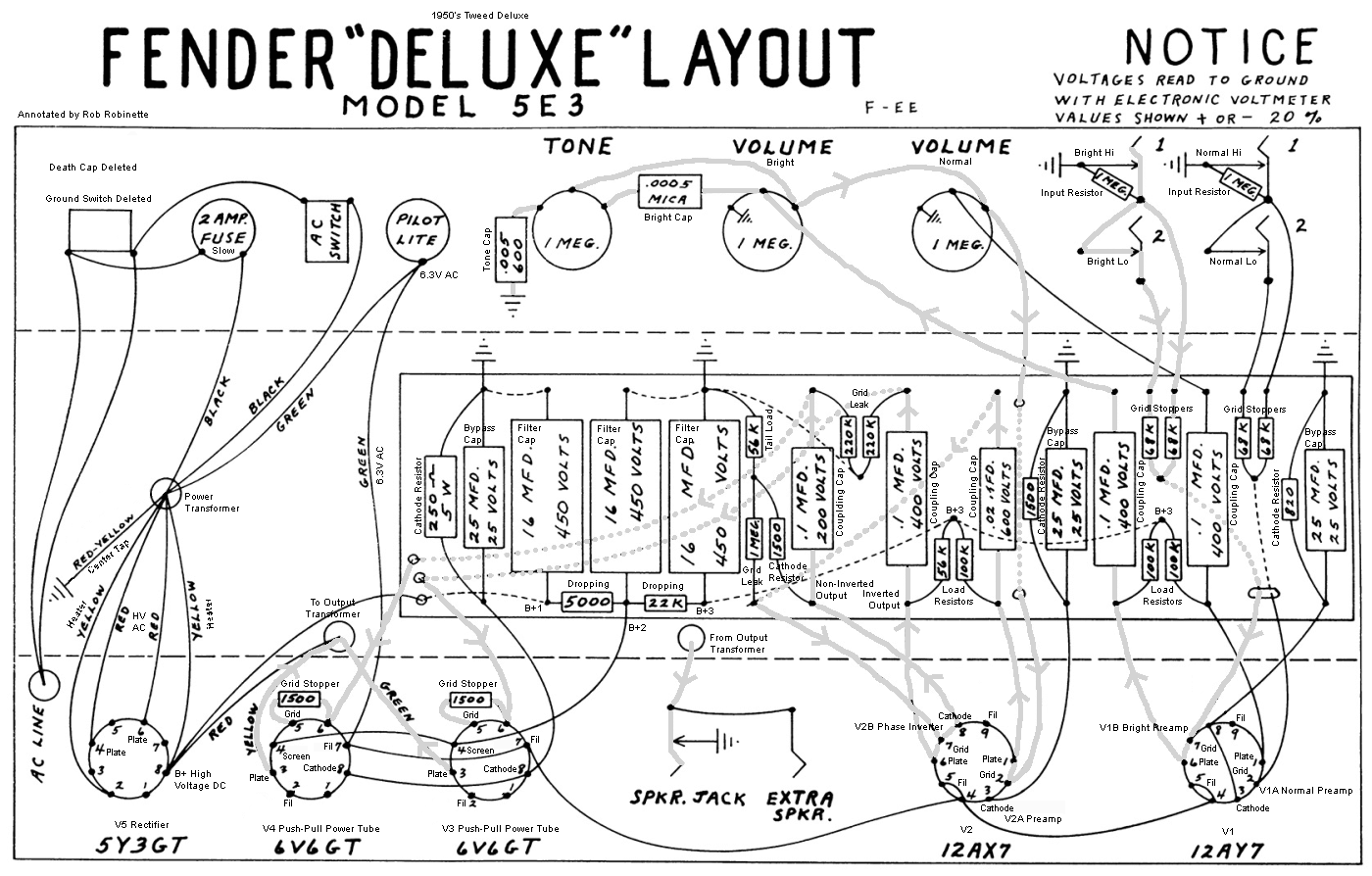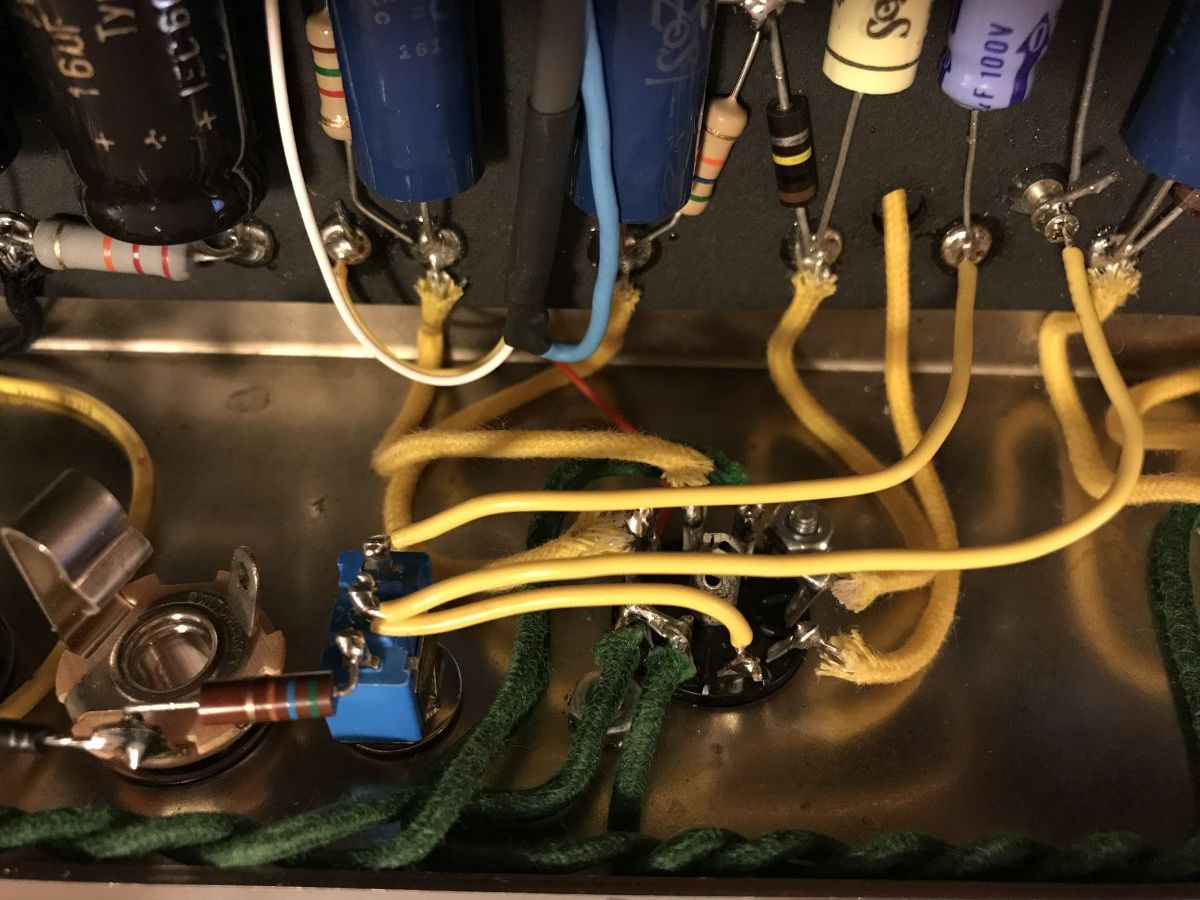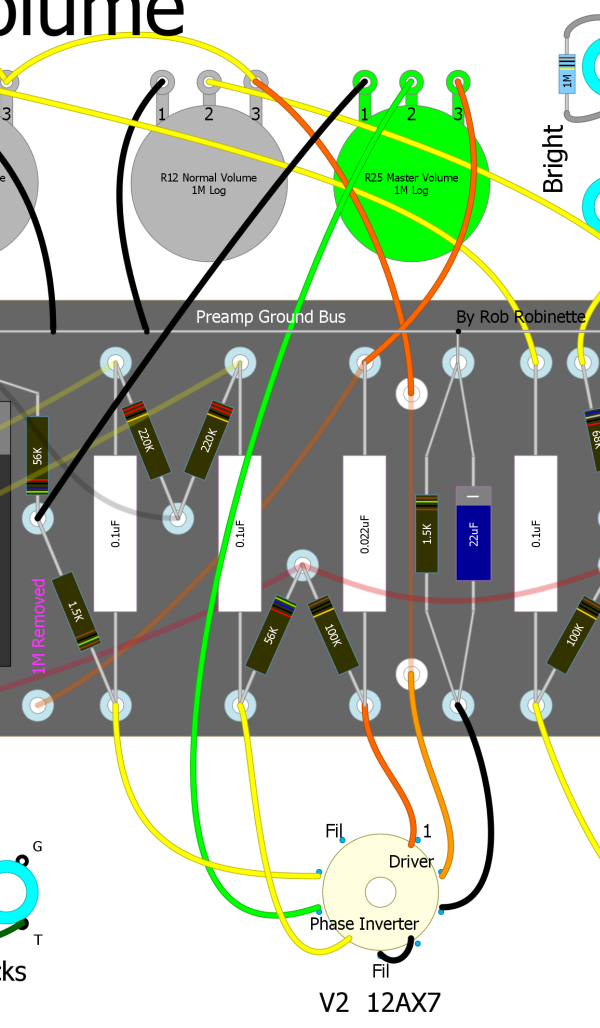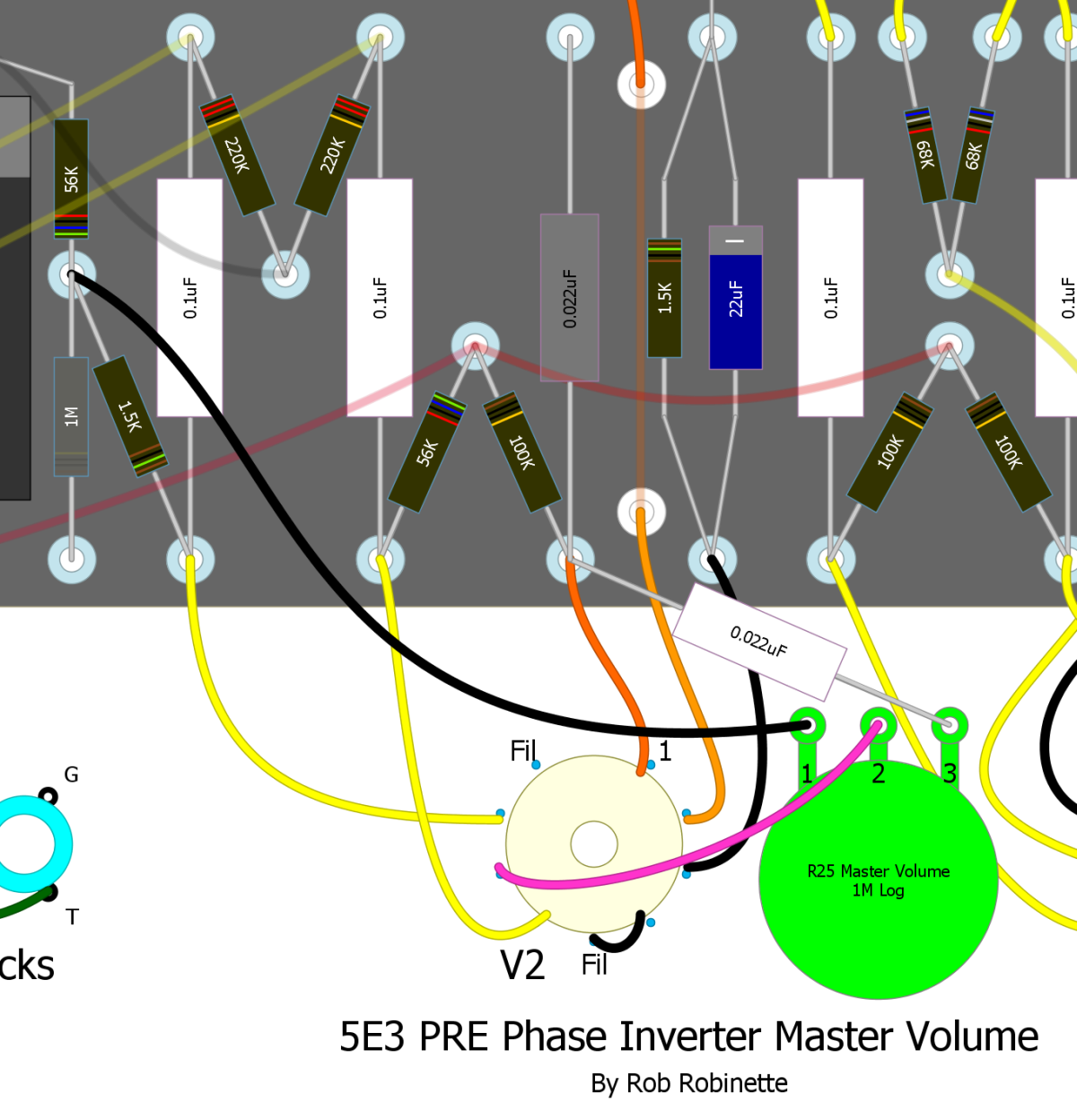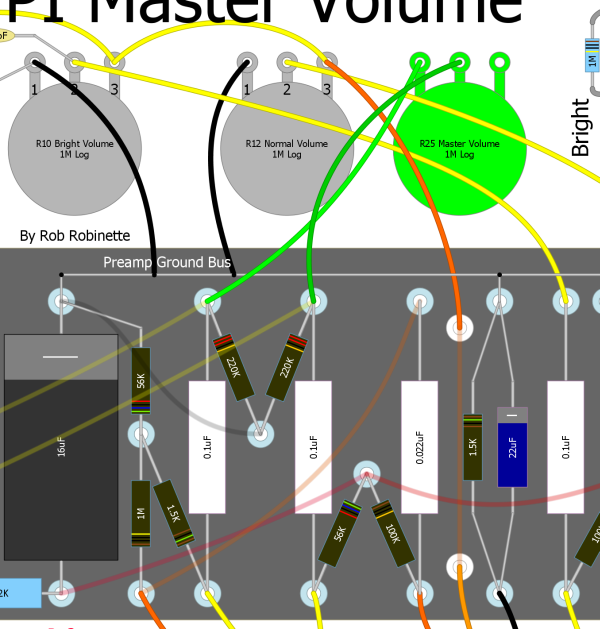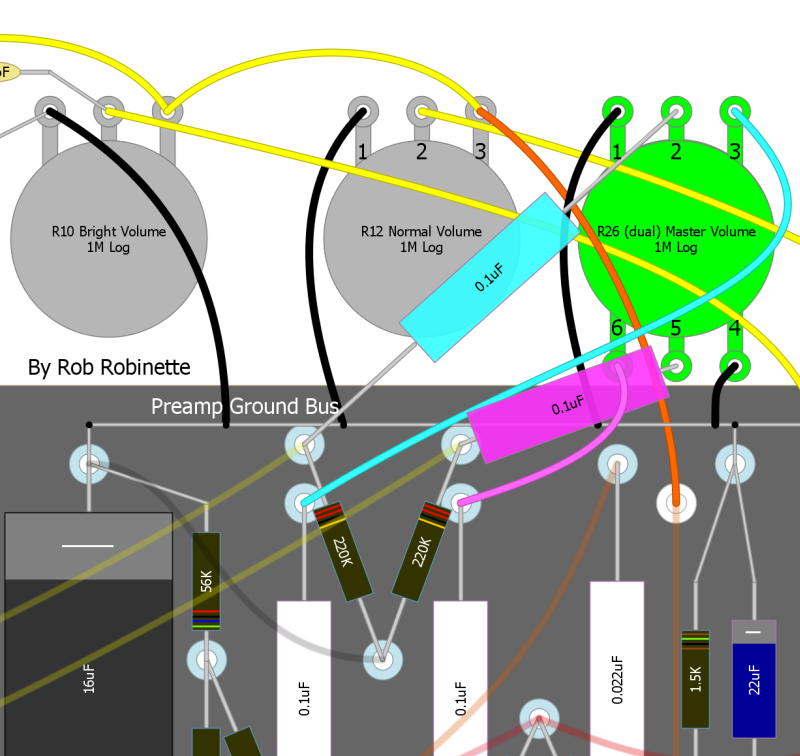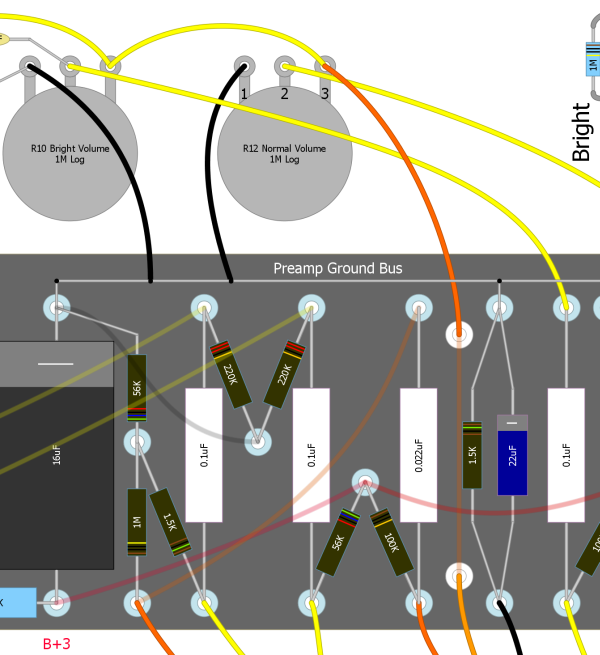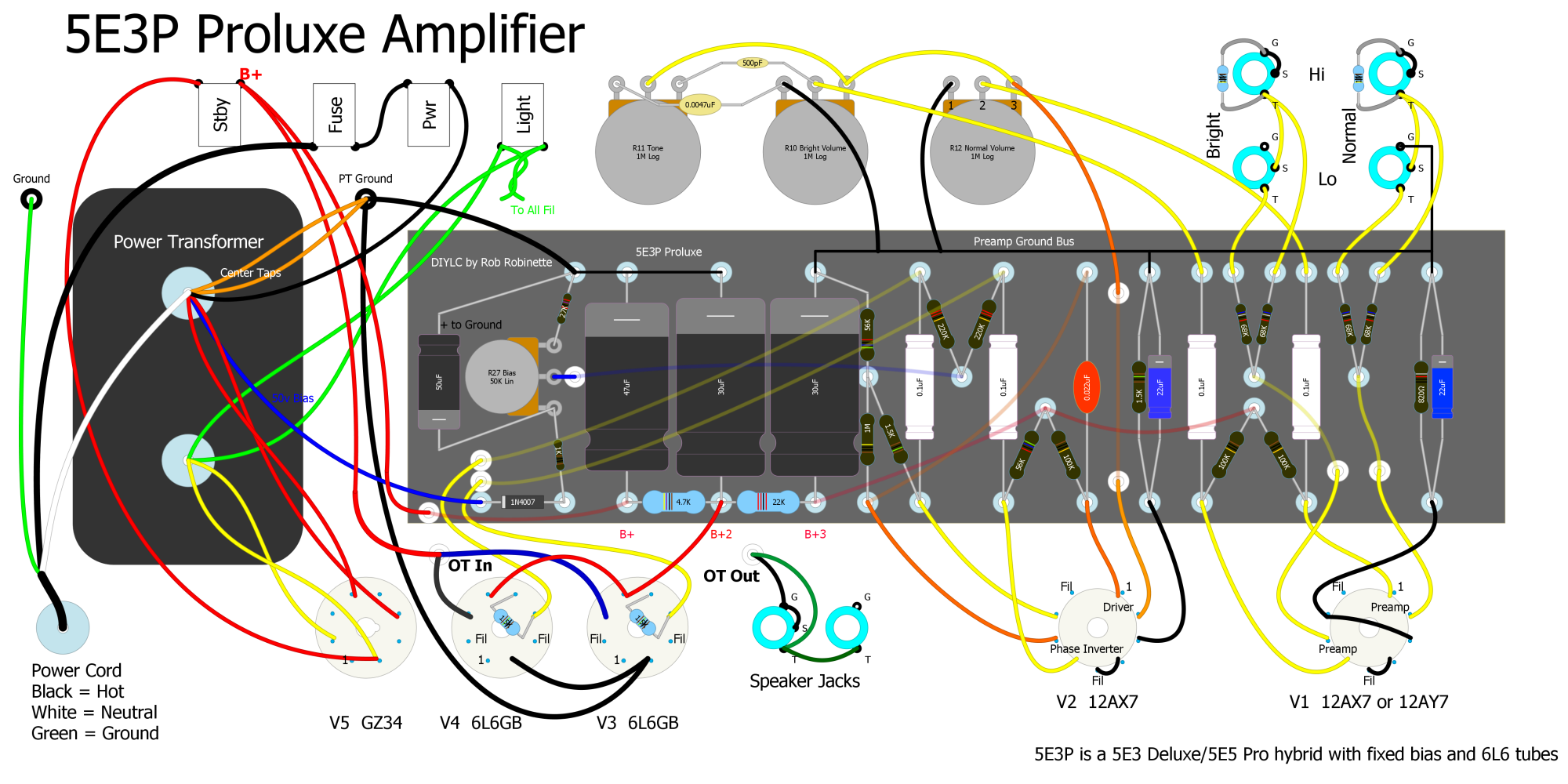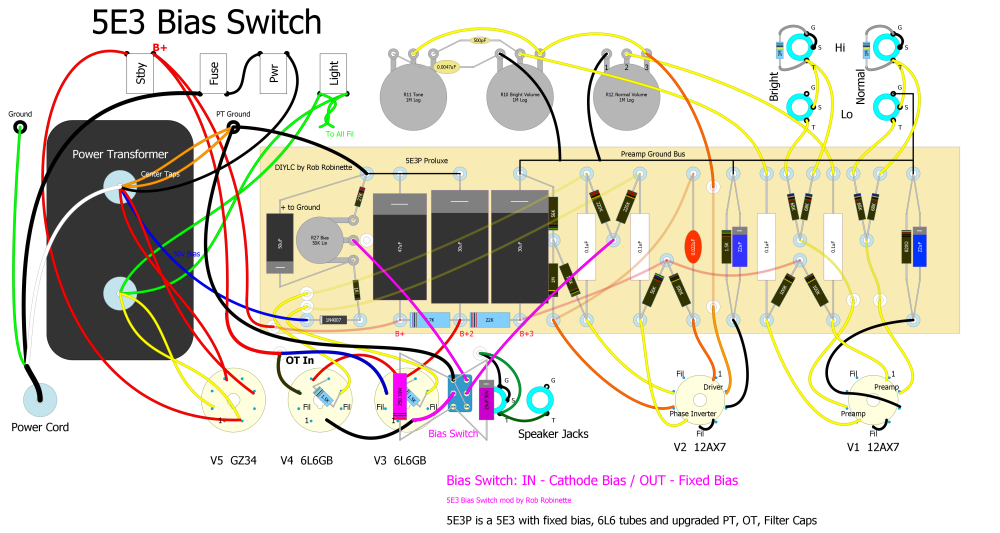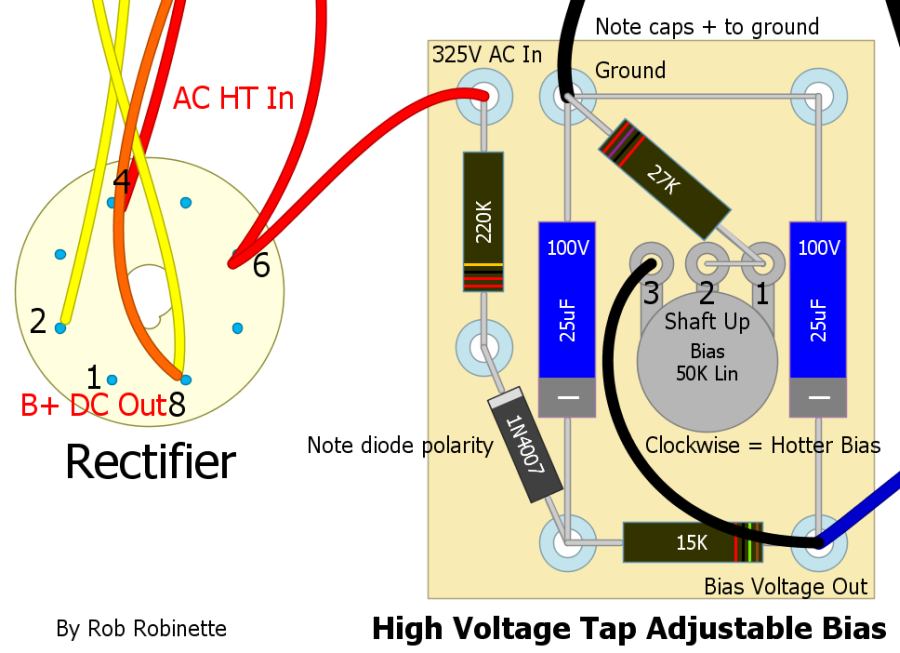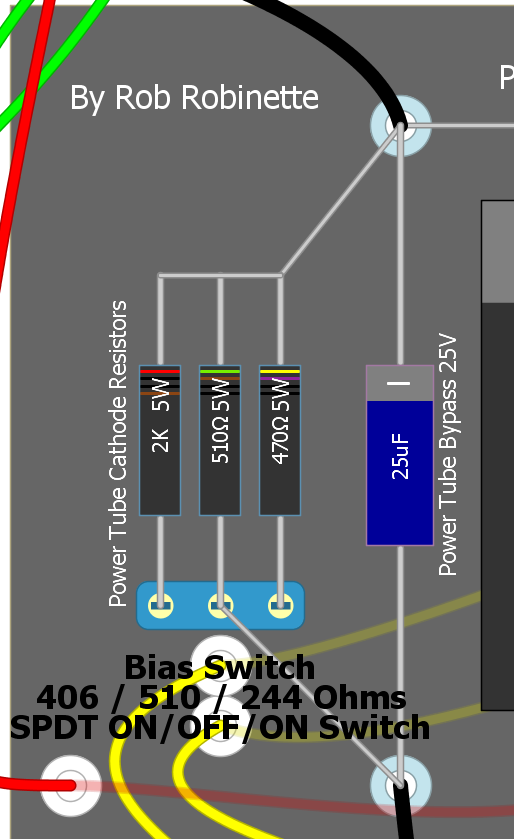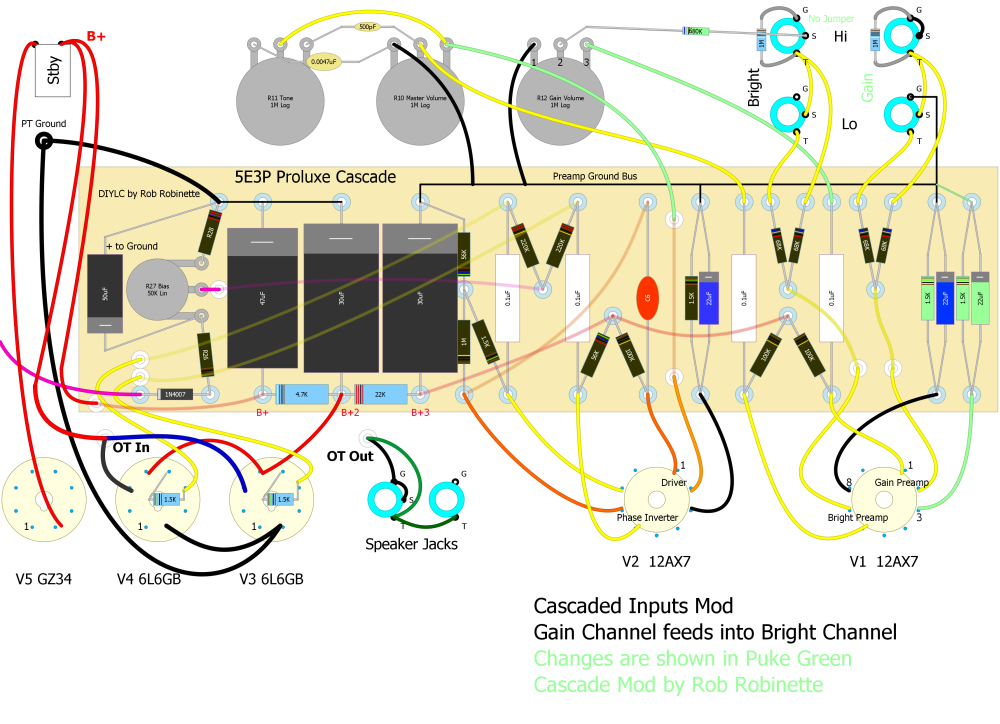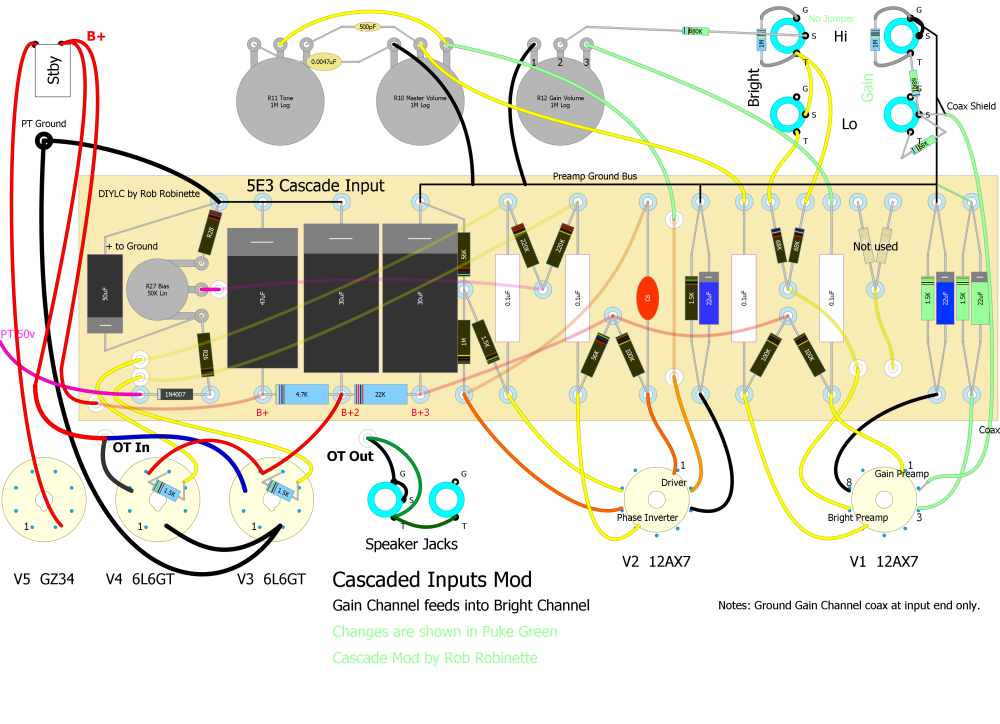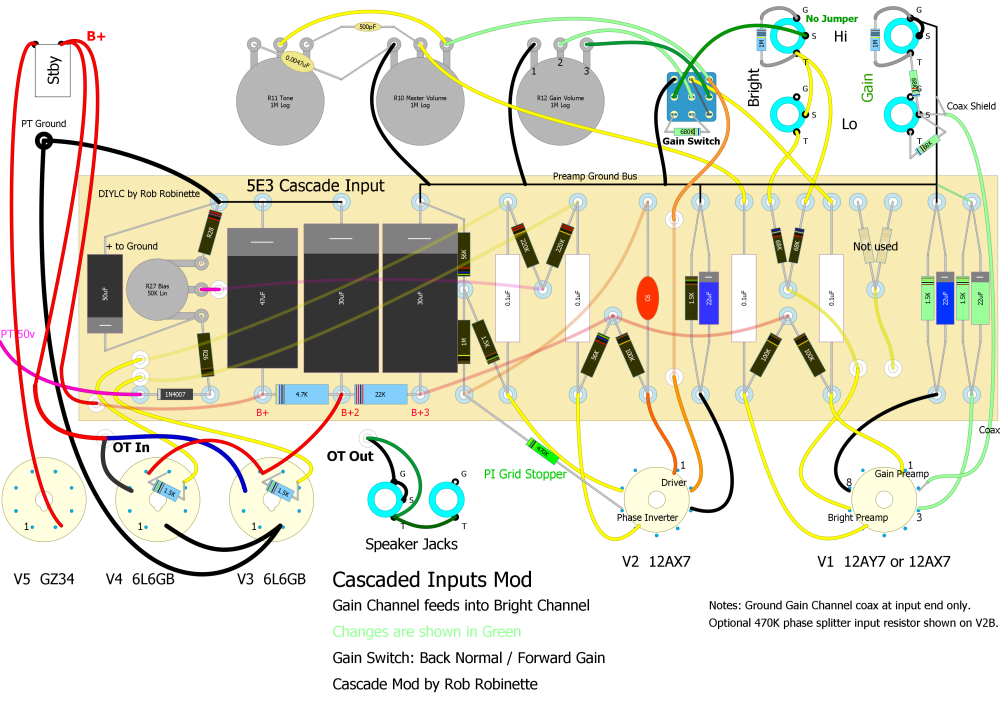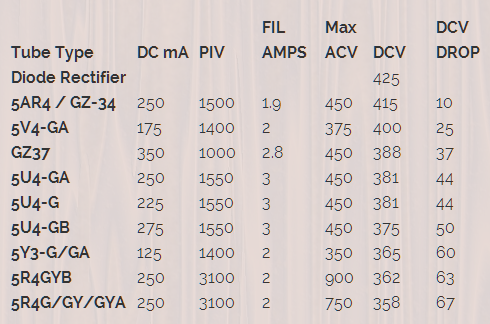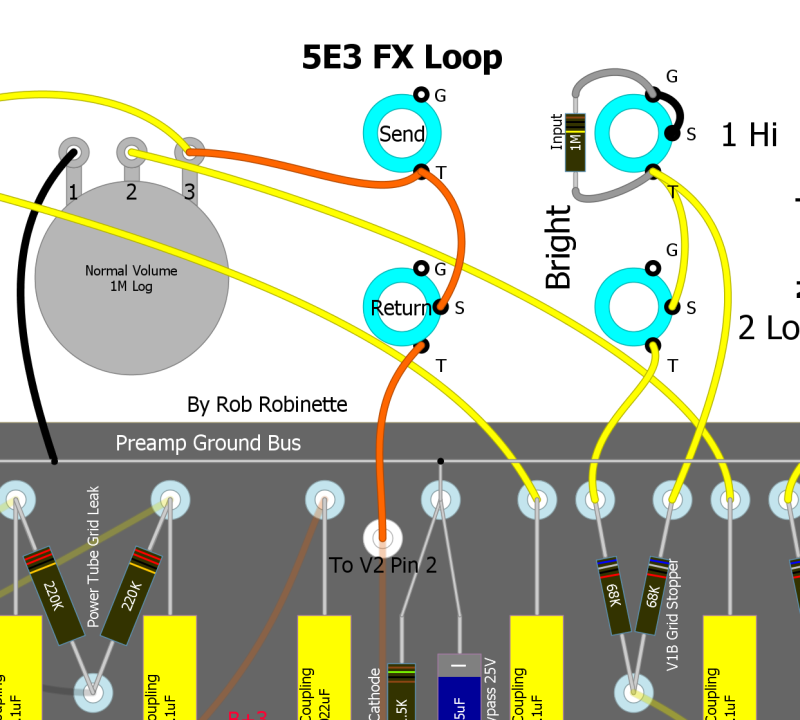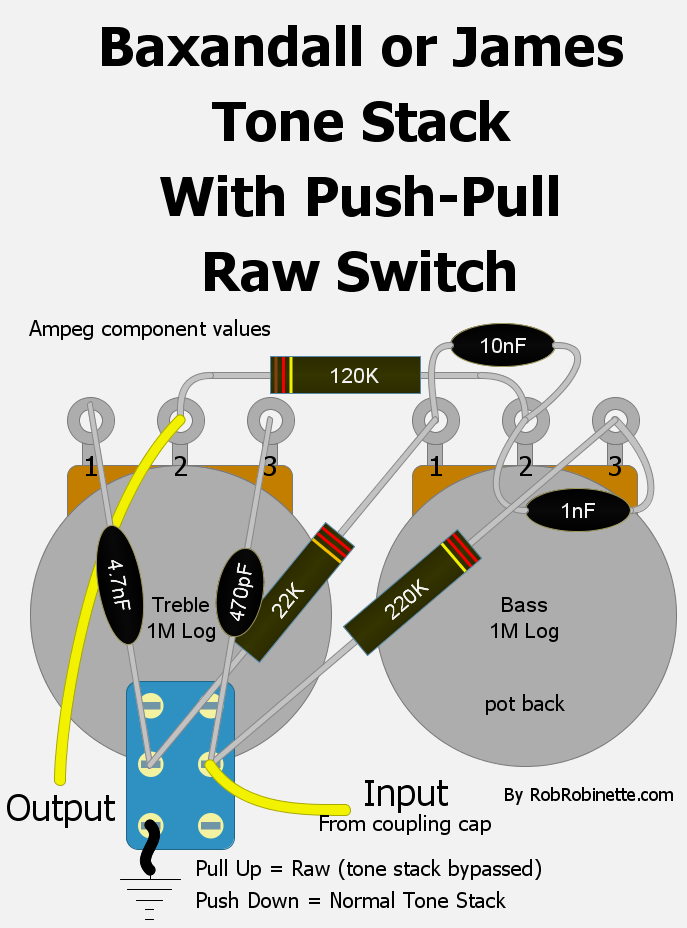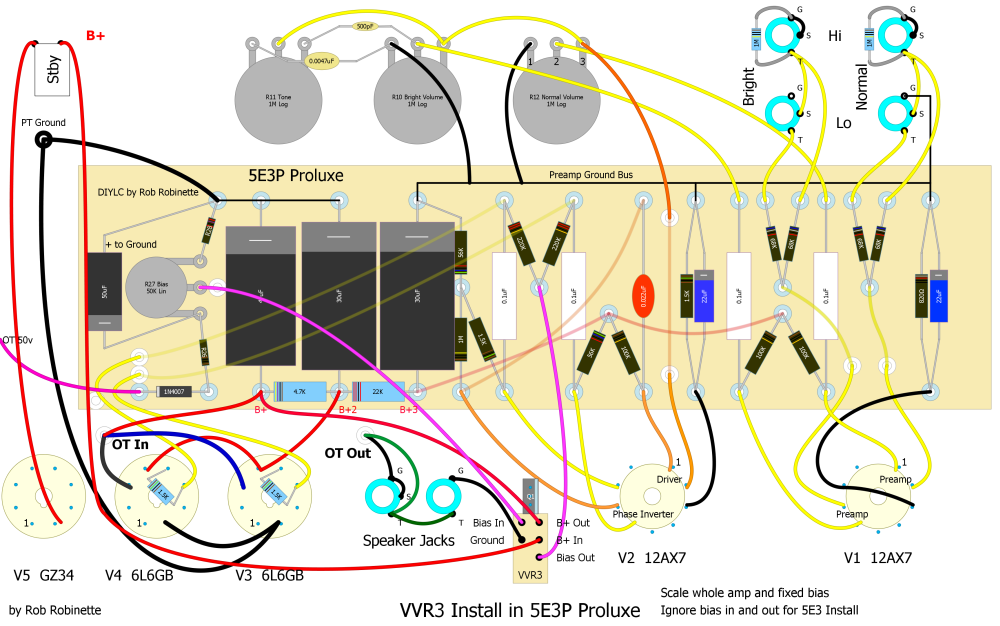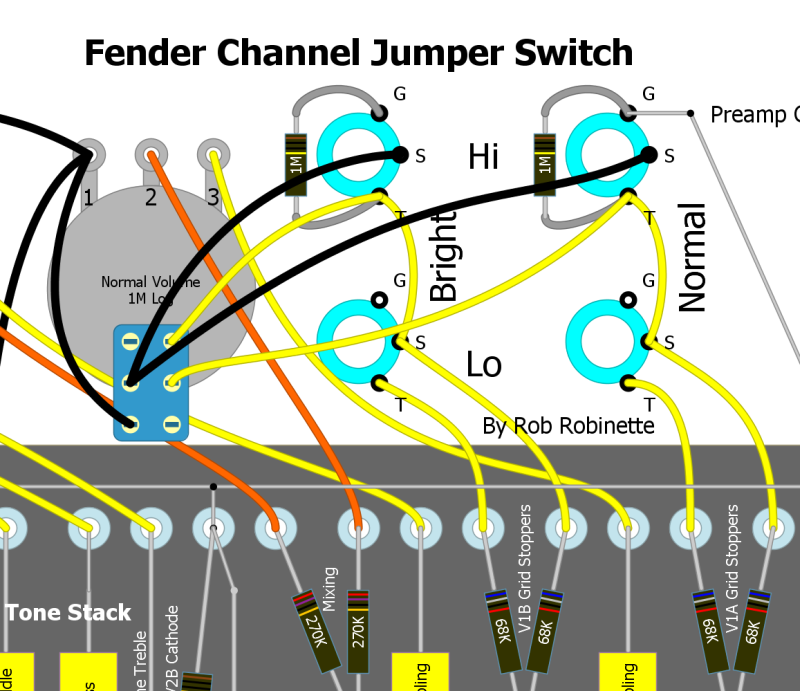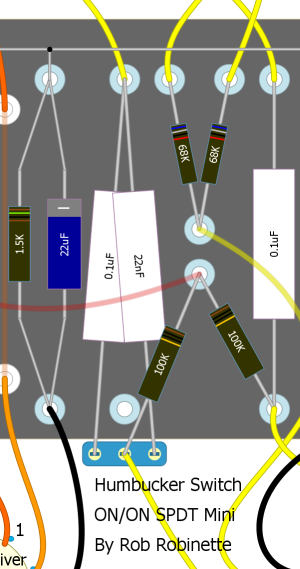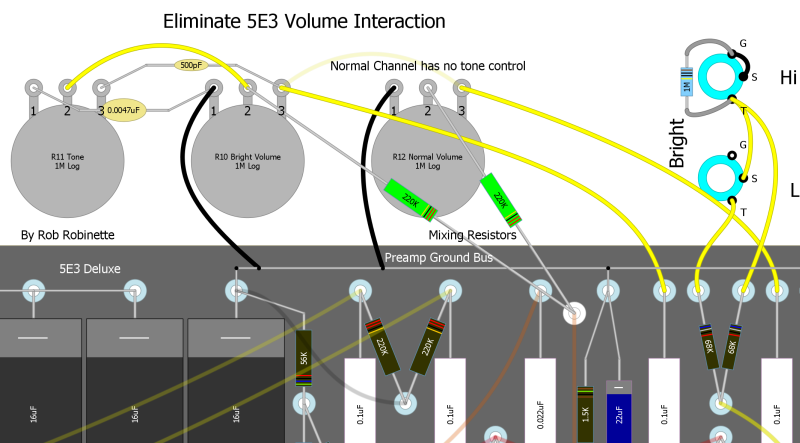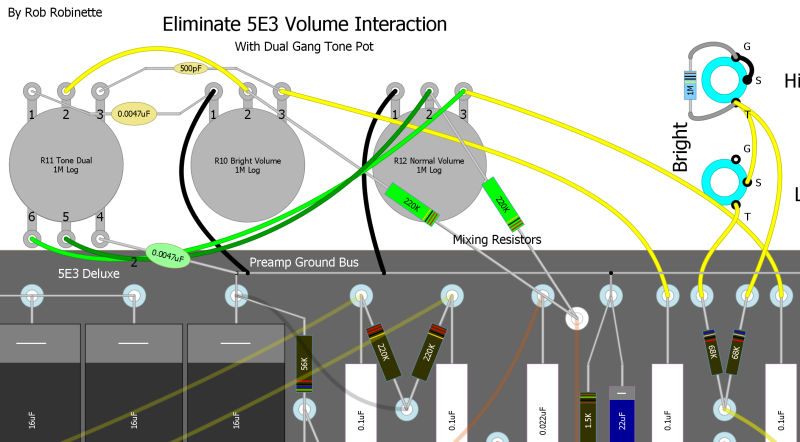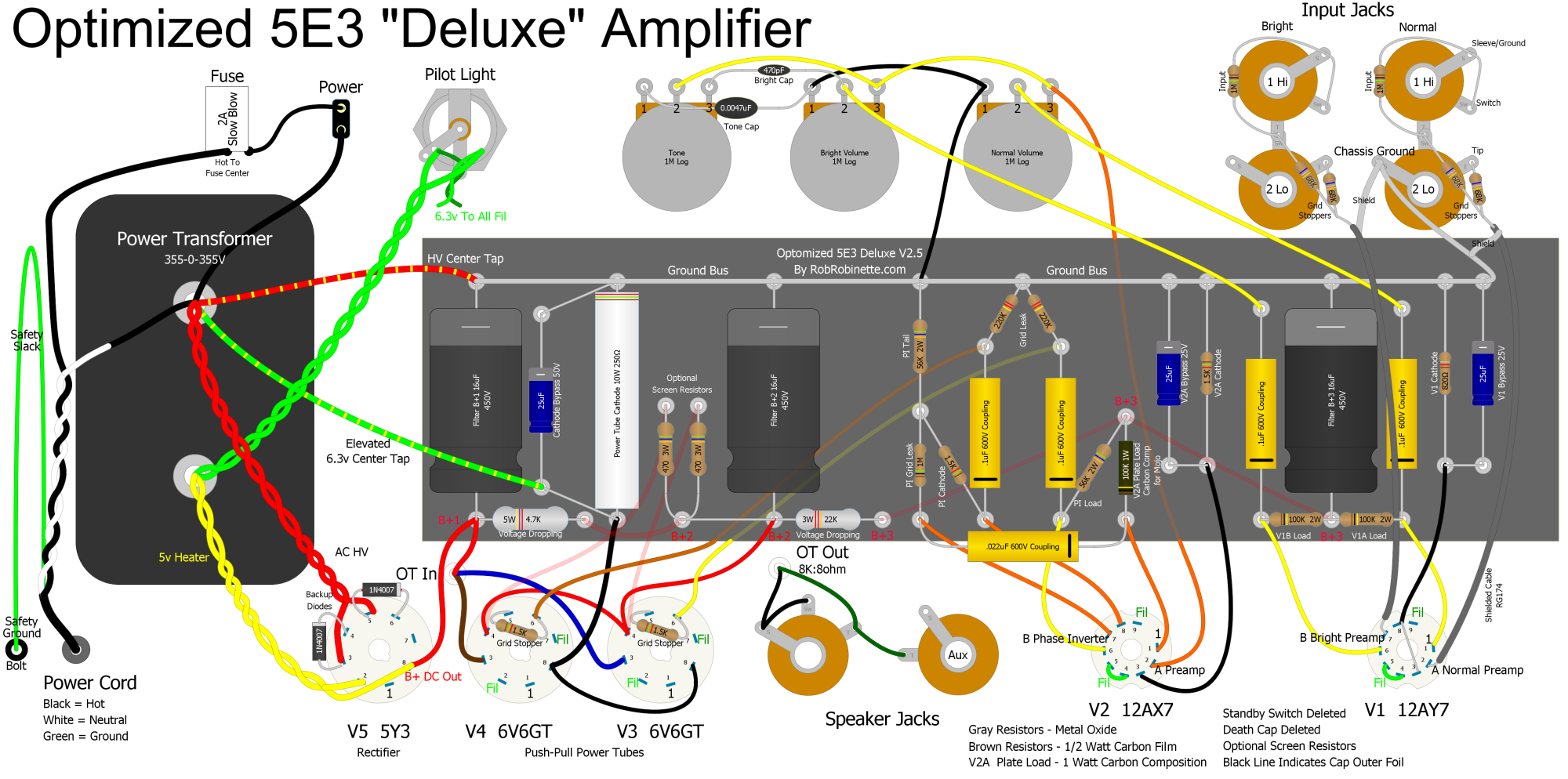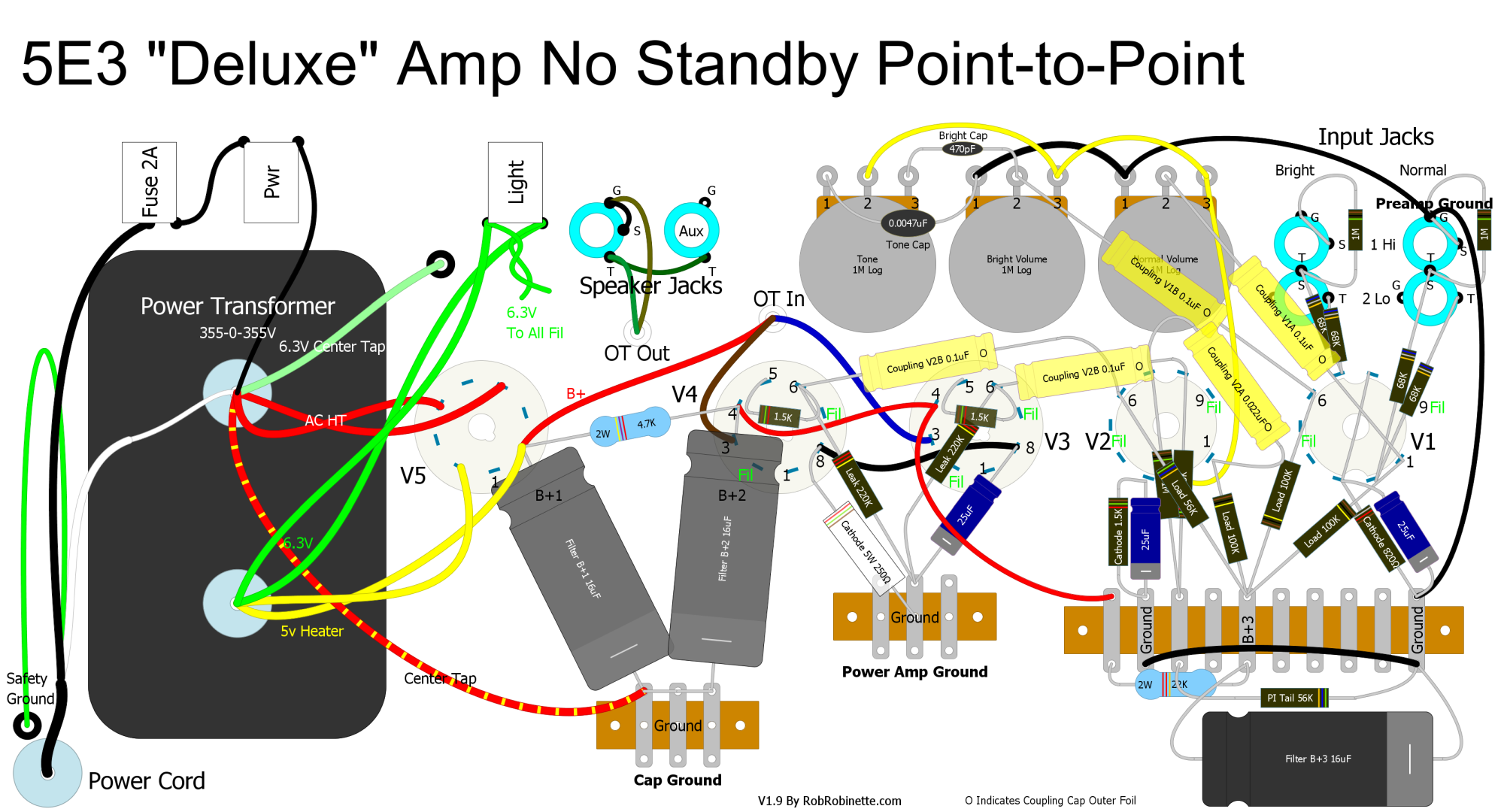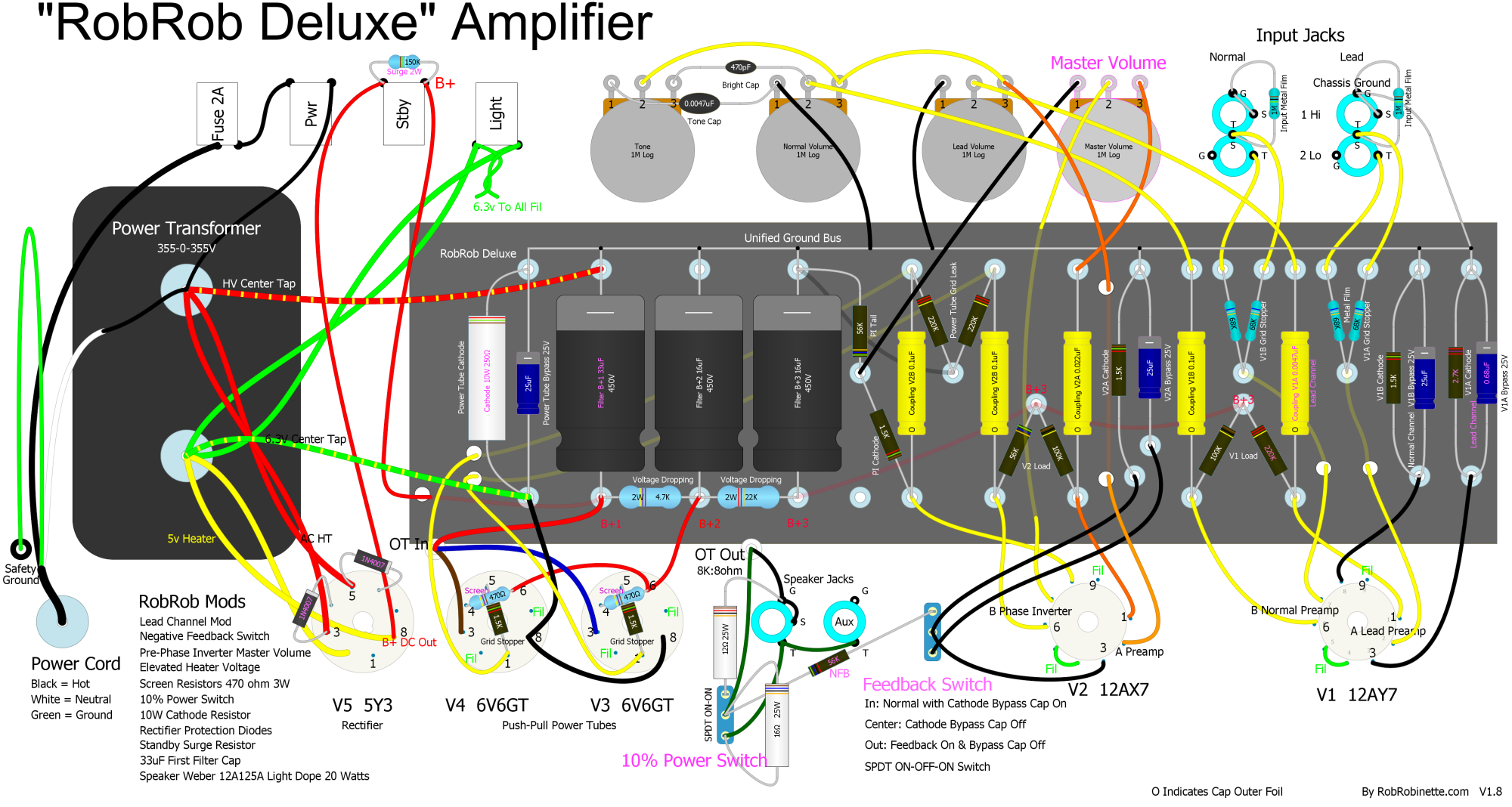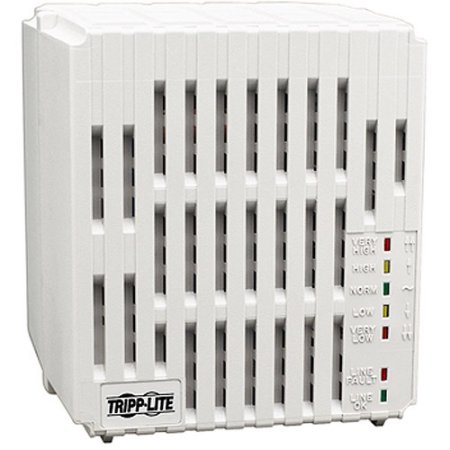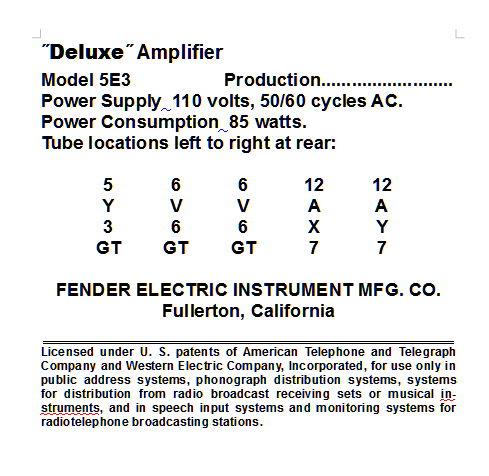Photo by Rob Robinette
Fender 5E3 Deluxe Amplifier Modifications
By Rob Robinette
I don't expect anyone to mod their original 5E3 Deluxe but if you have a Deluxe clone like me then adding some switchable mods can be beneficial. I'm not trying to improve the 5E3 so much as I'm trying to make the amp more versatile. Some of the mods work well together too. When I need more headroom I'll flip the feedback switch on but this pairs well with the Lead Channel and High Gain mods. My three favorite mods are: 1. Switched Negative Feedback 2. Lead Channel 3. Master Volume. Most of the mods below are on a switch so you can deactivate the mod. A slightly modified 5E3 can be a very versatile gig amp and I encourage everyone to build or buy one.
Take a look at the RobRob Deluxe which is a 5E3 Deluxe with many of my favorite mods incorporated.
For more 5E3 info see How the 5E3 Deluxe Works and My 5E3 Deluxe Build. If you are interested in how the Deluxe amplifier evolved from the 1940's to 2015 see Deluxe Models.
If you are new to the 5E3 then take a listen to this very well recorded demo of a BootHillAmps.com 5E3 kit. Here's another excellent demo of a home-built, (in a cake pan no less) unmodified 5E3 Deluxe: kdj 5E3 Deluxe YouTube Demo. These are the best 5E3 demos I've ever heard.
WARNING
Amplifiers have large capacitors that store enough electricity to kill even when the amplifier is unplugged. If you open an amplifier you MUST verify no voltage remains in the capacitors before working inside it. See more amp safety info here.
Table of Contents
3-way Switched Feedback: My favorite mod: Normal / No Cathode Bypass Cap / Negative Feedback - Adding NFB increases clean headroom and civilizes the 5E3.
Add a Master Volume to make the 5E3 more pedal friendly and for low volume practice. This is a great mod.
How about a simple Master Volume + Vox Cut Control? I love this thing
Phase Inverter Grid Stopper Resistor Keep the phase inverter from freaking out during heavy overdrive.
Switched Bias: Fixed Bias / Cathode Bias so you can choose 'High and Tight' or 'Loose and Tubey'
High Voltage Tap Adjustable Fixed Bias: Get your fixed bias voltage from the power transformer high voltage secondary.
Cathode Bias Switch: Select three levels of cathode bias.
Voice a "Lead" channel: My second favorite mod, create some real difference between the Normal and Bright channels
Switched Cascaded Inputs for High Gain Channel Make your 5E3 scream without a boost pedal
Preamp Local Negative Feedback Tune your cascaded high gain preamp tone
Tube / Solid State Rectifier Switch: Harsh or Mellow rectification at the flip of a switch
Edge Deluxe Mods What Fender and the Edge did to customize the Edge Deluxe
Howard Dumble Tweedle Dee Mods Some interesting mods
1/4 Power Switch: Dump 3/4 of the amp output for lower volume
10% Power Switch: Dump 90% of the amp output for true bedroom level output
10% Power Jack: Use your Aux jack as a 10% output jack
10% Power In External Box: External box goes between your amp and speaker to dump 90% of the amp power
1/2 Power Switch: Pentode / Triode switch to cut power tube output for lower volume
Mute Switch: Kills all sound from the amp
Add an FX Loop: Simple, passive FX Loop
Change Tone Cap Value: Reduce the tone and volume control interaction and make the tone control more useable
Framus Mid Tone Control: Add a mid tone control that goes from tweed flat to blackface mid scoop.
Baxandall or James TB Tone Stack: A very effective tone stack.
Standby Switch 'Pop Reduction' and Current Surge Protection. Everyone should do this simple mod
Add a Variable Voltage Regulator (VVR3) Another low volume practice option
Bleeder Resistor: Safely bleeds off high voltage DC after power down
Rectifier 'Backup' Diodes: Cheap amplifier insurance. Everyone should do this simple mod
Simulate Tube Rectifier: Voltage Drop and Sag Using a Solid State Rectifier and Sag Resistor
Cliff Jack Fender Style Wiring: Use Cliff jacks for the guitar inputs.
2 Input Jacks Instead of 4: Drop the "Low" jacks
1 Input Jack Instead of 4: Select the Normal High or Bright High channel
Input Jack Jumper Switch: Jumper the input jacks without a jumper cable
Humbucker Switch: Keep the 5E3 from 'farting out' when used with high output pickups
Add a simple Line Out Jack.
Eliminate Volume Interaction: Remove some charm but simplify the 5E3's use
6.3v Filament Heater Artificial Center Tap: Cut 60Hz heater hum
Hum Dinger Adjustable Heater Artificial Ground: Balance heater voltage for min hum
Elevate 6.3v Heater Center Tap: Reduce heater hum.
LED Pilot Light: Simple LED circuit using 6.3v heater power
Add Reverb: 3-tube compact reverb circuit from the Black Face Princeton Reverb
Add Tremolo: 1/2-tube compact tremolo circuit from the Black Face Princeton Reverb
How to Lacquer a Tweed Cab by Cab Maker Extraordinaire John Mergili of www.mergili.com
Heater Artificial Center Tap to minimize 6.3v heater hum
Optimized 5E3 Layout My take on a better layout
5E3 Point-to-Point Layout If you want to build your Deluxe Old, Old School
Single vs. Split Ground Bus Single "star" ground bus layout
Standard 5E3 DC Voltages Use this to check your voltages
The Evolution of the Fender Deluxe and Deluxe Reverb Circuit
Download the Duncan Power Supply Designer II Here's the 5E3 file
Build a two tube 1 watt Deluxe Micro Amp: One 12AY7 + 12AU7 = Tweed micro fun. Now with headphone out!
Build a Bucking Transformer to lower your amp's voltages to vintage level
Inexpensive Line Conditioner for clean constant voltage
Build a Light Bulb Current Limiter for new amp startup and troubleshooting
Create a Vintage 5E3 Deluxe Tube Chart
The Fender 5E3 Deluxe is a fantastic sounding classic tweed (1950's) amplifier and I encourage everyone to build it 'stock' and sample its tone before modifying its circuit (except the switched feedback mod--just do it!) but it does have some limitations that can be rectified with simple mods. Early breakup and lack of headroom are 5E3 hallmarks but there are times when more headroom is needed and the simple addition of a feedback loop switch can keep your signal clean at higher volume.
The 5E3 is also known for being 'unfriendly' to high gain inputs such as boost, delay or reverb pedals and even humbucker guitars can push the Deluxe too far and cause it to 'fart out.' Adding a phase inverter grid stopper resistor or Master Volume can fix the high gain problem and a single capacitor change can make it love humbuckers and other high output pickups. The 5E3 is not known as a 'gain monster' but you can change that with a cascaded high gain channel switch. Most of the mods on this page are switchable so you can preserve the standard 5E3 tone but have the option to change it when needed. My personal favorite mods are the Switched Feedback, Master Volume and High Gain Channel mods which complement one another and spread the 5E3's tonal palate wide open.
The Unmodified 5E3 Deluxe
Click the image to view the full size layout diagram. Click here to download the DIYLC file so you can modify this layout diagram yourself. A split power amp/preamp ground bus design is used.
The 5E3 Deluxe Schematic with Signal Flow and Annotations
Click the image to view the full size (readable) annotated schematic. A non-animated .gif file version is here or the pdf version is here.
5E3 Layout with Signal Flow and Annotations
Click the image to view the full size (readable) annotated layout. Notice how convoluted the signal path is compared to the schematic. A schematic shows electrical flow while a layout diagram shows the physical location of the amp's components.
Switched Negative Feedback
This is my favorite mod for the 5E3. It changes the amp from a one trick pony to a very versatile amp by giving you much more clean headroom at the flip of a switch so higher volume 'clean jazz' can be added to the 5E3's repertoire. Flip the switch back and you have your unaltered beloved 5E3 tone. Adding Negative Feedback (NFB) 'civilizes' the 5E3 amp by decreasing gain, increasing headroom, flattening frequency response and increasing bandwidth. It also decreases audible noise and hiss. NFB will also make the 5E3 more pedal friendly. Signal boosting effects like gain boost, reverb and delay can push the 5E3 too hard and cause funky sounding frequency doubling phase inverter blocking distortion. NFB reduces this distortion.
NFB also tends to sharpen the divide between clean and overdrive. The cleans are much cleaner and distortion will come on later giving you more headroom but when distortion does occur it tends to happen quicker so there can be more contrast between 'soft' and 'hard' picking improving the amp's playing dynamics. The unmodified 5E3 tends to break up early then smoothly transition into more overdrive distortion. NFB fundamentally alters the overdrive tone and shifts the balance of overdrive between the preamp and power tube (reduces power tube distortion). NFB also makes the amp more humbucker pickup friendly because it helps clean up the lower frequency distortion that can be overbearing and cause the amp to 'fart out' with high output pickups.
This relatively easy 3-way feedback switch mod allows three distinct flavors of amplifier:
1. Feedback with no cathode bypass capacitor - lowest gain with tight lows, sharp transition to distortion, less noise and hiss and extra headroom for a very clean and civilized tone. This really transforms the amp and makes it much more versatile.
2. No feedback but with no V2A cathode bypass capacitor - moderate gain and civility--a nice compromise tone. This position reduces V2A's (2nd preamp) gain which shifts the 5E3's distortion balance so you'll get less preamp and phase inverter distortion but more power tube distortion at the same volume. If you do this mod you owe it to yourself to play around with this setting, it's pretty cool. This setting is also great with boost and distortion pedals.
3. Normal 5E3 configuration with no feedback and the cathode bypass capacitor in circuit - highest gain and maximum early breakup tweediness.
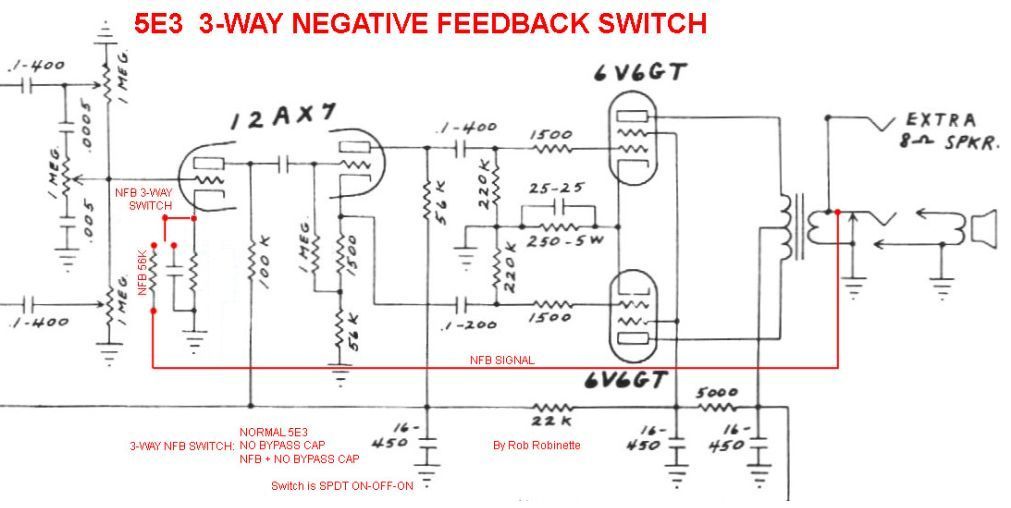
The amp's output signal is tapped at the speaker jack, run through a voltage limiting 56k 1/2 watt NFB resistor and injected at the V2A cathode (pin 3). Thanks to Tony Bones for the corrected schematic.
If you use effects pedals, especially boost pedals, be sure and check out how the amp works with them and sample the overdrive tone in all 3 switch positions.
Kley's Demo of 3-Way NFB Switch
Kley says "ON-ON-ON switch" but it's really an ON-OFF-ON switch.
To determine the amount of NFB sounded best to me I inserted a 50k ohm linear pot between the speaker jack tip and V2A cathode for testing to vary the feedback resistance to find my sweet spot. I initially left the cathode resistor bypass capacitor in place but I soon realized it soaked up all the feedback. There was very little if any amplification or tone change with a sweep from approximately 22k to 50k.
I carefully clipped the input leg of the bypass cap and tried again. Before trying the feedback pot I listened to the amp with just the clipped cap. It caused a significant drop in gain from the V2A driver which added headroom. I then used alligator clips to insert the feedback pot and tried again. Wow, I was surprised by how much difference the feedback made to the overall tone and playability. After playing around for a while I settled on using a 56k feedback resistor mounted directly to the three-way feedback switch.
The 56k feedback resistor is correct for a speaker output of 8 ohm and will supply a light level of feedback. You can increase the feedback by reducing the feedback resistor value. A 39k resistor will increase the feedback by 41% and a 20k resistor will give you a Marshall JTM45 2.8 times more feedback. The Fender tweed Princeton amp used 22k feedback resistors and the tweed Harvard used a 56k (both with 8 ohm speakers) so feel free to try anything between 20k to 100k with an 8 ohm speaker tap (10k will give more feedback, civility and clean headroom).
If your speaker out is 4 ohms then use a 39k resistor and if your speaker out is a 16 ohm then use a 75k resistor. When changing the feedback source from one output transformer secondary to another you change the feedback resistance by a factor of 1.41 for one step change (for example going from a 2 ohm speaker tap to 4 ohm), a factor of 2 for 2 steps (example 2 ohm to 8 ohm), or a factor of 2.83 for 3 steps (example 2 ohm to 16 ohm).
Speaker Tap and Feedback Levels
|
Speaker Tap |
5F6A Light Feedback |
Moderate |
JTM45 Heavy |
|
2 ohm |
27k 5F6A |
20k |
10k |
|
4 ohm |
39k |
27k |
13k |
|
8 ohm |
56k |
39k |
20k |
|
16 ohm |
75k |
56k |
27k JTM45 |
Moderate is 41% more feedback than Light. Heavy is 2.8 times more feedback than Light.
If your output transformer has multiple outputs and a speaker impedance switch connect the NFB wire to the 8 ohm output on the transformer side of the impedance switch. That way your amp will always get the correct amount of NFB no matter what impedance speaker you are running.
When you do this mod you have a 50/50 chance of having a loud squeal when you power up the amp after the mod.
So be ready to turn the amp off immediately. If your amp does squeal you simply need to swap the output transformer's primary OR secondary wires (don't swap both pairs or you will be in-phase again). The two primary wires (normally brown and blue) run from the output transformer to each power tube's pin 3. If your primary wires are too short or hard to reach you can also just swap the speaker jack wires (output transformer secondary wires) to fix the squeal (yes, it's OK to connect the green wire to ground and the black wire to the speaker jack tip). The squeal is caused by the output transformer and preamp tube V2A being in phase and causing positive feedback. Switching either of the two pairs of wires will make them out-of-phase and give the desired negative feedback.
3-Way Switch: Normal / No Cathode Bypass Cap / Feedback
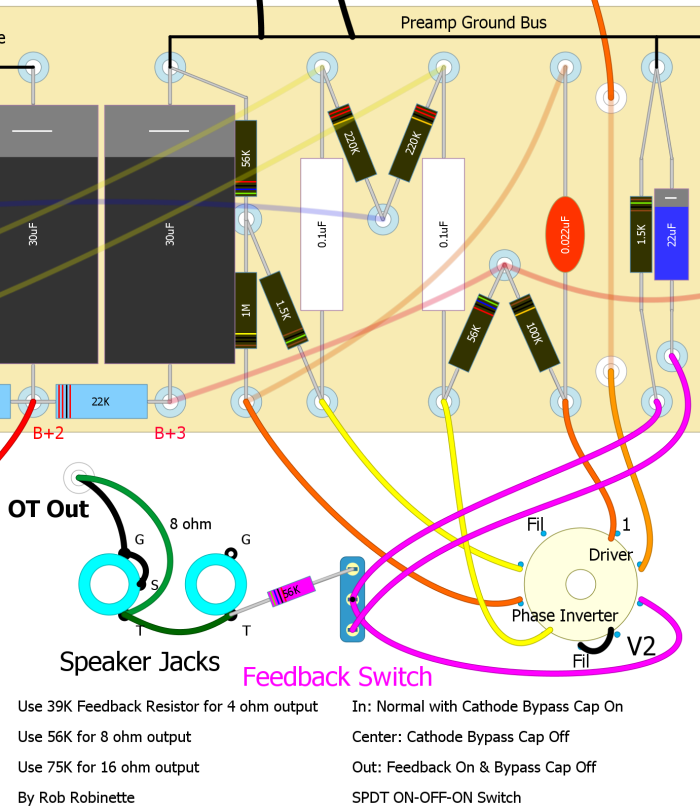
Three-way switch to implement feedback and yet still have the option to switch back to the normal 5E3 configuration of a cathode resistor & a bypass capacitor. Switch is ON-OFF-ON SPDT or DPDT (Single or Dual Post Dual Throw). Feedback signal is tapped from the speaker jack's 'Tip' terminal.
Photo by Mark Herrick.
Feedback Switch With Speaker Impedance Switch
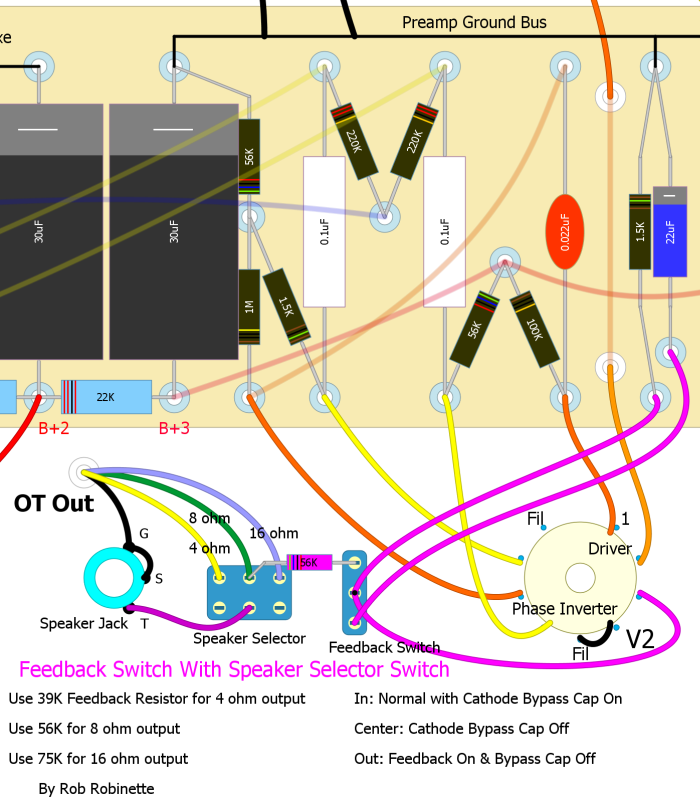
Speaker Selector Switch on left (3-way slide switch) with 56k feedback resistor connected to the switch's 8 ohm input. Do not connect the feedback resistor to the Speaker Switch's output wire or the feedback level will change when the switch changes.
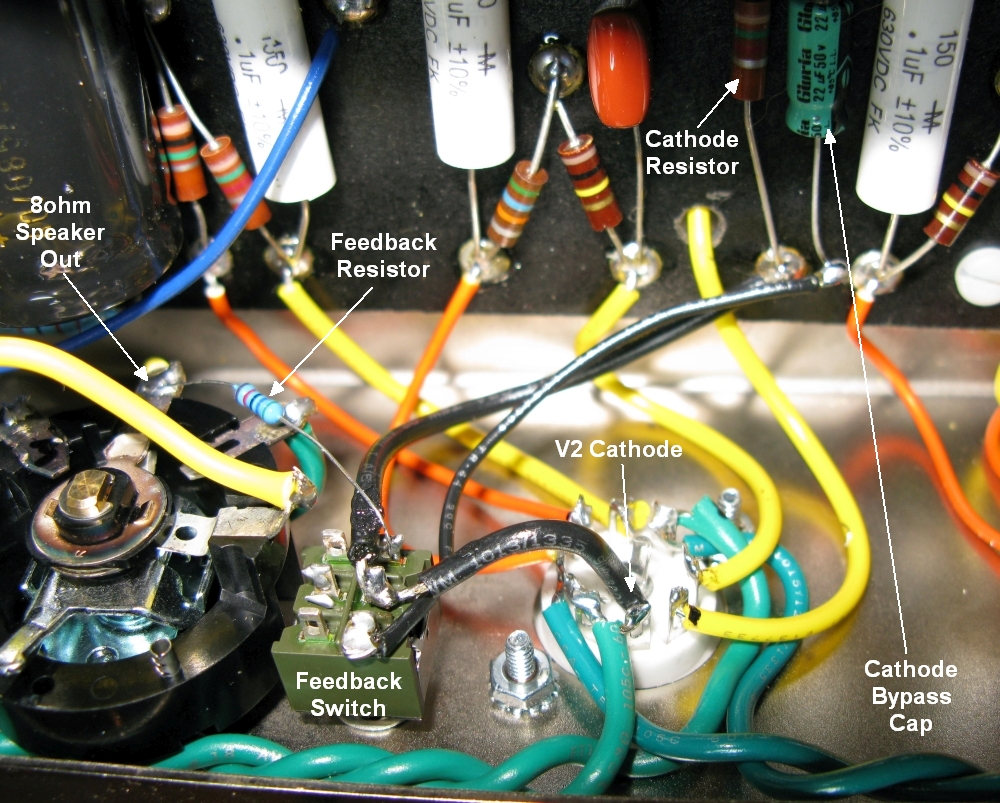
Notice only half of the Dual Post Dual Throw (DPDT) switch is used for the Feedback Switch. A Single Post Dual Throw (SPDT) is all that's required but I had a DPDT on hand. Feedback Switch moves in and out with 'IN' being Normal 5E3. Rotary 3-way speaker impedance selector switch is on the left with the 56k feedback resistor connecting the center 8 ohm input wire.
Here's an excellent demo of a 5E3 with the 3-Way NFB Mod + Lead Channel Mod + TMB Tone Stack that sounds like an AB763 blackface by Kley that shows some of the tones you can add with switchable mods.
Foot Switchable Negative Feedback
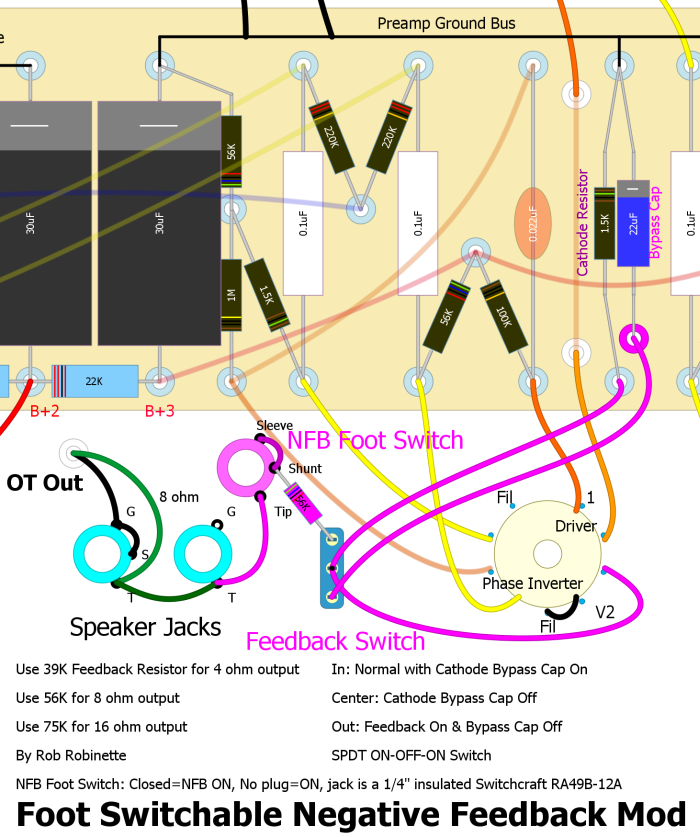
Feedback Switch must be ON for Foot Switch to control Feedback. Footswitch closed = NFB ON and if no plug is inserted NFB = ON (but still controlled by Feedback Switch). The foot switch jack is a Switchcraft RA49B-12A which is insulated from the chassis because all three jack terminals carry the NFB signal. Note the jumper from the Foot Switch jack's Sleeve terminal to the Shunt terminal.
I was very pleasantly surprised by this mod. The three switch positions really change the fundamental flavor of the amp and offers a greatly expanded tonal palate. A 5E3 with feedback does not sound like a 5E3 so it's like having a completely different amp at the flip of a switch. Feedback greatly reduces distortion and adds a lot of clean headroom. It's an easy and I believe very worthwhile modification. With the switch in the 'Normal' position the amp is completely unchanged.
Chassis Switches
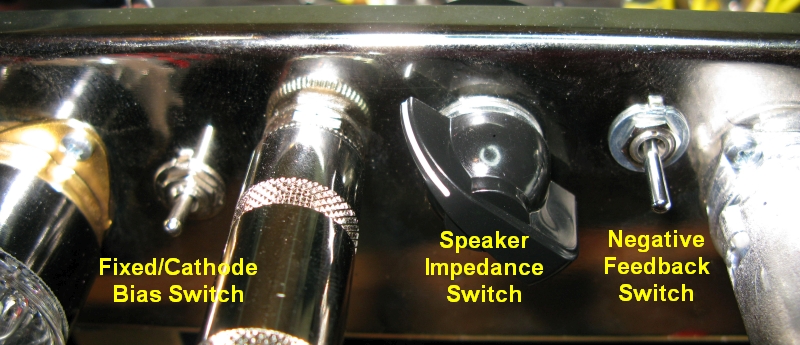
Add a Master Volume
This is my third most favorite mod for the 5E3 (behind the 3-way NFB and Lead Channel mods) and it's even easier than the negative feedback mod above. Adding a Master Volume allows you to crank the Normal and Bright volume controls and get lots of sweet 5E3 preamp overdrive distortion but then lower the overdriven signal with the Master Volume as it flows into the power tubes to keep the output volume low for low volume high distortion output. It's a great mod for low volume practice and with a boost pedal and you can really make your preamp tubes scream for mercy at low volume.
With the 5E3 you can put the Master Volume before or after the phase inverter (tube V2B) with good effect because the 5E3's cathodyne phase inverter puts out approximately unity gain (no actual gain) which means it doesn't amplify the signal so the Master Volume can go before or after it. Placing the Master Volume before the phase inverter (PRE Phase Inverter Master Volume) will allow you to control the amount of the 5E3's infamous phase inverter overdrive 'double frequency' distortion at high volume levels or when using pedals that boost the input signal. Preventing the phase inverter from going into extreme frequency doubling distortion can result in a much sweeter, tastier overdrive tone. Phase inverter double frequency blocking distortion is the reason why high gain modifications to the 5E3 are not popular (see my Cascaded High Gain Channel Mod below). With a PRE Phase Inverter Master Volume you can easily dial in how much phase inverter distortion gets through to the power tubes. If you want to drive a 5E3 hard with hot pickups or effects then the Pre Phase Inverter Master Volume will serve you well. It will make the 5E3 much more pedal friendly because the 5E3's phase inverter distortion can make a mess of reverb, delay and boost effects.
PRE PI Master Volume Schematic
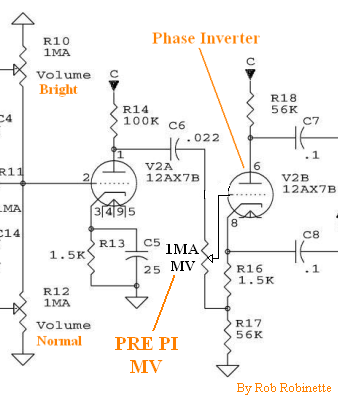
You simply replace the phase inverter's 1M grid leak resistor with a 1MA pot. Although there's DC voltage on the pot there's only 1.5 volts across the pot so normally the pot isn't scratchy.
Your other option is placing the Master Volume after the phase inverter (Post Phase Inverter Master Volume or PPIMV) which allows the phase inverter to add overdrive distortion as usual and keep the overdrive tone truer to the classic 'tweed Deluxe' tone. Placing the MV after the phase inverter is the standard location for most amps because most other amps use the long tail pair (LTP) phase inverter which is a true gain stage. Having the master volume after the PI is more effective for controlling output volume in amps with long tail pair phase inverters but adds nothing to the 5E3.
Depending upon where you put your master volume pot you may have to use shielded cable to prevent noise or oscillation. You definitely need to use shielded wire if you put the master volume in place of the standby switch due to the noisy AC in that end of the chassis. The longer the wire run the more benefit from using shielded cable. I use RG174 when I need single conductor shielded coax wire in an amp. For multiconductor runs like the master volume shown below I use Canare L-4E5C Mini-Star-Quad Microphone Cable. Only ground one end of any shielded cable in an amp, preferably the signal input end, to keep from forming a ground loop. If you keep your wire runs short and away from the power transformer end of the chassis you'll probably be fine with non-shielded wire.
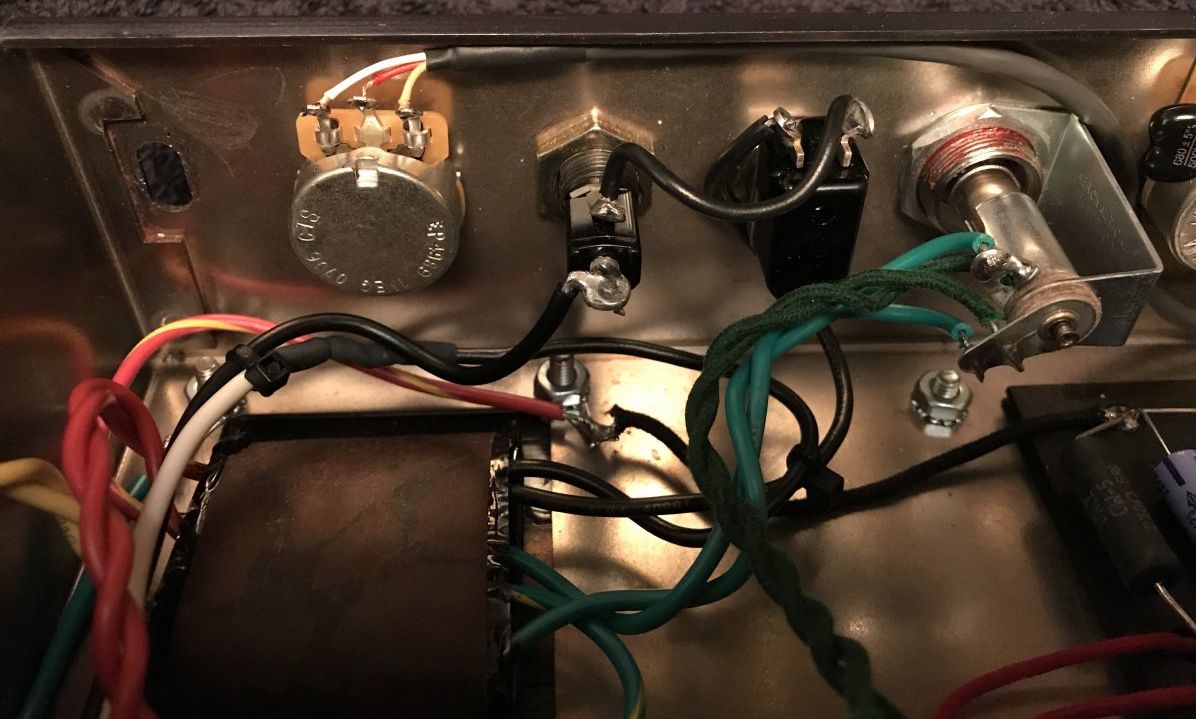
Pre Phase Inverter Master Volume in the standby switch hole. Notice how multiconductor shielded cable is used to keep AC noise out from the power transformer and power lines. The cable shield is grounded only at the preamp end to prevent a ground loop. Photo by Mark Herrick.
Removing one of the 'Lo' input jacks can make room for a master volume pot and you won't have to drill a new hole in the chassis. The 'Lo' jacks simply dump half the guitar signal to ground and you can do the same thing using your guitar volume control. I recommend you remove the Normal Lo jack (see layout below). Just clip the wire that runs from the Lo jack to the 68k resistor on the circuit board. Clip it at the jack end and solder it to the top of the Normal HI jack's 68k resistor. Connecting it this way will keep the Hi jack's grid stopper resistance at 34k (68K parallel).
Remove Normal Lo Jack
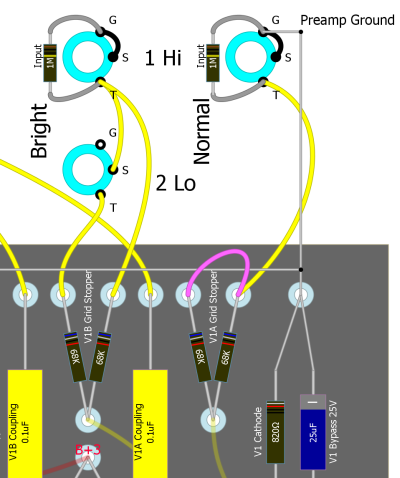
You could also use the second speaker jack hole for a master volume pot. There is also room between the input jacks and volume control for a Master Volume pot. Another option is placing the pot between the preamp tubes.
PRE Phase Inverter Master Volume
The PRE Phase Inverter Master Volume requires only a standard 1 megaohm audio (log) pot. Running the long wire from the Master Volume pin 2 to the tube socket under the circuit board can minimize noise by keeping the wire close to the metal chassis. Note the 1M grid leak resistor has been removed (or one leg clipped) from the circuit board. Don't forget to clip or remove the 1M grid leak resistor (in pink at far left of layout above)
The PRE Phase Inverter Master Volume is my recommended master volume modification for the 5E3. The mod simply replaces the phase inverter's (V2A) 1M grid leak resistor with a 1M log or audio pot. With the Master Volume full up the 5E3 circuit is completely normal--it's as if the MV isn't there so it won't change your amp until you dial down the volume. It also allows you to dial out nasty 'double frequency' phase inverter blocking distortion, control the balance between preamp and power tube distortion and of course practice with dirt at lower volume--especially when paired with a boost pedal.
Doing the Mod
Start by checking the voltage at the first filter capacitor to ensure it's below 50V. If it's higher than that drain the caps by shorting the tube side of either V1 100K load resistor to ground.
Next determine the location of your master volume pot. Solder the lead wires and optional bright cap to the pot before installation. Install the pot.
Remove the wire that runs from the 1M grid leak resistor to V2 pin 7. You can just clip it at the resistor but you should de-solder it from the tube socket.
You do not have to remove the under board wire that runs from the top of the 0.022uF cap to the 1M grid leak resistor (wire shown in light orange in layout above) just clip either leg of the 1M resistor and bend it up slightly so it won't make contact with anything. If you clip it right at a solder joint it will be easy to reverse the mod at a later date. Of course you can remove the resistor if you prefer.
Connect the pot's three wires as shown in the above layout.
Be sure and try the Master Volume dialed down about 1/8 of a turn so you can hear your overdrive tone with excess phase inverter distortion dialed out. Same goes for reverb and delay effects.
PRE PI Master Volume With Volume Between Preamp Tubes
This is what I ended up doing because I have a 'High Gain Cascade Channel' mini switch between the input jacks and the volume knob. This layout makes for very short wire runs. The 0.022uF capacitor was clipped at the top and bent down to connect to the Master Volume pot pin 3.
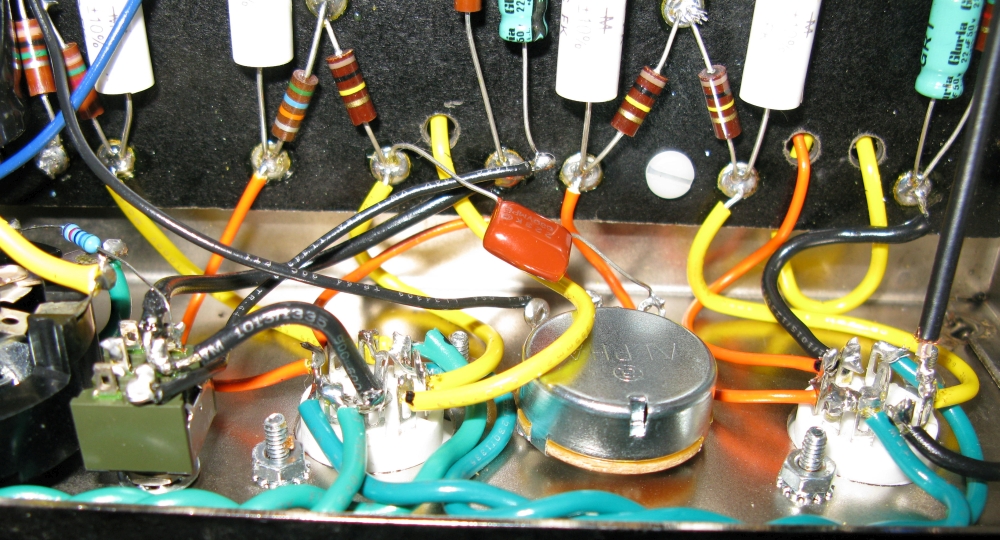
Master Volume pot placed between V1 and V2.
I like to leave the Master Volume turned down a little even when I want full volume because it adds some phase inverter grid stopper resistance which eliminates nasty sounding phase inverter blocking 'double frequency' distortion.
Simple But Effective Trainwreck Type-3 Post Phase Inverter Master Volume (PPIMV)
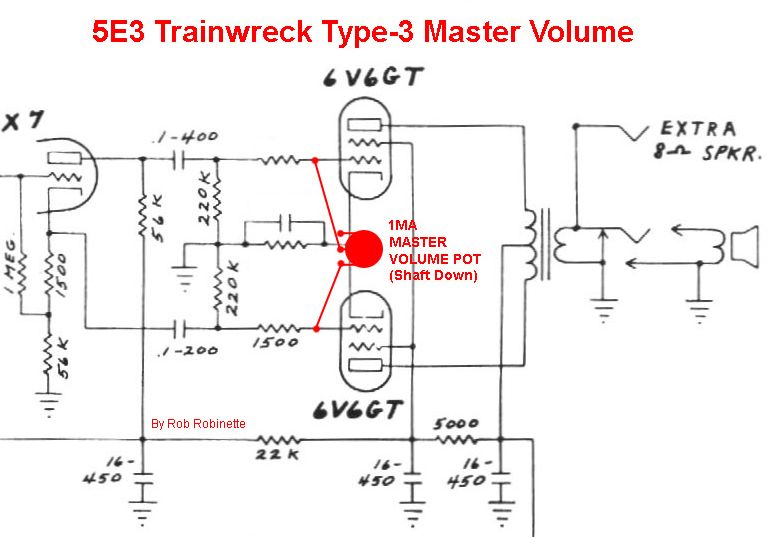
Add a 1 megaohm audio (log) pot and two wires and you've got an effective post phase inverter Master Volume. As you turn the Master Volume pot down (counterclockwise, pot is shown shaft down) more of the opposite phase signals from the phase inverter are mixed together which cancels the signal out. I did this mod to my 5F6A Bassman and it works great.
Modifications above are shown in green.
If you are anal you can completely eliminate the Type-3 from the amp circuit by adding a switch to disconnect the circuit. Use a 1MA pot with a push-pull DPDT switch and wire one leg of the master volume through the switch so when the master volume knob is down the circuit is completely disconnected. Pull the knob up to activate the master volume. To do this you would run the wire from the #1 (left) pot terminal to the upper left DPDT switch terminal, then run a wire from the middle left DPDT switch terminal to the circuit board's left 220k resistor. The wire from the #2 (wiper) pot terminal would be wired as normal to the left 220k resistor (see layout below).
Type-3 With MV ON/OFF Push-Pull Pot
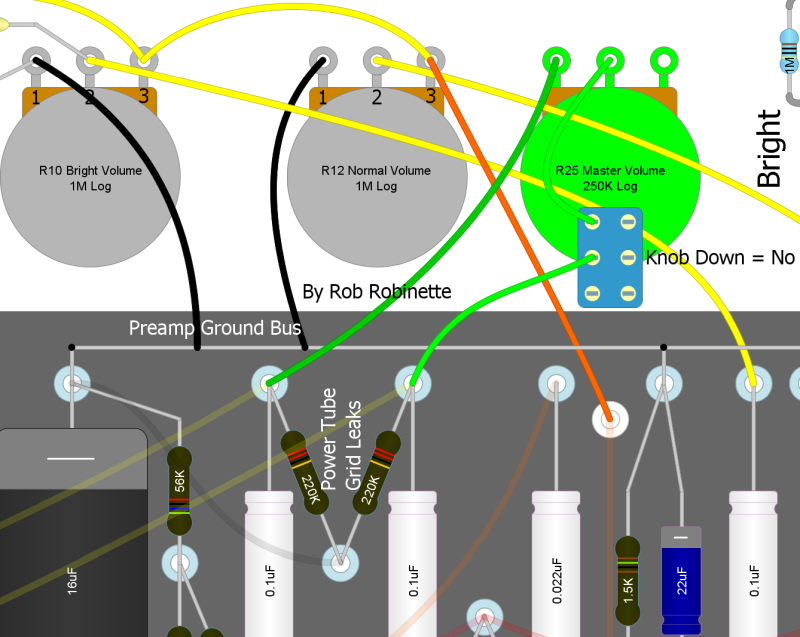
Master Volume knob Down = no master volume at all, Up = master volume on.
Master Volume + Vox Cut Control
I'm a big fan of the VOX style Cut Control because it's a great way to "trim the ice pick". Early in-the-circuit tone controls affect the substance of the overdrive tone. High freqs generate overdrive harmonics that fill in the top end. If you turn down a normal tone control to reduce ice-pick highs you'll kill all the harmonics too. A cut control allows you to trim off very high ice pick highs without removing all the high frequency overdrive harmonics. All high gain amps should have early and late tone controls for this reason. You can just leave the cut control on full high and you have a normal amp circuit.
The Vox Cut Control connects the two power tube grids with a 220k audio pot and 4.7nF (.0047uF) capacitor to allow variable high end cut. In a push-pull amp the guitar audio signals on the two power tube grids are 180 degrees out of phase with one another so mixing them together nullifies the signal, kind of like mixing matter and antimatter. The capacitor limits the effect to high frequencies but if you jumper around the cap the pot becomes a Trainwreck Type-3 Master Volume.
I like this very late tone tweak because it pairs well with an early tone control or stack. Use the early tone control to get the overdrive tone and substance you want then use the Cut Control to fine tune the tone. The Cut Control affects only the power tubes.
Wire the cut pot as a variable resistor so that as you turn the knob up (clockwise) resistance increases. Up = more resistance = brighter tone.
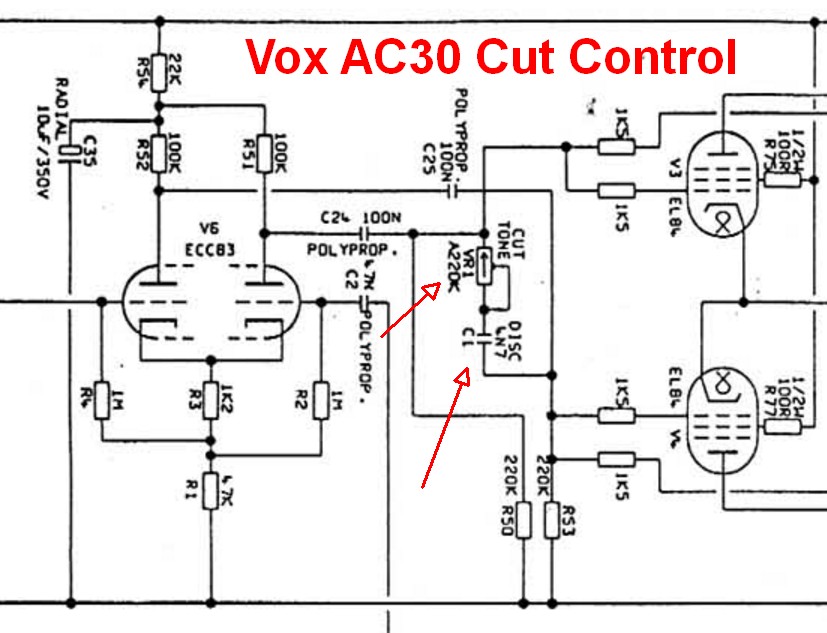
220KA or 250KA pot (audio pot wired as variable resistor) and .0047uF 200v cap connect the two phase inverter outputs.
Master Volume + Cut Control on 5F6A Bassman
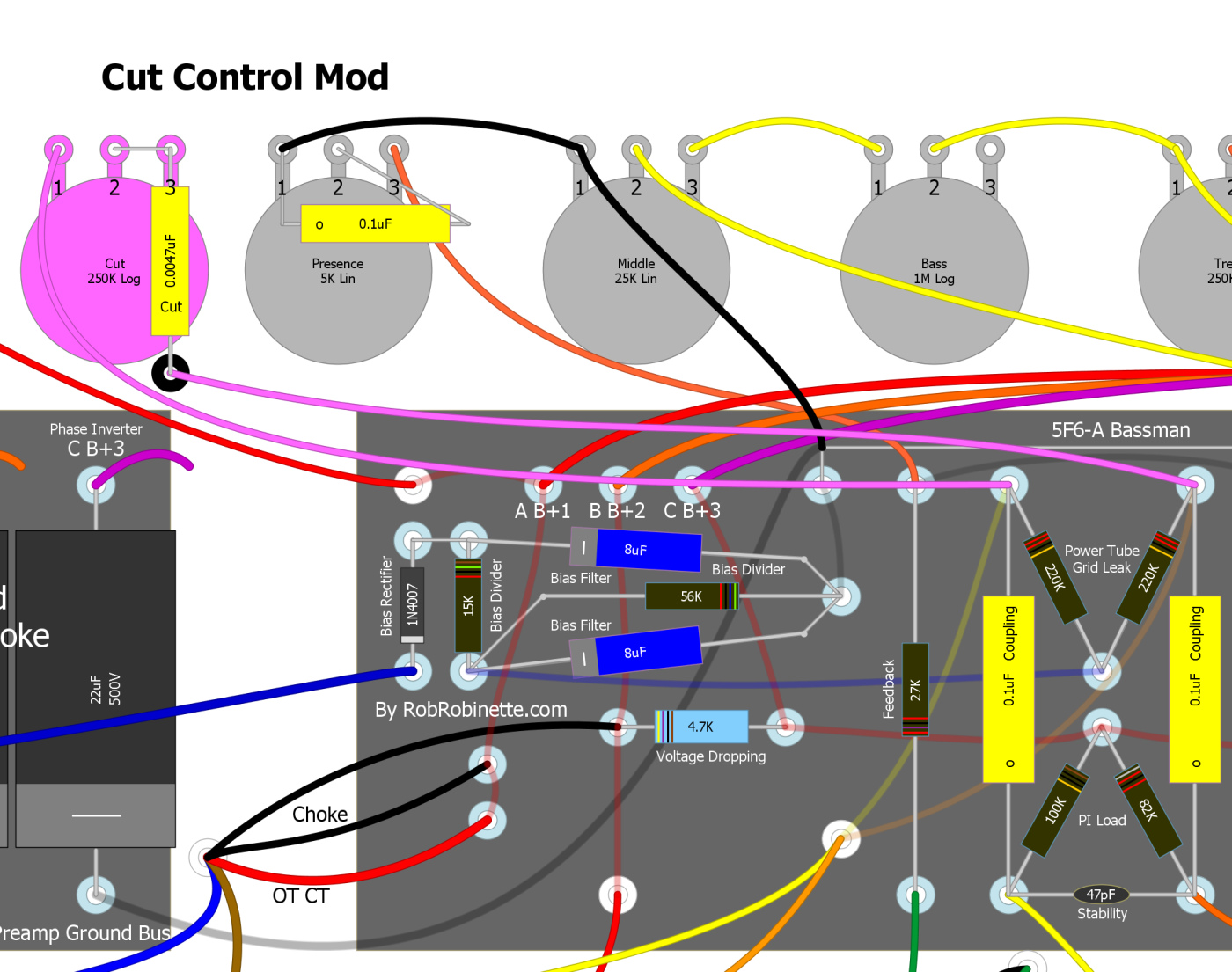
The Cut Control is shown on a 5F6A but the mod is identical on a 5E3. The .0047uF Cut Cap can be supported by a non-grounded terminal strip. You can turn a Cut Control into a Trainwreck Type 3 Master Volume by simply jumpering around the Cut Cap. An optional Master/Cut switch is mounted next to the Cut Pot. It is a SPST mini-switch. Close the switch for a Master Volume and open the switch for a Cut Control. If you don't want the Master/Cut Switch simply delete it and you'll have a normal Cut Control.
5E3 With the Post Phase Inverter Master Volume Mod
This is a traditional and complex post-phase inverter master volume using a dual gang volume pot (one shaft turns both volume wipers). This master volume simply inserts two volume controls between the phase inverter and power tubes. You must connect the two signal paths like the layout above so either use different color wire for the two signal paths or mark them. If you mix up the in and outs of the channels you will get high pitched oscillation noise. One signal goes in pin 3 and out pin 2; the other signal goes in pin 6 and out pin 5.
Standard Unmodified 5E3
Unmodified 5E3 shown here for comparison.
Phase Inverter Grid Stopper Resistor
Add a 470KΩ 1/2 watt grid stopper resistor to the V2B phase inverter (V2 pin 7) to smooth out its overdrive. I recommend this mod be done to all 5E3 amps. It won't affect the amp's clean tone but it will keep the overdrive tone sweet when pushed hard. Actually this is a good mod for any guitar amplifier that uses a cathodyne phase inverter like the 5E3.
High volume settings or using boost, delay or reverb pedals can push the phase inverter into extreme and odd sounding 'double frequency' blocking distortion. This unpleasant distortion is the reason why the 5E3 is known as not being pedal friendly and why high gain preamp mods are not popular--any boost in preamp output can push the phase inverter into nasty distortion. By adding this resistor the 5E3's sweet preamp tube distortion won't get chopped up in the phase inverter.
An added 470k grid stopper slows the charge rate of the coupling cap that's upstream of the phase inverter. Slowing the recharge time reduces blocking distortion.
I believe a better solution to the phase inverter distortion problem is to forget the grid stopper mod and simply replace the 1M grid leak resistor with a 1MA pot to create a PRE Phase Inverter Master Volume pot which will allow you to fine tune the grid stopper & grid leak resistor sizes to really control phase inverter distortion. By turning down the master volume by about 1/3 you do the same thing as adding a 470k grid stopper and 470k grid leak to the phase inverter. The nice thing about this master volume is when it's set a max the 5E3 circuit is unchanged from stock.
Phase Inverter Grid Stopper Resistor Mod
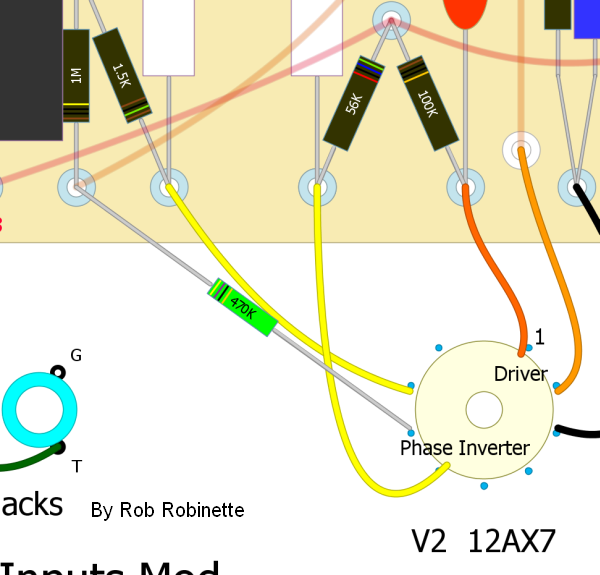
470K resistor added to the phase inverter input to reduce odd sounding double frequency phase inverter overdrive distortion.
'Sweet Pot' Variable PI Grid Stopper Resistor Mod
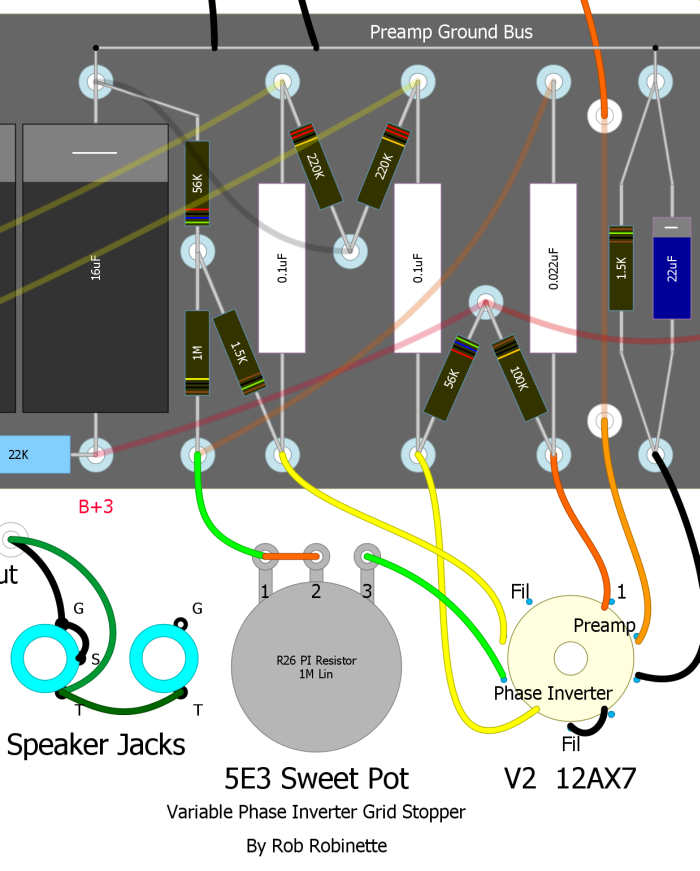
The 'Sweet Pot' allows you to vary the phase inverter's grid stopper resistor value. At 'Max Sweet Pot Volume' you have the standard 5E3 circuit with no phase inverter grid stopper resistor but you can dial out phase inverter distortion by turning down the 'Sweet Pot Volume' (counterclockwise) by adding grid stopper resistance up to 1 mega Ω.
6L6 & EL34 Power Tube Upgrade
The 5E3 uses two 6V6GT power tubes but the very similar Fender 'Pro' 5E5 amplifier uses two 6L6GB tubes. We can use the 5E5 as a modification roadmap to use 6L6 and EL34 tubes.
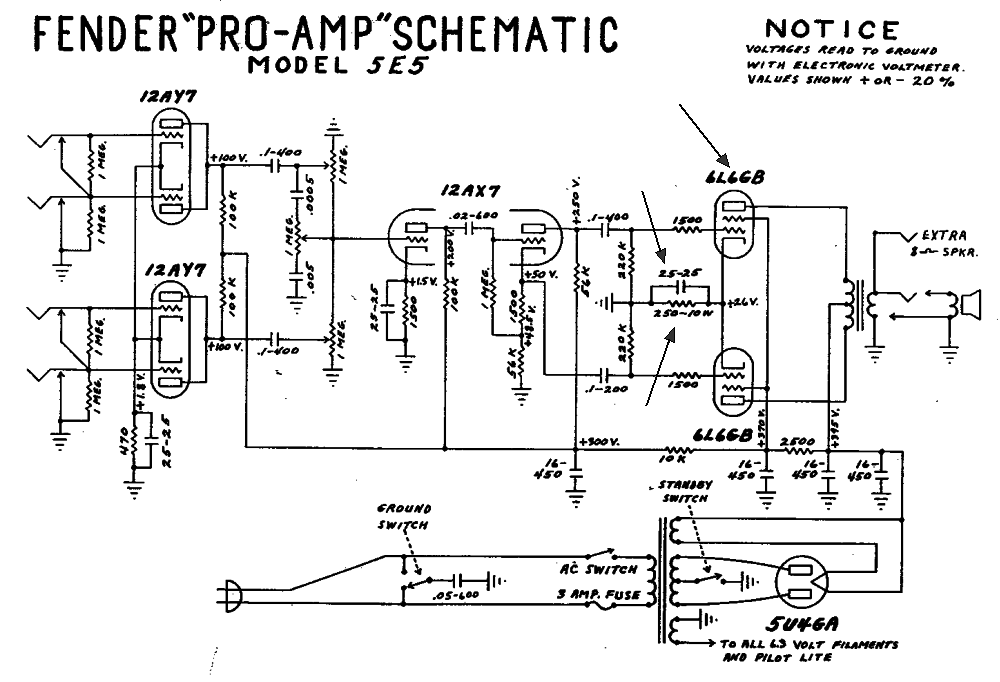
After this mod you will be able to switch between 6V6 and 6L6 tubes simply by swapping out the power tube and rectifier but there are some pros and cons to this mod. To get the most out of a 6L6 it needs higher B+ voltage than a 6V6 and more current output from the power transformer. But if you build the amp with a bigger power tranny then the 6V6 loses a lot of voltage sag so it sounds stiffer and punchier with a noticeably tighter low end (sounds more solid state and less tubey).
Same thing with the output transformer. It needs a higher current rating so it won't just saturate at 6V6 levels (more 6L6 output current = more saturation and compression with no more volume). But then a 6V6 loses it's compression and sounds more dynamic and solid state with a larger output transformer.
If the amp has a multi-tap output transformer (and all amps designed to run 6V6 or 6L6 should have them) most of the output tranny impedance mismatch can be handled by using a one step higher speaker impedance setting -- if the amp is designed for 6V6 then set the impedance selector to 16 ohms with an 8 ohm speaker (or 4 ohm speaker with 8 ohm selected).
A 6L6 can also benefit from a hotter bias from a smaller value cathode resistor. You can run another 250 ohm 5 watt power tube cathode resistor and switch it parallel for a 6V6/6L6 switch.
Installing a Webber Copper Cap style solid state rectifier will give the 5E3 about 60 more B+ volts to help the big 6L6 power tubes breathe. The Copper Cap simply plugs into the rectifier tube socket. Rectifier voltage sag will also be eliminated which is good for the 6L6.
The main reason to run a 6L6 is to get a slightly different clean and overdrive tone because you'll actually get a little less max power tube distortion because the big bottle power tubes need more signal on their grid to drive them into overdrive.
If you're building a new amp then consider building the Weber 5E3P Proluxe which features these upgrades: power transformer with 50 volt fixed bias output, a 35 watt output transformer, 6L6 power tubes, bigger filter caps and a fixed bias circuit. BootHillAmps.com also offers a Proluxe kit. To upgrade an existing 5E3 to 6L6 power tubes you will need at a minimum an upgraded output transformer, rectifier tube and cathode resistor and bypass capacitor. Higher capacity filter capacitors while not mandatory will help power the big tubes too.
Click on the image to see the full size layout. The Proluxe features 6L6 tubes and fixed bias.
To run 6L6, 5881 and EL34 power tubes long term your 5E3 will need the following changes:
The 5E3's 250 ohm 5 watt cathode resistor needs to be bumped up to 250 ohm 10 watt to handle the higher output 6L6 tubes.
The cathode bypass capacitor needs to be bumped up to a 25uF 50 volt cap.
You can run 6L6 tubes at standard 5E3 voltages but they prefer higher B+ voltages so a Weber Copper Cap or GZ34 rectifier tube works well. I'm a fan of the JJ GZ34S.
You can run 6L6 tubes with the standard complement of filter capacitors but the 6L6's extra current demands will generate more voltage sag than a normal 5E3. The 5E5 Pro uses four 16uF filter capacitors and the Weber Proluxe uses three 40uF 650v caps.
It's not mandatory but you should also consider upgrading both your power and output transformers for 6L6 operation. I really like the Allen Amps TP40D power transformer and TO26 output transformers for 6V6/6L6 operation:
The TP40D's Power Transformer specs: Upgrade power transformer for Deluxe/Deluxe Reverb amps. 320V-0-320V at 180ma, 5V at 3A and 6.3V at 4.5A. Supports the use of 6L6 AND EL34 power tubes (*power tube sockets must be rewired for use with EL34 power tubes). Center tapped heater winding, 50V bias tap, copper flux bands and internal hum shield brought out to a lead for grounding (ensures the quietest amp possible). 2-1/4" by 2-13/16" mounting centers. Unit is approximately 3/4" taller than a stock PT and weighs 6.7 lbs. Great for high powered 5E3 projects, too.
This power transformer will easily power EL34 tubes and the 50 volt bias supply will give you the option to install a fixed bias circuit for more output and punch. Check out my switched Fixed/Cathode Bias mod.
The TO26's Output Transformer specs: A beefier output transformer with 50% more core steel for Deluxe™, Deluxe Reverb™ and similar 2x6V6 based amps bolts right in with the standard 3-1/8" mounting centers and has both 8 and 16 ohm taps for single and dual 8 ohm speaker configurations. Custom wound exclusively for Allen Amplification and made in the USA by Heyboer this unit features a special high performance core steel for maximum output and clean bass. 7,000 ohm primary to 8 or 16 ohms. Also works great with a 2x6L6 or 2xEL34 amp (with 4 or 8 ohm speaker) where the intention is to limit the output with core saturation for natural compression and sustain. Low profile "fat" design to clear the speaker in combo amps. Excellent choice for 18W Marshall and similar 2xEL84 amps, too. Paper tube, paper-layered and specially interleaved windings, cool black oxide finish and 12" pretinned Unistrand leads for fast installation. Stainless-steel mounting hardware is included! 2-1/4"H by 2-1/2"W and 1.6lbs.
Note that because of the difference between 6V6 and 6L6 output impedance differences (6V6 & EL84 ≈ 6-8k, 6L6 & EL34 ≈ 5-7k, KT88 ≈ 4-5k), if your output transformer is made for 6V6 power tubes like the TO26 you have to make an output impedance adjustment to get the most out of 6L6 or EL34 tubes. For 6L6 or EL34 tubes and an 8 ohm speaker you would use the 16 ohm speaker tap. For a 4 ohm speaker you would use the 8 ohm speaker tap.
If your output transformer is made for 6L6 or EL34 power tubes you would do the opposite. When using 6V6 tubes and a 16 ohm speaker you would use the 8 ohm speaker tap. When using an 8 ohm speaker you would need to use a 4 ohm speaker tap.
To run EL34, KT66, KT77 and KT88 tubes you will need a power transformer with at least 4 amps of 6.3v heater current like the TP40D mentioned above.
To run EL34's you will also need to add a jumper to the power tube sockets' between pins 1 and 8 to tie the suppressor grid to the cathode. This has no effect on 6L6 or 6V6 tubes because their cathode and suppressor grids are connected internally. Adding the jumper simply allows you to run EL34 tubes.
EL34 Jumper
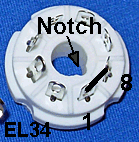
Jumper soldered between pins 1 and 8 to tie EL34 suppressor grid to the cathode. The jumper has no effect on 6L6, 6V6 or KTxx tubes.
Since the EL34 is a true pentode it will flow more screen current than the other tubes mentioned above so I recommend adding 1.5k 5 watt power tube screen resistors to control screen current and protect the EL34s during overdrive.
Screen Resistors Added to Power Tubes
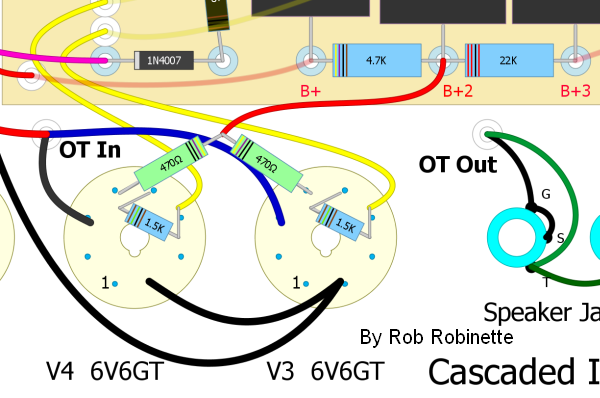
Although 470 ohm screen resistors are shown in the layout above, for EL34 tubes you should run 1k to 2.2k 5 watt screen resistors.
Switchable Bias: Fixed Bias / Cathode Bias
The 5E3 uses two 6V6GT tubes and a cathode resistor to bias the power tubes. I installed a 2-way toggle switch on my 5E3 to flip between fixed and cathode bias. It already had the Proluxe mod which features these upgrades: power transformer with 50 volt fixed bias output, a 35 watt output transformer, 6L6 power tubes, bigger filter caps and a fixed bias circuit.
You will need a 50 volt AC power source to power the fixed bias circuit. You can either upgrade your power transformer to one with a 50v tap, add a separate 50v transformer ($20) or tap the high voltage circuit. I really like the Allen Amps TP40D power transformer which comes with the 50v bias tap. If you go with a separate 50v transformer it should have two secondary output wires. Ground one of them and run the other one to the bias rectifier diode.
The fixed bias circuit is made up of one 1N4007 rectifier diode, one 1k 1/2 watt resistor, one 27k 1/2 watt resistor, a 50k linear pot and a 50uF 150v filter capacitor (see left end of the circuit board in the layout diagram below).
Note the orientation of the diode's stripe--it must be toward the power transformer to supply negative voltage. The filter capacitor also needs to have it's + positive lead connected to ground because of the negative voltage of the bias supply.
With this bias switch it's like having two different amps. You can run the amp in standard 5E3 cathode bias and flip the switch to brownface Deluxe 6G3 fixed bias for more volume and punch and a more modern, dynamic (less compressed) tone. If you haven't built your 5E3 yet then consider ordering it from BootHillAmps.com or Weber with the Proluxe fixed bias option and all you have to do is add the following Bias Switch Mod. With the Proluxe 6L6 upgrade and bias switch it's like having four different amps. By simply swapping out the rectifier and power tubes and flipping the bias switch I can go from 5E3 Deluxe (6V6 cathode bias) to 6G3 brown face Deluxe (6V6 fixed bias) to 5E5 Pro (6L6 cathode bias) to 5E5-A Pro (6L6 with high power fixed bias).
Fixed bias tends to sound cleaner and punchier, especially the lows and it develops more power than cathode bias. Cathode bias is known for sounding 'tubey', warm and compressed due to its fluctuating bias. The Fender 5E5 Pro uses a 250 ohm 10 watt cathode resistor so I went with the same. The Pro comes with a 25µF 25 volt cathode bypass capacitor which simply parallels the 250 ohm cathode resistor to boost gain. I tried the cathode resistor unbypassed so I would get more 'cathode bias effect' and make the tone more distinct from the fixed bias mode. I ended up with a nasty sparky distortion when I pushed the power tubes. In desperation I clipped on a 25µF 50 volt bypass cap and the noise went away. I recommend a 25µF 50 volt cap (rather than the factory 25 volt) because the voltage drop across the cathode resistor can easily exceed 25 volts.
The toughest part of this mod is lifting the circuit board to remove the ground wire connected to the two 220k power tube grid leak resistors. If you haven't built your 5E3 yet consider running the ground wire above the circuit board for access for future mods.
You can avoid removing the old under board ground wire by disconnecting both 220k power tube grid stopper resistors from their shared lower turret. Then use insulated 20 to 24 gauge solid core wire (solid so it will stay in place) to run from the ground bus to the disconnected resistor turret. Put two wire wraps around the turret. The wire insulation needs to be on the wire for the turret wrap to keep the wire isolated from the turret. Then solder the resistors to the end of the wire. Make sure the resistor leads do not make contact with the turret.
See this for instructions on setting the fixed bias.
Bias switch at bottom center. The 250 ohm 10 watt resistor and 25uF 50V capacitor are mounted directly to the switch. DPDT ON-ON mini-toggle switch selects either fixed bias or cathode bias. Click on any of the layout diagrams on this page to see the full size image.
Bias Switch Detail
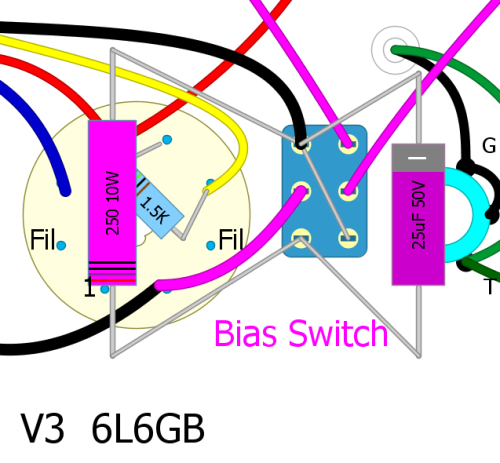
Solder the resistor, capacitor, diagonal jumper and wire leads before you install the switch in the chassis.
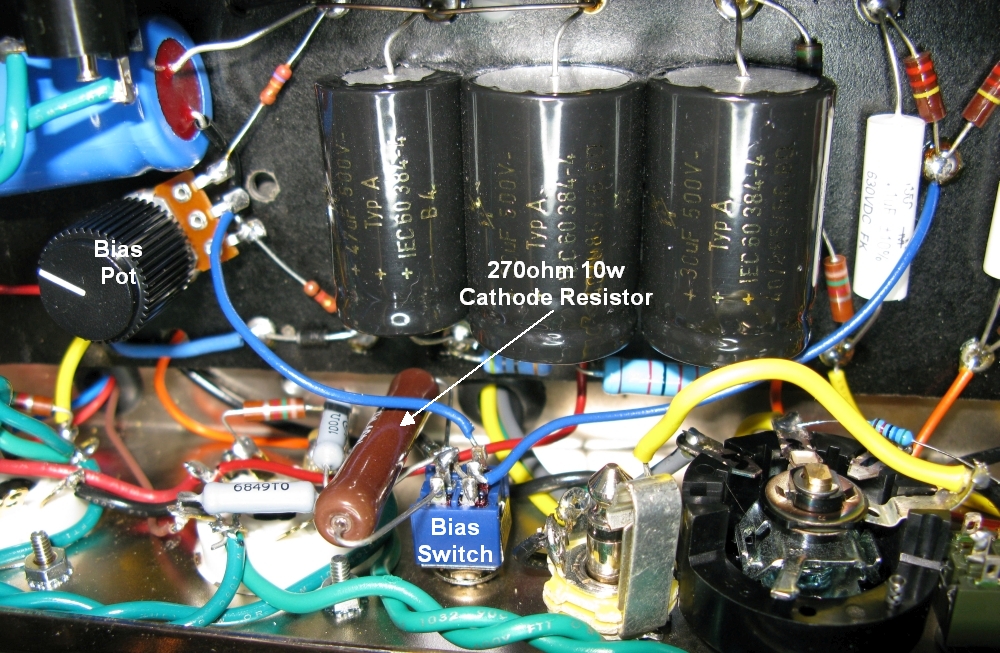
Caption says 270 ohm 10 watt resistor but I recommend you stick with what the Fender Pro amp came with which was a 250 ohm 10 watt cathode resistor. I later added a 50uF 50V cathode bypass capacitor to solve a nasty noise issue.
High Voltage Tap Adjustable Bias
You can use this circuit loosely based on the JCM 800 to create an adjustable bias tap without using a power transformer with a dedicated 50v bias tap. You tap high voltage AC from the rectifier tube and create an adjustable bias circuit. This is a universal circuit that can be used on pretty much any amp. Turning the bias pot clockwise will make the bias hotter (more plate current). A 50k linear pot or trim pot offers lots of adjustment range so this circuit can bias everything from the 6V6GT to KT88's and it isn't picky about the AC input voltage level.
Note the two 25uF 100 volt filter caps have their + terminals connected to ground because the circuit is dealing with negative voltage. Be sure and get the 1N4007 diode's polarity right with its stripe facing the rectifier. The bias pot is shown shaft up. All resistors are 1/2 watt rated. The black wire at the top goes to ground. The blue wire at bottom right carries bias voltage out to the power tube grid leak resistors.
The two filter caps can be anything from 25uF and up, and 100 volts and up. Personally I like to use 100uF 100v caps for the bias circuit. For the bias pot you can use a normal type pot, a screwdriver slot pot or a trim pot.
How It Works
High voltage AC from the power transformer enters the circuit at the 220k voltage dropping resistor. The diode acts as a half-wave inverter creating 60Hz pulsed negative voltage DC (simply turning the diode around would give you positive voltage). The pulsing negative DC is filtered by the two 50uF filter caps and 15k resistor. The caps and resistor form an RC (resistance capacitance) low pass filter to smooth the DC and remove the 60Hz ripple current. The bias pot + 27k resistor form a variable resistor that when combined with the 15k resistor create a variable voltage divider. Lowering the bias pot resistance sends more voltage to ground which moves the output DC bias voltage on the grids closer to 0 volts which allows more power tube bias current to flow making the bias hotter.
JCM800 Bias Circuit
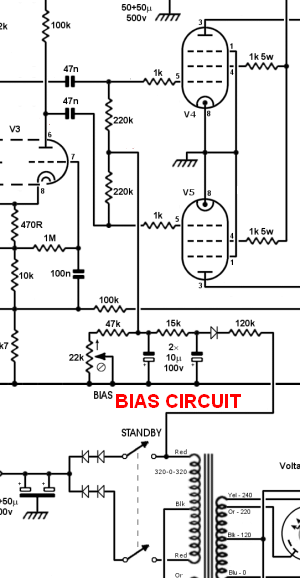
My circuit's values have been modified to make it a more universal circuit.
Cathode Bias Switch
This is a way to adjust a cathode biased amp's cathode bias level. A 3-way SPDT ON/OFF/ON switch can offer three levels of cathode bias to tweak the power tube's tone.
In the center position only the 510 ohm 5 watt resistor is used for cathode resistance for the coldest bias. In the left position the 2k 5w and 510 ohm resistors are paralleled to give 406 ohms for a moderate bias. In the right position the 470 ohm 5w and 510 ohm resistors are paralleled for 244 ohms for a close to standard 5E3 Deluxe bias level which would be around 98% of max dissipation with 100% being the upper safe limit.
You can alter the resistor values to work with 6L6 tubes by bumping the wattage up to 10 watts for all three resistors and bump the bypass cap's voltage rating up to 50v.
The 3-way switch allows you to set three levels of power tube cathode bias.
Fixed and Cathode Bias Measurements
With the ability to switch between fixed bias and standard 5E3 cathode bias I measured the amp bias with both 6V6GT and Tung Sol 5881 reissue tubes.
270 ohm Cathode Resistor is shared between both power tubes. The 5E3 and 5E5 Pro both used 250 ohm cathode resistors--I bumped it up a little in an attempt to compensate for higher modern supply voltages (after trying the 270 ohm resistor I recommend you go with a 250 ohm).
Groove Tubes GT5U4 rectifier tube
Tung Sol 6V6GT Reissue
12 watts max dissipation
Cathode Bias
408v B+1
381v Plate to Cathode
24.1v Drop across the Cathode Resistor
89.3ma Total Cathode current, 84.8ma Total Plate current, 42.4ma per tube:
Gives 16.2 watts dissipation and 135% of max (extremely high! For cathode biased amps 100% of max is the upper limit)
I also measured the cathode current using the transformer shunt method
V3 40.8ma Plate current:
Gives 14.8 watts dissipation and 139% of max (extremely high!)
V4 38.9ma Plate current:
Gives 14.1 watts dissipation and 132% of max (extremely high!)
My B+1 voltage at 408v is just too high to safely run 6V6GT tubes with a GZ34 rectifier tube and the fixed bias selected. I can flip the bias switch and run the 6V6GT in fixed bias mode and adjust the grid bias voltage for an acceptable dissipation value but the tube is not running anywhere near its sweet spot with the B+1 so high. Using a 5Y3 rectifier tube will drop the B+1 voltage low enough to safely run 6V6GT tubes. You can easily switch the power tubes and rectifier out to go back and forth from 6V6GT and 6L6 tubes. You don't even have to re-bias in the cathode bias mode.
Tung Sol 5881 Reissue
26 watts max dissipation
Cathode Bias
395v B+1
363v Plate voltage (actually measured plate to cathode)
28.2v Drop across the Cathode Resistor
104.4ma Total Cathode current
Subtract 5.5% for screen current gives 98.7ma Plate current, 49.4ma Plate per tube:
Gives 17.9 watts dissipation and 69% of max
I also measured the cathode current using the transformer shunt method
V3 48.5ma Plate current:
Gives 17.6 watts dissipation and 68% of max
V4 50.2ma Plate current:
Gives 18.2 watts dissipation and 70% of max
Tung Sol 6L6GC
30 watts max dissipation
Cathode Bias
410v B+1
380v Plate voltage (actually measured plate to cathode)
29.8v Drop across the Cathode Resistor
110.4ma Total Cathode current (tube limit is 116ma)
Subtract 5.5% for screen current gives 52.2ma Plate per tube:
Gives 19.8 watts dissipation and 66% of max
Fixed Bias (adjustable)
413v B+1
413v Plate voltage
Fixed Bias voltage was -35v
V3 50.8ma Plate current, 21 watts and 70%
Fender 5E5 Pro Schematic Bias Values
You can calculate the bias Fender set from the factory using the Fender 5E5 Pro amplifier schematic. It used 6L6GB tubes rated for 19 watts max dissipation and a 250 ohm 10w Cathode Resistor. From the schematic: B+ of 395v, 26v across the cathode resistor (1 resistor shared by 2 tubes), plate voltage is 395 - 26 = 369v. Plug that into my bias calculator and you get 49.2ma of plate current, 18.1 watts of dissipation which is 95% of rated max dissipation and comes in under the maximum safe dissipation of 100% for cathode biased amplifiers. Add in modern high wall voltage and the ensuing B+ increase and the bias can easily exceed 100%.
Voice a "Lead" Channel
It's possible to voice one of the 5E3's channels with a more modern, Marshall "Lead" style tone. Remember, the only difference between the Normal and Bright channels is the bright cap on the bright volume pot which bypasses high freqs around the volume pot at low volume levels. At max volume there is no difference between the Normal and Bright channels so voicing one differently is a useful mod.
This mod will tighten up the bass and eliminate the 5E3's "fartiness" on one channel and make it much more pedal friendly. Modifying only the first gain stage removes some of the guitar's low frequencies so the clean tone will be thinner but during overdrive later gain stages with larger coupling caps will allow low frequency intermodulation distortion harmonics to be passed through the amp for a subtle but thick low end. This will not happen in an amp with small coupling caps throughout. Your 5E3 will instantly become a more versatile amp with this mod.
When evaluating this mod be sure and try a boost pedal to get the gain and distortion up--this is when this mod really shines.
Here's an excellent demo showing the difference between the normal Bright channel and the "Lead Channel:" kdj 5E3 Lead Channel YouTube Demo. Here's another demo of a Lead Channel 5E3 + Tube Screamer.
I used the Marshall 1987 Plexi as my roadmap for this "Lead" channel mod. We have to separate V1's cathodes so we can use different value bypass capacitors on each channel. We must also remove the cathode jumper from pins 3 to 8 on the V1 tube socket. The "Lead" channel gets a much smaller, Marshall size .68uF 50v (or higher voltage) bypass capacitor to attenuate lower frequencies which will clean up and tighten the overdrive tone. This capacitor size is kind of rare but it does not need to be an electrolytic. The other, unmodified channel uses the original 25uF 25v cap so its tone will not change. You can modify either the Normal or Bright channel but I suggest just modify the channel you use least. I mostly use the Bright channel so I modified the Normal channel. I left the Bright channel as Leo Fender designed so I can still get the standard magical 5E3 tone when I need it.
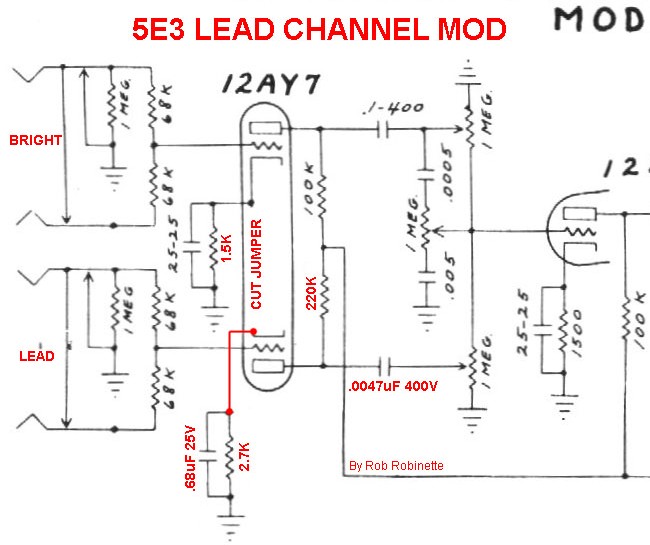
Note that when we separate the cathode resistors we have to double their value to retain the same bias so V1B (my unmodified channel) needs a 1.5K 1/2 watt cathode resistor (original was 820 ohms) to keep the same bias and tone. For the "Lead" channel (V1A) we move up to a 2.7k 1/2 watt cathode resistor to cool the bias for Marshall style asymmetric clipping distortion. V1A's bias point is shifted toward cutoff so the guitar signal's negative lobe will get clipped at cutoff with a lower level input signal leading to earlier distortion onset. Negative lobe cutoff clipping will also occur earlier than the positive lobe (which gets clipped much later by saturation). With this asymmetric clipping the positive lobe carries the undistorted musical content while the negative lobe carries the distortion. Asymmetric distortion also adds even order harmonics and shifts the audio wave duty cycle away from 50% and makes the distortion sound more tubey and distinct from solid state distortion. Asymmetric distortion is often described as sounding "creamier" with less fizz than symmetric distortion. See Tube Guitar Amplifier Overdrive for specific information on how overdrive distortion is created.
To add an eyelet for the new cathode resistor and bypass cap you'd have to pull the circuit board, drill the correct size hole and press in a new eyelet. Many of us make our own circuit boards so we have turret and eyelet tools to do this. What I actually did (I didn't want to pull the board) was glue the new bypass cap to the circuit board (I like Glue All by Superglue) then mounted the resistor to the cap leads. The glued cap will support the resistor and wire no problem.
We also want to reduce the value of the "Lead" channel coupling cap to .0047uF (from .1uF 400v or higher) to again suppress unwanted bass frequencies but more importantly reduce V2A bias excursion recovery time and therefore reduce preamp blocking distortion which will also smooth and sweeten the overdrive tone. If you don't want to deal with splitting the V1 cathodes just installing the .0047uF coupling cap will go a long ways toward tightening up the tone of just about any tweed amp channel.
The final tweak is to replace the 100k plate load resistor with a 220K (minimum 1/2 watt but I prefer a 1 watt for less resistor hiss). This will boost gain and hit the second preamp stage harder for more overdrive.
V1's extra caps and resistors can be a little crowded on the circuit board so it's a good idea to raise the hot cathode resistors higher off the circuit board than the coupling caps to aid cooling and minimize heat transfer from the resistors to the caps.
This mod works great with a higher gain 12AX7 in V1 and/or with the Cascaded High Gain Channel mod.
Lead Channel Mod
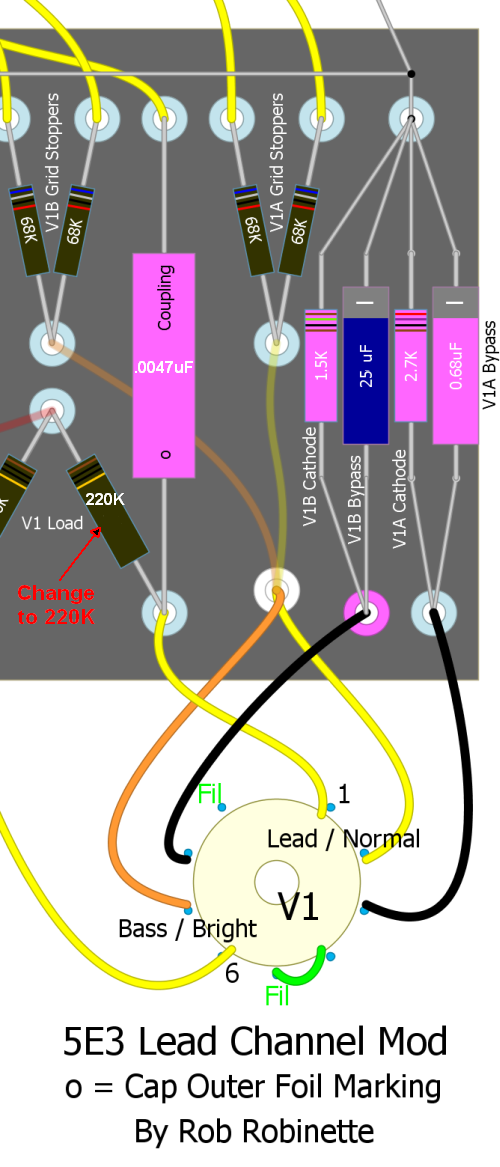
Modified components shown in pink. V1's cathodes are separated using two cathode resistors and two bypass caps. Don't forget to remove the cathode jumper between socket pins 3 and 8. The "Lead" channel gets a 2.7k cathode resistor, .68uF bypass cap, a .0047uF coupling cap and a 220k plate load resistor. The unmodified Bright channel needs a 1.5k cathode resistor since only one cathode is drawing current through it.
Switchable Cascaded Channels for High Gain Channel
This is my third favorite 5E3 mod (behind Switched Negative Feedback and PRE Phase Inverter Master Volume). I wanted a Marshall style lead 'Gain Channel' for my Fender 5E3 Tweed Deluxe clone. This simple mod is like having a built-in all tube overdrive pedal. It reroutes the Normal channel after it goes through the V1A preamp tube into the Bright channel to cascade their gain stages together. The result is the Normal channel becomes a 'Gain' channel who's gain is controlled by a dedicated 'Gain' preamp volume control so you can dial in as much tube overdrive as you want.
The cool thing is you can dial in preamp tube overdrive even at very low 'Master' volume levels. Also the Bright Channel is completely unchanged--it sounds exactly the same after this mod so you can still get all the sweet 5E3 Deluxe tone you need. There's even a switch option shown below so you can switch between a completely 'normal' 5E3 and this cascade mod. The Cascade Channel mod is simple to do and simple to reverse if you ever want to go back. This mod pairs really well with the "Lead" channel mod which cuts out the excess bass on one channel that can make the 5E3's fat bottom overdrive tone so messy. If you don't want to do the whole "Lead" channel mod just replacing the Normal channel's huge .1uF coupling cap with a Marshall sized .0047uF will go a long way in tightening up the overdrive bottom end. Reducing the size of the first preamp coupling cap will filter out the booming lows from the guitar but the larger downstream coupling caps will allow low frequency harmonics through which will fatten up the bottom end without being flabby or farty.
5E3 Deluxe With Cascaded Channels - Basic Mod
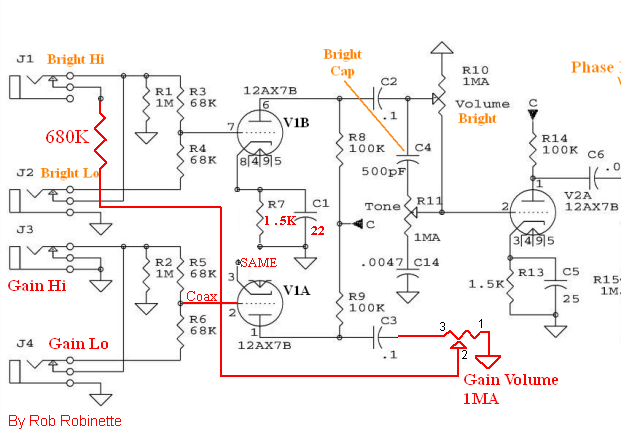
Changes in red. Normal Channel is rerouted to Bright Hi input jack switch terminal. Normal Volume pot becomes 'Gain' Volume. V1A and B's cathodes must be separated by installing a 1.5k ohm (1/2watt or higher) cathode resistor and one or two 22µF 25v cathode resistor bypass capacitors on V1A and V1B's cathodes (pins 3 & 8). The Gain Volume pot uses pin 3 for input and pin 2 (center wiper) for output. A 680k ohm resistor is added to pin 2 to limit Gain Channel gain.
Simple Cascade--No Switch and No Coax
Click on the image above for the full size layout. Changes are shown in 'Puke' Green. 'Gain' Channel gets amplified by V1A then feeds into the Bright Channel. The Normal Volume control becomes the Gain control and the Bright Volume control becomes the 'Master' Volume. Notice the V1 cathode bias resistors and caps at the far right of the circuit board. To separate V1A and B's cathodes you must change the existing cathode resistor from 870 ohms to 1.5k and install an additional 1.5k cathode resistor (a 22µF 25v bypass cap is optional for V1A as the extra gain it gives isn't needed). You must cut or remove the jumper on socket V1 between the cathodes (pins 3 and 8). You must also remove the jumper from the Bright Hi jack between the ground and switch terminals. You can download the editable DIYLC (DIY Layout Creator) layout file here: images\Guitar\5E3P Build\5e3p Tube Guitar Amplifier Cascade Inputs Coax.diy
When using the Bright Hi Channel simply turn down the Gain Volume and use the Master Volume and the amp will sound completely normal. The Gain Volume does interact with the Bright Lo volume so use both the Gain Volume and the Master Volume to control the Bright Lo volume.
Plug into the Gain Channel and use the Gain Volume to control the overdrive and use the Master Volume to control the overall volume. The new Gain Channel has a Hi and Lo input with the Lo input having the standard 6dB less signal.
This simple mod entails rerouting three wires at the volume controls, adding a resistor and separating the V1A and V1B cathode grounds. You must cut or remove the jumper on tube socket V1 between the cathodes (pins 3 and 8). You must also remove the jumper from the Bright Hi input jack between the ground and switch terminals.
Separated Cathode Resistors & Caps
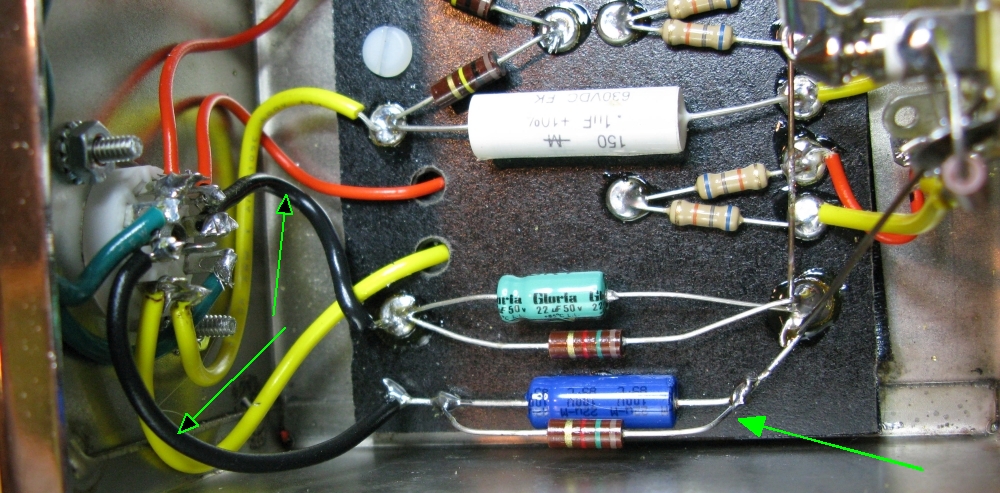
Cascade Mod + Gain Channel Coax
I recommend the use of coax for the Gain Channel. Using RG-174 coax from the Gain Channel input jacks to V1A can reduce noise. Putting the 68k grid stopper resistors on the input jack will reduce the input path's exposure to noise. Do not ground the coax shield at the tube end, only ground it to the Preamp Ground Bus or a Gain Channel input jack ground tab.
68k Grid Stopper Resistors Directly to Coax
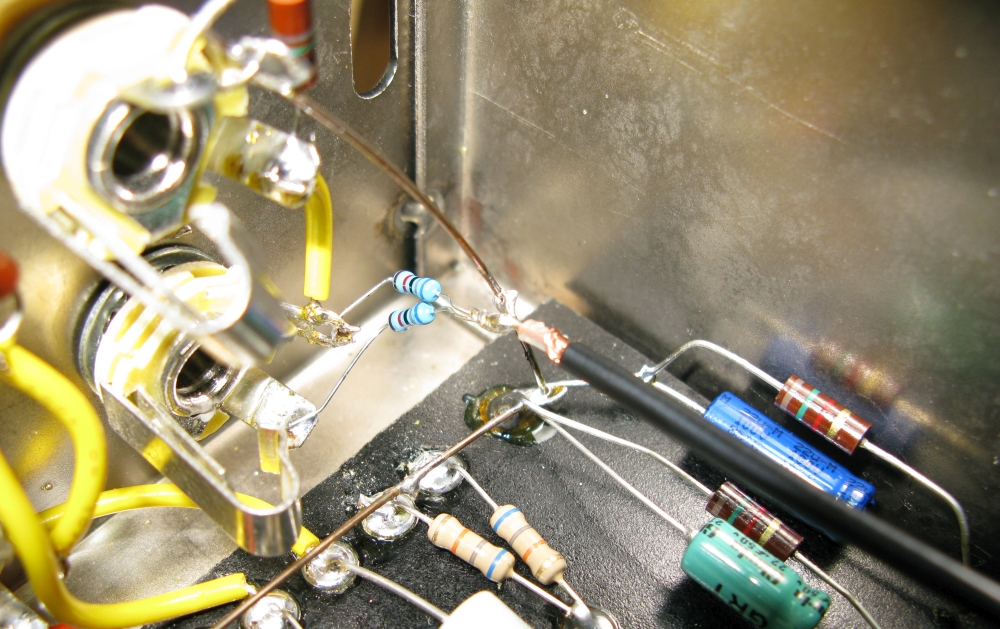
The coax shield is connected to the preamp ground bus bar to the right of the resistors.
Coax Connected to V1A Pin 2
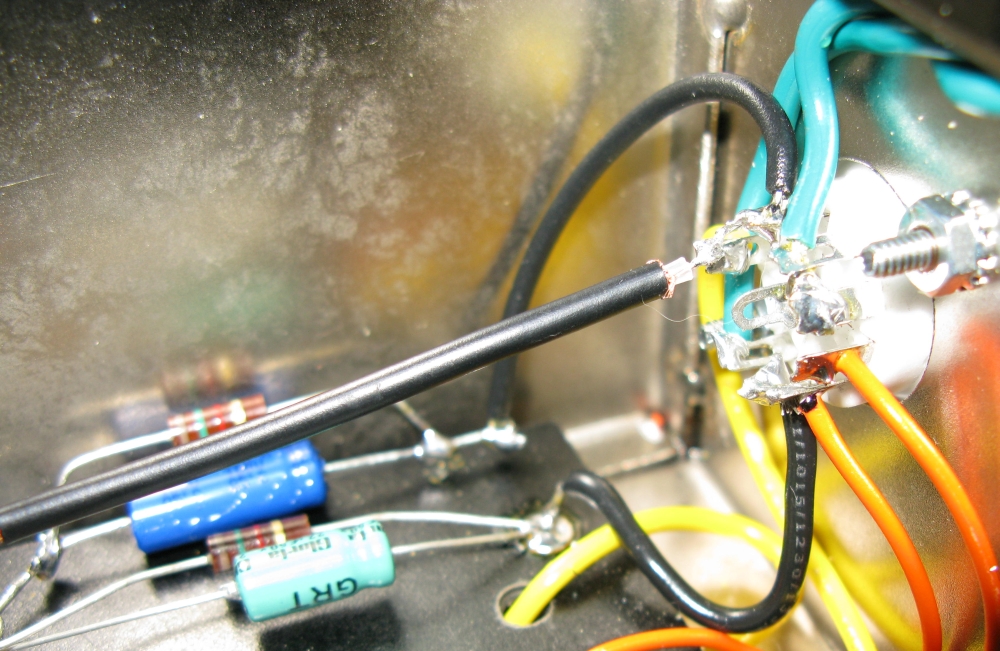
Coax shield is not grounded at this end. In this picture it looks like pin 3 is shorting to pin 2 but it isn't.
An Optional Switch for Standard 5E3 Parallel or Cascaded Channels
This is what I did and I really like being able to switch back and forth between standard 5E3 and cascaded channels. I used a 3PDT (3 pole double throw) On-On switch. The switch contacts move vertically in the layout above. With switch lever IN you get standard 5E3 parallel input channels. With switch OUT the Normal Channel cascades into the Bright Channel for preamp tube overdrive. With the switch lever IN the only difference between a stock 5E3 is the separated cathode resistors on V1 which will have very little impact on tone.
Parallel/Cascade Switch Installed
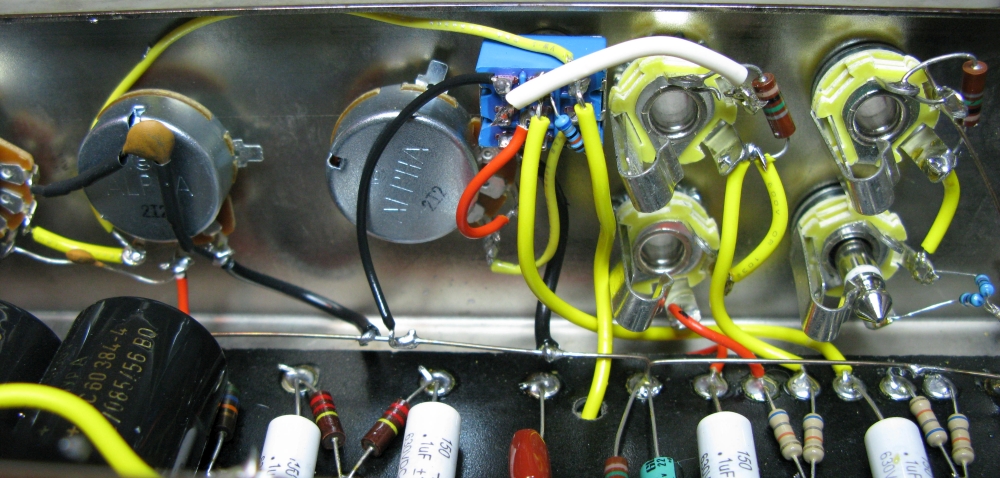
It's not pretty but it works great--this is a very cool mod. The switch is a 3PDT (3 pole double throw) On-On switch.
One other modification I recommend with the cascaded overdrive channel is to add a Pre Phase Inverter Master Volume or simply add a 470KΩ 1/2 watt grid stopper resistor to the V2B Phase Inverter input (V2 pin 7) to smooth out the Phase Inverter overdrive tone. The cascaded overdrive signal can really overwhelm the Phase Inverter and cause severe and nasty sounding clipping. A Pre Phase Inverter Master Volume will allow you to control how much Phase Inverter distortion is fed into the Power Tubes. These modifications can really sweeten the 5E3's overdrive tone. By adding a resistor or master volume the 5E3's sweet preamp tube distortion won't get chopped up in the phase inverter.
I'm very happy with the cascaded channel mod. I can dial in tube overdrive distortion on the Gain channel even at low Master volume levels and the Bright Hi channel is completely 5E3 Deluxe. You can also dial the Gain volume down and get a normal sounding Normal Hi and Lo tone.
Gain Channel Measurements
Signal generator 400Hz 91mv rms tone was injected into the guitar input jacks. Measurements were taken after one and two stages of amplification.
Gain - Hi Channel One Stage of Amplification
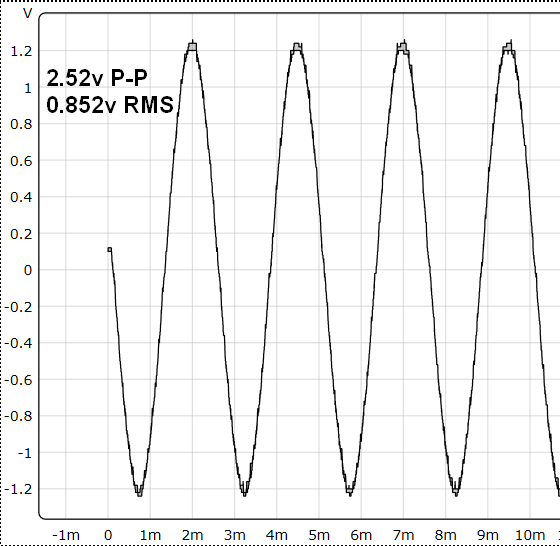
This is the 400Hz signal after going through just the Gain Channel amplification (V1A) with the Gain Volume set to max (12). Measured at Bright Hi input jack tip.
Signal gain for the Gain Channel gain stage = 0.852v rms out / 0.091v rms in = 9.36
The Gain - Lo Channel measured 0.44v rms with a signal gain of 0.44v / 0.091 = 4.8
The gain values for the Gain Channel are relatively low due to the 470k resistor placed at the Gain Volume input.
Gain - Hi Channel Measured at Master Volume Input - No Distortion
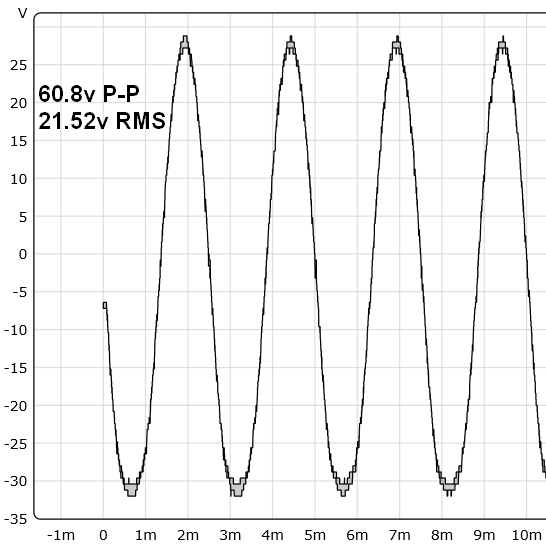
The signal has now passed through the Gain Channel and Bright Channel amplification (V1A and B) with Gain Volume at max and the Master Volume at 9. This is the max voltage before distortion set in.
Signal gain for the Gain Channel gain stage cascaded into the Normal Channel gain stage = 21.52v rms out / 0.852v rms in = 25.3
Gain - Hi Channel Measured at Master Volume Input - With Distortion
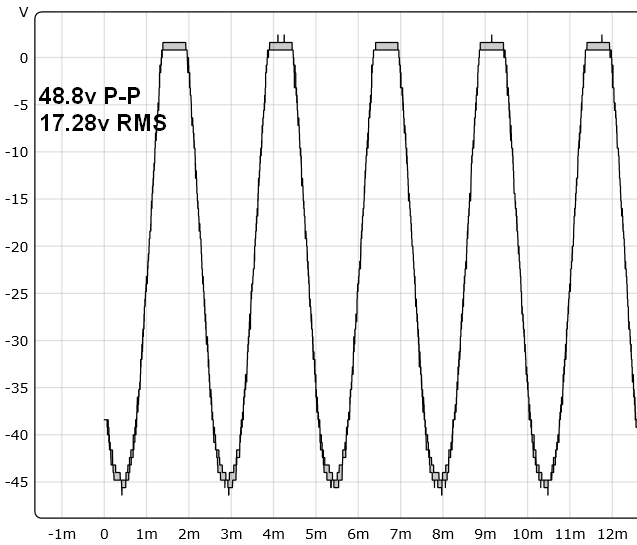
Conditions here are the same as above except the Master Volume is set to max (12). Max output dropped once distortion set in. This is all preamp distortion. The 5E3's phase inverter will also be driven into overdrive distortion and can add unpleasant content to the output tone.
Preamp Local Negative Feedback
This mod is an extremely easy to add local negative feedback loop that can be used to tune the overdrive tone of any high gain preamp. If you do a cascade mod like the previous mod this little mod is worth a try. The feedback is negative because the plate is 180 degrees out of phase with the grid. The mod connects a preamp's second or third gain stage plate back to its grid through a 22M to 44M resistor and .047uF (400v or higher) cap.
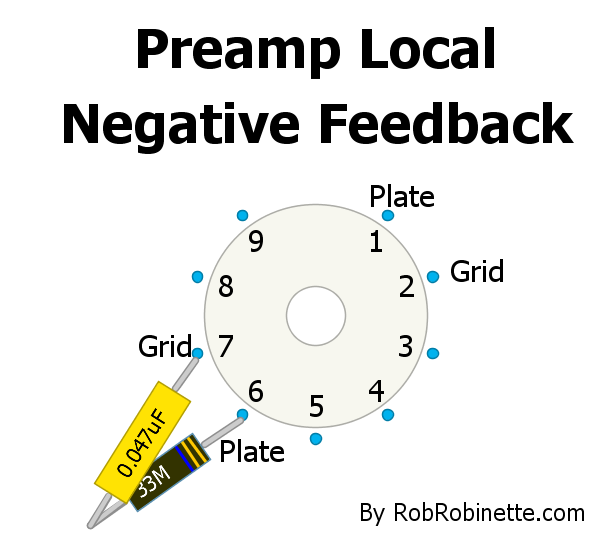
A 22M to 44M resistor and .047uF 400v+ cap connect the preamp grid and plate together to form a local negative feedback loop.
The mod can also be used on the "A" triode pins 1 and 2.Like most amplifier negative feedback loops this mod will reduce distortion, tighten the transition from clean to dirt and slightly reduce gain. At first blush I was going to recommend not using this mod on the first stage of amplification because if the cap fails as a short it could inject high voltage into the guitar circuitry but even if this does happen the large value feedback resistor will limit the current to 18 micro amps (.018 milliamp) or less so it's not a concern. This mod would be of relatively little use in the first gain stage anyway since it is rarely overdriven.
If this NFB loop tightens up the tone too much try a larger value resistor like a 44M. The larger the resistor the less negative feedback gets through to the grid. This is a pretty cool yet extremely simple circuit that should be experimented with in all high gain preamps.
Tube / Solid State Rectifier Switch
This mod will give you the choice of normal tube rectification with it's inherent voltage sag or give you solid state rectification with its higher, stiffer voltage. Solid state rectification and its higher B+ voltage will make the amp punchier, speed up its dynamics and modernize the tone. The standard 5E3 5Y3 rectifier tube drops the voltage about 60 volts compared to solid state so there will be an approximately 60 volt increase in B+ in the solid state switch position. You can add zener diodes in the line from the Backup Diodes to the Rectifier Switch to lower only the solid state voltage. Place the zener diode stripe (cathode) toward the rectifier.
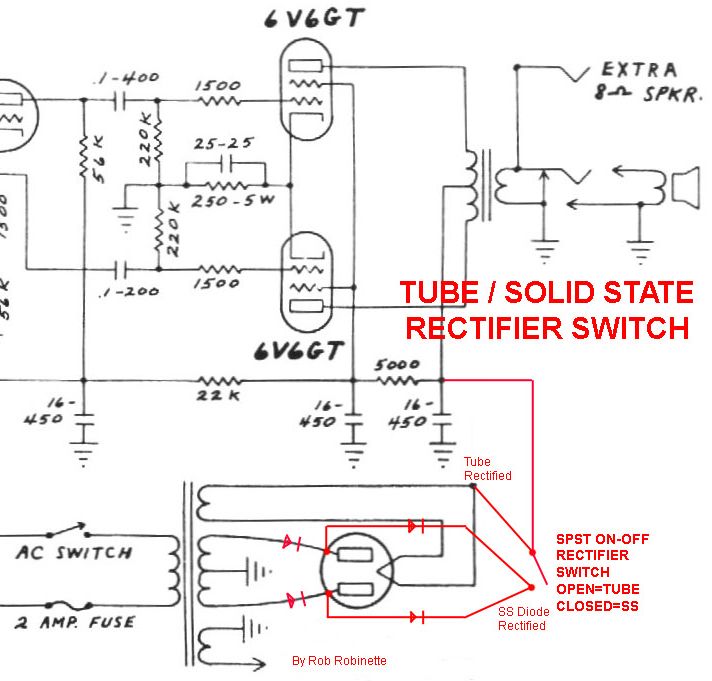
Open switch = tube rectification, closed switch = solid state rectification.
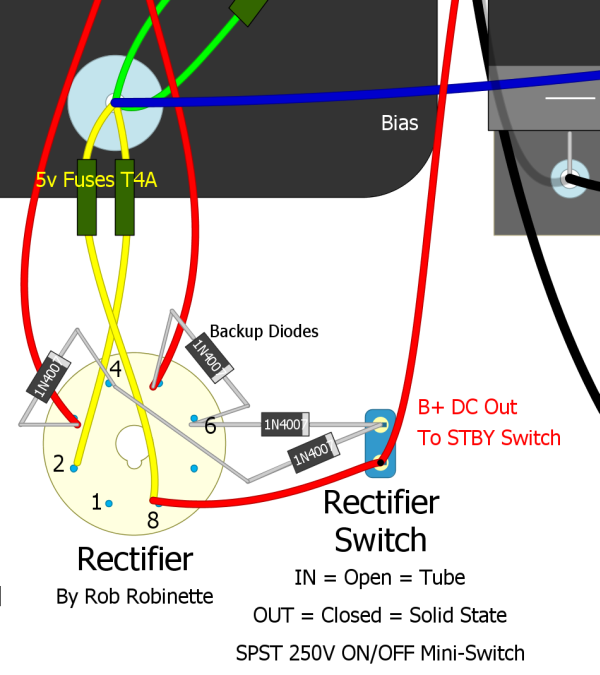
The 'Backup Diodes' mounted on the rectifier tube socket pull double duty. When using tube rectification they extend the life of the tube rectifier and protect the amp from a rectifier tube short. When solid state is selected with the Rectifier Switch both sets of diodes work together to directly supply the rectified B+ .
Here's a chart from 300guitars.com showing the different rectifier voltage drops:
Note the 5 volt 3 amp heater current requirements for some of the tubes.
Edge Deluxe Mods
Fender and U2's lead guitarist, Edge worked to develop the Edge Deluxe.
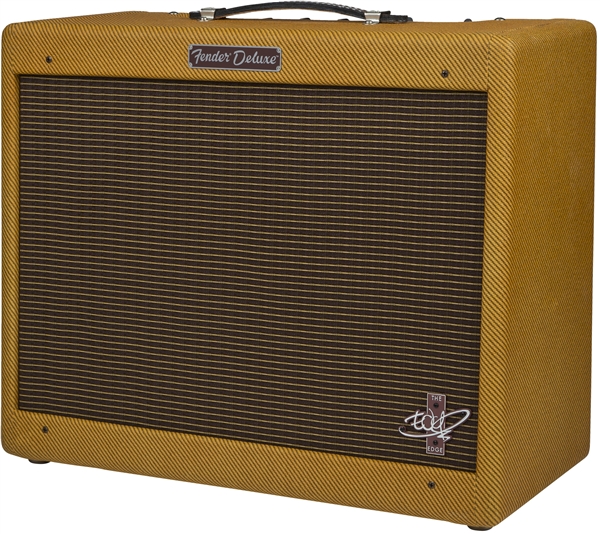
The new reissue Edge Deluxe has a hand wired eyelet board similar to the original 5E3.
It comes with a $270, 12-inch, 15 watt Celestion Blue G12 Alnico speaker with 100dB sensitivity so it's louder than 5E3 vintage speakers with their typical sensitivity of around 95dB. The Celestion Blue came in the original Vox AC30 so it sports a classic British voice.
Its volume pots' taper has been made more logarithmic (less linear) to slow the action of the knob and make the volume control more usable. I believe this is a minor tweak and not worth the effort to swap out the volume pots even if you could source the correct taper pots.
The Edge Deluxe Chassis
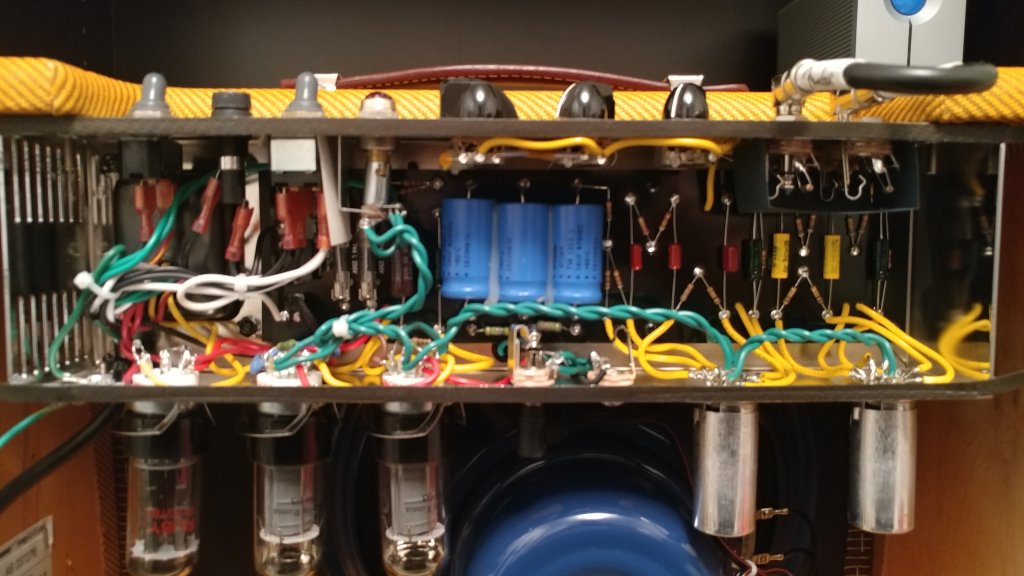
Photo by Skip.
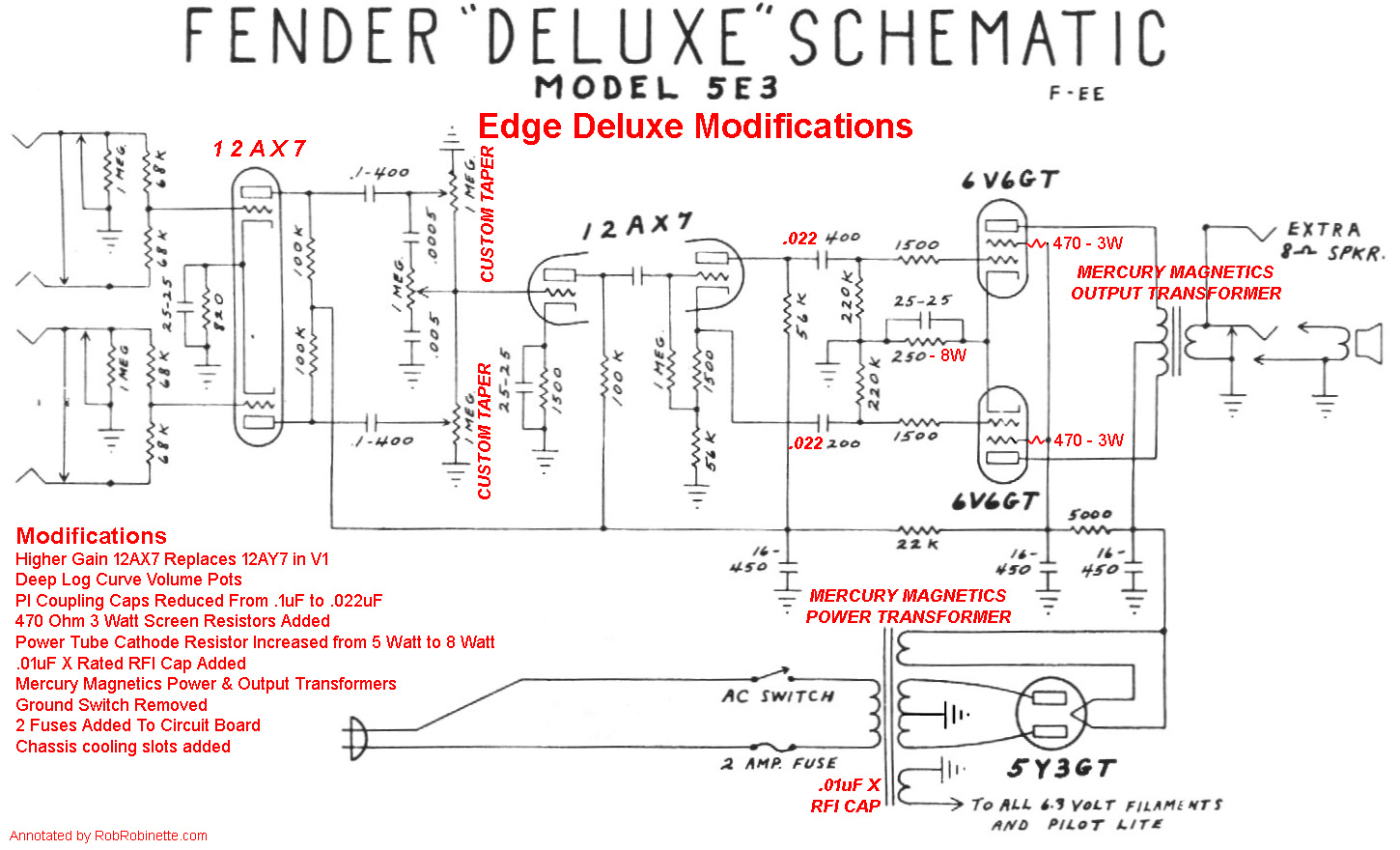
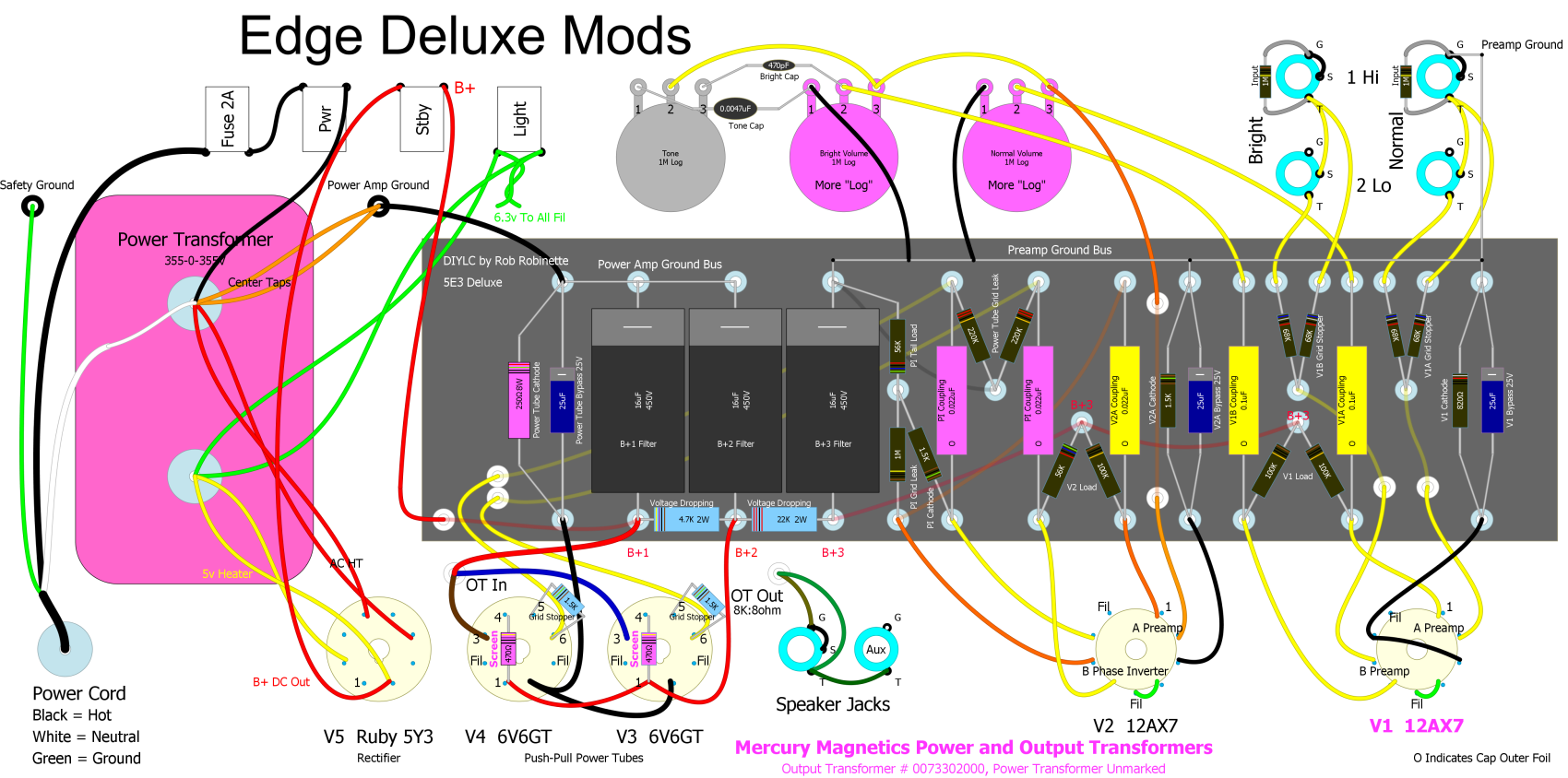
Both volume pots, both phase inverter caps and the V1 preamp are different from a standard 5E3 Deluxe. Both transformers are from Mercury Magnetics. Screen resistors have been added to the power tube sockets.
The normal 5E3 0.1uF phase inverter coupling caps are reduced to .022uF to tighten the bass response. The smaller cap filters out unneeded very low guitar frequencies that cause farting out.
A higher gain 12AX7 is used in V1 instead of the original's 12AY7 (even though the Edge's tube sheet says 12AY7). This limits playing clean to very low volume knob settings.
If you have an Edge Deluxe I HIGHLY recommend you try an 12AY7 in V1. I'm a fan of the current production Electro Harmonics 12AY7.
The Edge Deluxe also has added 470 ohm screen resistors to the power tube sockets. These resistors help protect the power tubes from excessive screen current during extended overdrive sessions and also slightly alter the overdrive tone, typically for the better. For more info on how screen resistors affect overdrive tone see this.
All the amp's resistors are modern carbon film resistors instead of the noisier, period correct carbon composition found in the original 5E3. Carbon film resistors generate less hiss than carbon comp resistors.
The power tube cathode resistor is a Brown Devil 250 ohm 8 watt where the original uses a 250 ohm 5 watt resistor.
The Edge also comes with very nice Mercury Magnetics Output and Power Transformers. The output transformer is a FTDO-59 and the power transformer is the FTDP.
Fender added two additional 250V 4A fuses to the circuit board for the 6.3V and 5V heater circuits for power transformer protection.
A 275V .01uF Class X cap has also been added across the mains hot and neutral conductors to reduce power line noise.
Cooling slots have been cut into the rectifier end of the chassis.
Protective rubber switch dust covers and the Edge’s hand-designed grille logo badge were added.
The cab's tweed fabric is lacquered.
Other than that it's a standard tweed Deluxe.
I list the above modifications in the following order of tonal importance:
12AX7 in V1 for much earlier breakup
Speaker swap
.022uF phase inverter coupling caps
Mercury Magnetics Output Transformer
Addition of screen resistors
Carbon film resistors
Mercury Magnetics Power Transformer
Volume pots with new taper
The 8 watt power tube cathode resistor, additional fuses, thermistor and .1uF RFI cap will not alter the amp's tone.
Howard Dumble Tweedle Dee Mods
Howard Dumble modified a Fender tweed amp which was nicknamed "Tweedle Dee". His Tweedle Dee mods reduce voltage sag, tighten up the 5E3's bottom end and sweeten the overdrive tone.
Howard Dumble Tweedle Dee & 5E3 Deluxe Differences
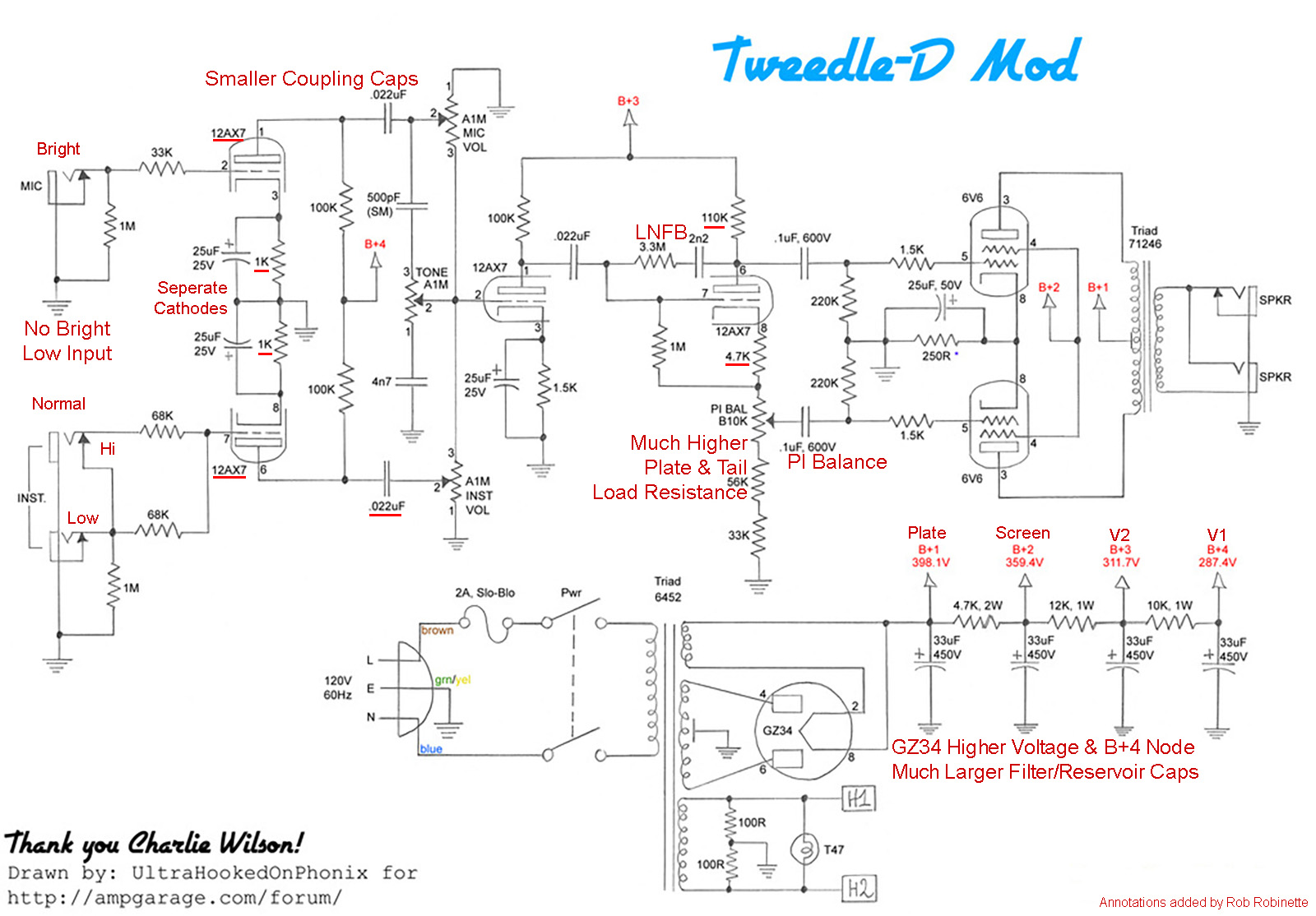
I have highlighted the differences between the Tweedle Dee and a standard Fender 5E3 Deluxe. The phase inverter tweaks are the most important of the Tweedle Dee mods. Howard added local negative feedback between the plate & grid, increased the plate and tail load resistance from 56k to 110k, increased the cathode resistor from 1.5k to 4.7k and added the phase inverter balance pot (PI BAL 10K linear pot). The LNFB 3.3M resistor should really be 33M.
Tweedle D Mods:
V1 12AX7 instead of 5E3's 12AY7 for more preamp gain
V1 cathodes separated to reduce channel interaction
V1 cathode resistors 1k compared to 5E3 equivalent 1640 ohm for a slightly warm 12AX7 bias
V1 coupling caps reduced from .1uF to .022uF to trim excessive bass frequencies
Local negative feedback from phase inverter plate to grid
Helps the phase inverter deal with the added gain from the 12AX7 V1 by reducing nasty cathodyne phase inverter distortion, tightening the transition from clean to distortion and slightly reducing gain.
Phase Inverter plate load and tail load resistance is increased from 56k to 110k to add headroom
Phase Inverter cathode resistor is increased from 1.5k to 4.7k to cool the bias and make sweet sounding asymmetrical cutoff clipping more likely
Phase Inverter Balance Control
The circuit allows control of even order harmonic distortion generated by phase inverter imbalance. Add imbalance to fatten the clean tone or balance the phase inverter to smooth out the overdrive tone.
A GZ34 rectifier tube is used in place of the 5E3's 5Y3 tube for higher voltage and less voltage sag
Filter/Reservoir caps are doubled in size from the 5E3's 16uF for less hum, less voltage sag and a tighter bottom end
An additional filter node is created to give V1 and V2 separate nodes and raise the second gain stage & phase inverter plate voltage for more headroom & gain
Instead of one 22k voltage dropping resistor Howard used a 12k for B+3 and a 10k resistor to create B+4
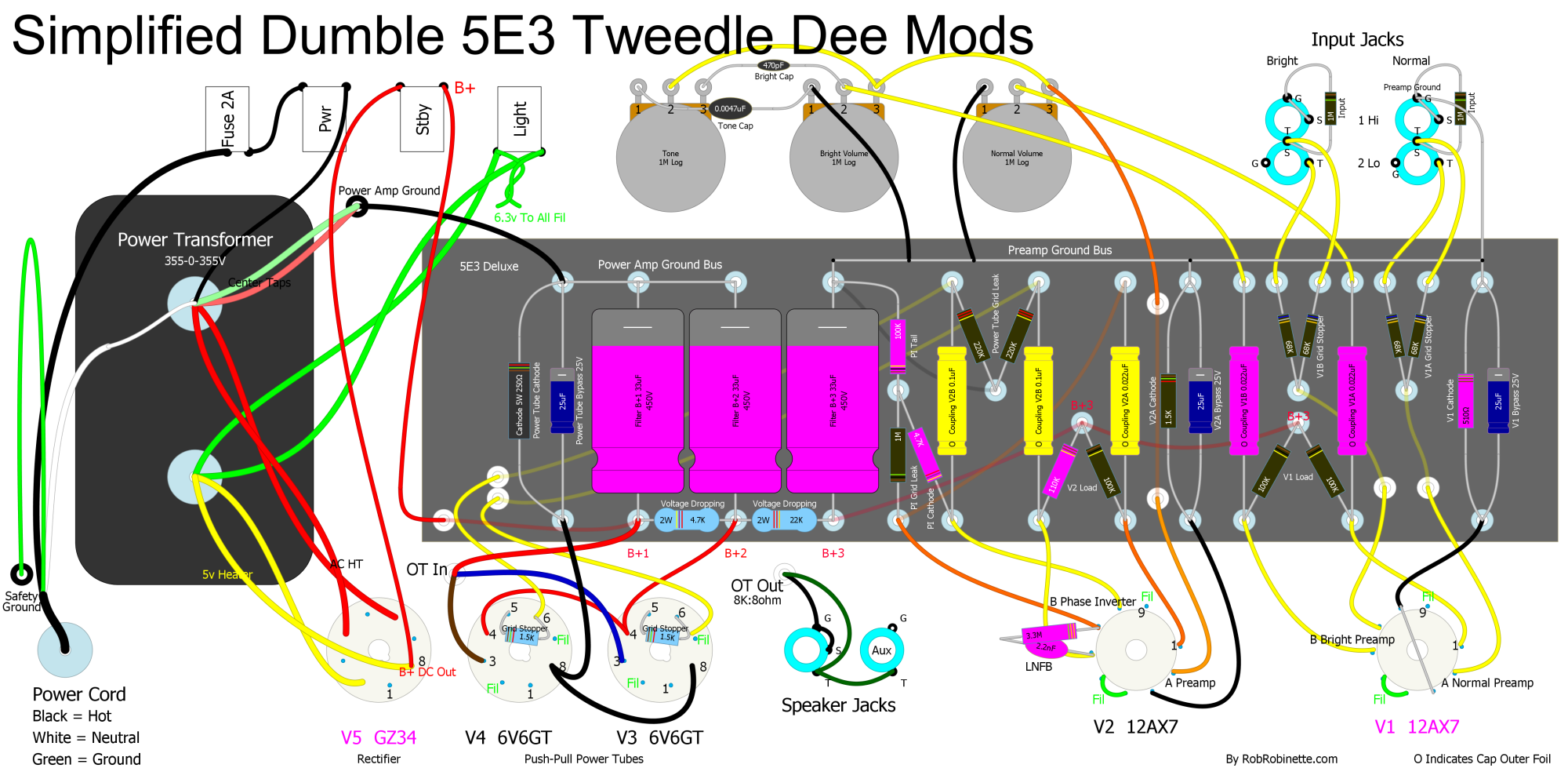
Tweedle Dee mods to a 5E3 Deluxe shown in magenta. The Phase Inverter Balance Control is deleted for simplicity. The V1 cathodes are not separated but the cathode resistor is reduced to 510 ohms to equal the Dumble separate 1k cathode resistors. The extra B+4 power node is deleted. These mods will get you very close to Tweedle Dee tone.
The downside to these mods is the amp becomes much less a tweed Deluxe and much more high strung. Whether you like these mods or not depends on what you want from your amp.
Tweedle Dee by Adam Berry
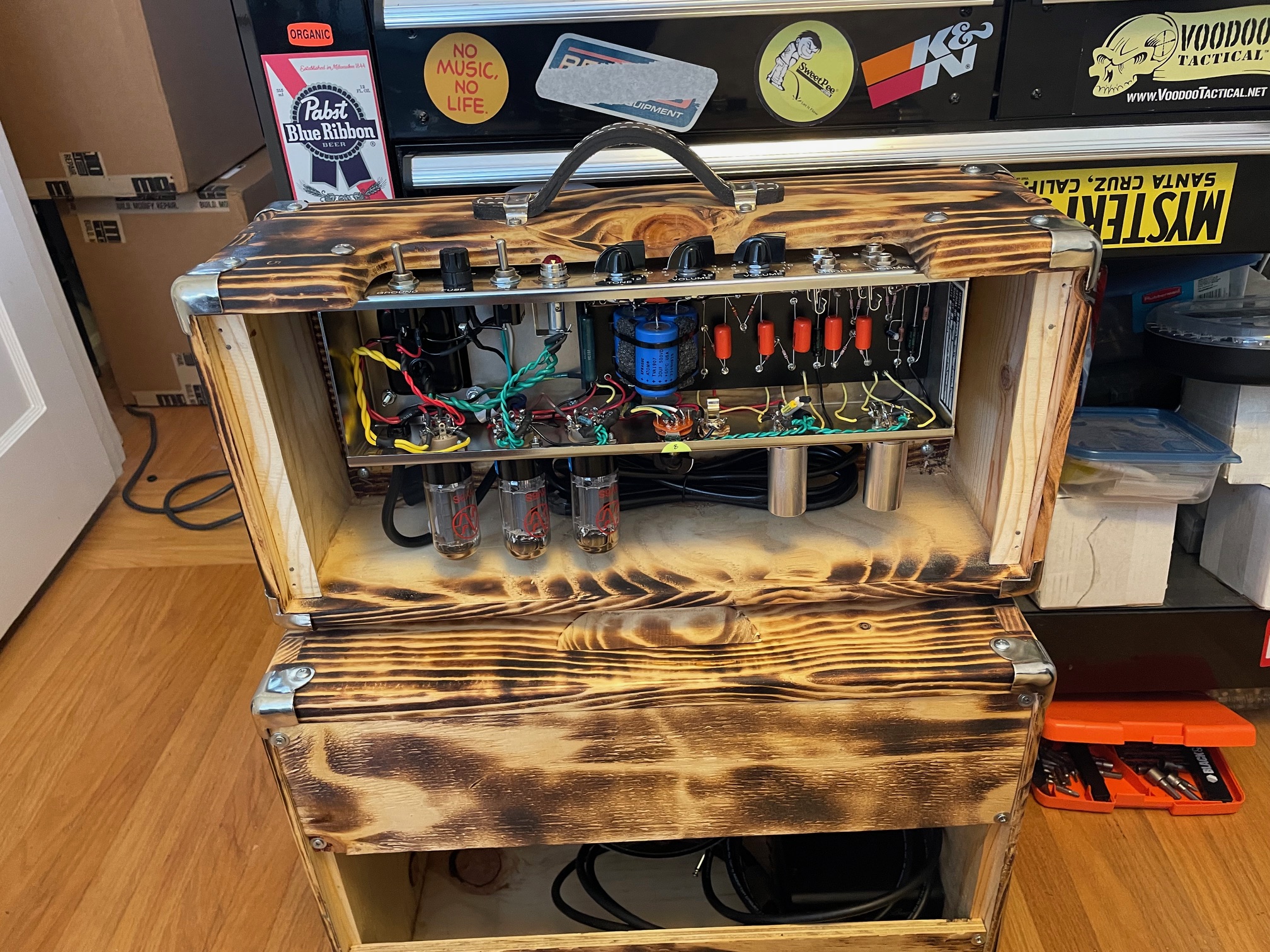
Mute Switch
This simple mod adds an On-Off (SPST) switch which grounds the V2A second preamp stage grid to silence the amp. There is no switch pop because the tube's grid leak resistor or volume pot act as switch "no pop" bypass resistors. I connected the switch to the second preamp stage grid because it will silence both channels. You cannot connect a ground switch like this to a phase inverter or cathode follower because their grids usually have DC voltage on them. If you are not sure about grid voltage you can carefully measure for DC voltage on the grid pin. In 12A*7 tubes pins 2 and 7 are the grids.
Mute Switch
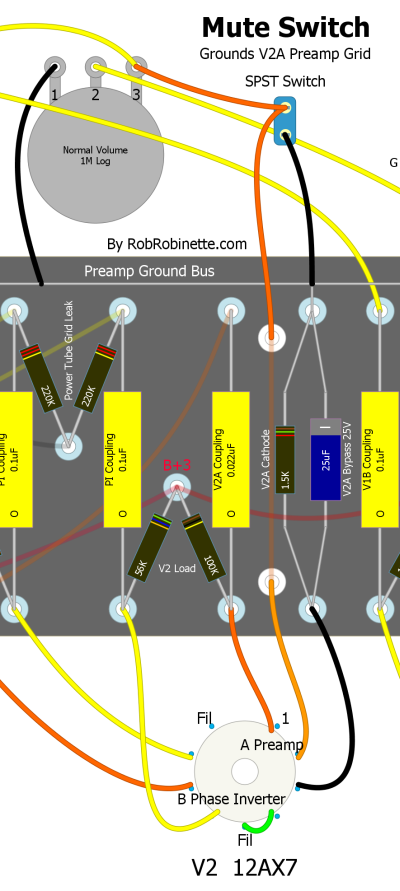
Switch down = normal, up = mute by closing the switch and grounding the preamp tube grid with all guitar audio sent to ground. Simply insert the switch into the wire that runs from the Normal Volume pot to V2 pin 2 (grid). Connect the other switch terminal to a ground (using the preamp ground bus above).
1/4 Power Switch
This very cool 1/4 Power Switch is from the 20 watt Fender Eric Clapton Tremolux. The switch cuts the amp's output power by 75%, down to about 5 watts. The switch places an 8 ohm 25 watt resistor in series with the 8 ohm amplifier speaker (for a total of 16 ohms and a 50% cut in power), then places a 16 ohm 25 watt resistor in parallel to bring the total speaker load back down to 8 ohms and gives another 50% cut in power. The two resistors turn 3/4 of the amp's output signal into heat. With the switch in the "Normal" position the 8 ohm resistor is bypassed and the 16 ohm resistor is disconnected.
The Eric Clapton Tremolux is a 2x6V6 fixed bias amp putting out about 20 watts so this circuit will work with any amp with similar or lower output.
You can use the 1/4 Power Switch with the internal speaker and an external cab simultaneously but the speakers' load will drop to 4 ohms so most of the power will bypass the 16 ohm resistor and flow through the 8 ohm resistor and speakers. Total load on the output transformer drops to 6.8 ohms but the Fender 8 ohm transformer is designed to work with two parallel speakers at a 4 ohm load so it's not a problem.
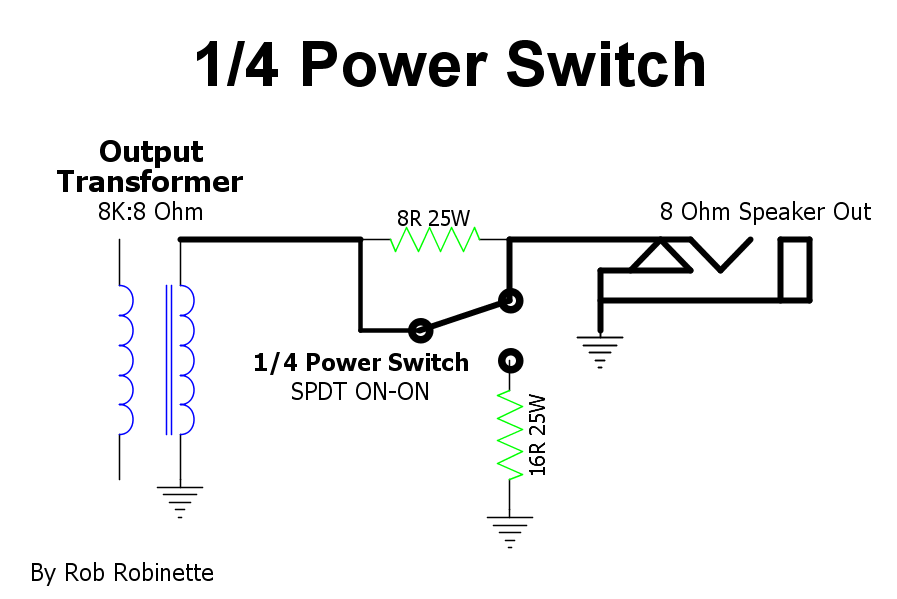
The 8 ohm 25w resistor is placed in series with the amplifier speaker and the 16 ohm 25 watt resistor is placed in parallel to bring the total speaker load back down to 8 ohms. If your amp does not have an Aux speaker jack just connect the 16 ohm resistor and switch wire to the speaker jack's Tip and Ground terminals.
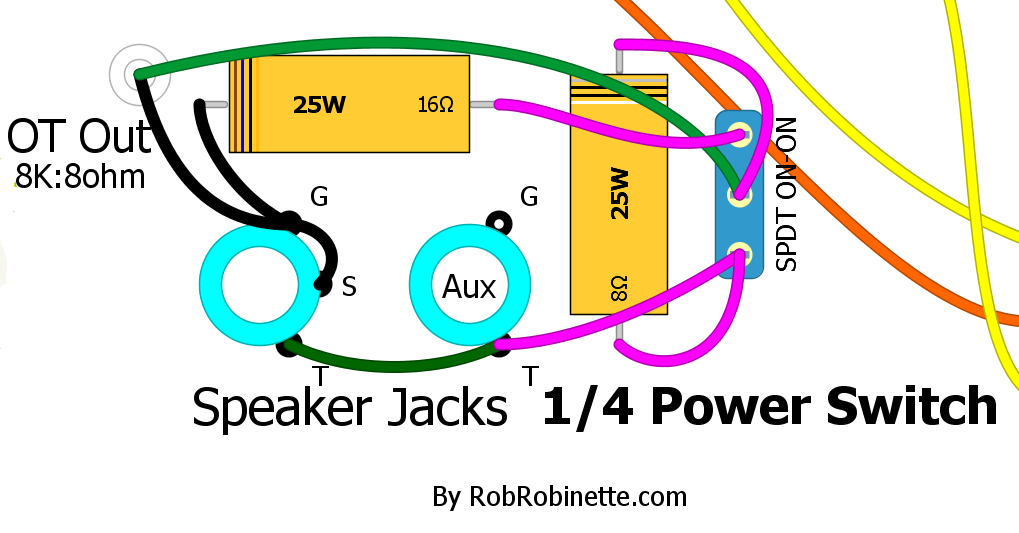
T=Tip and G=Ground.
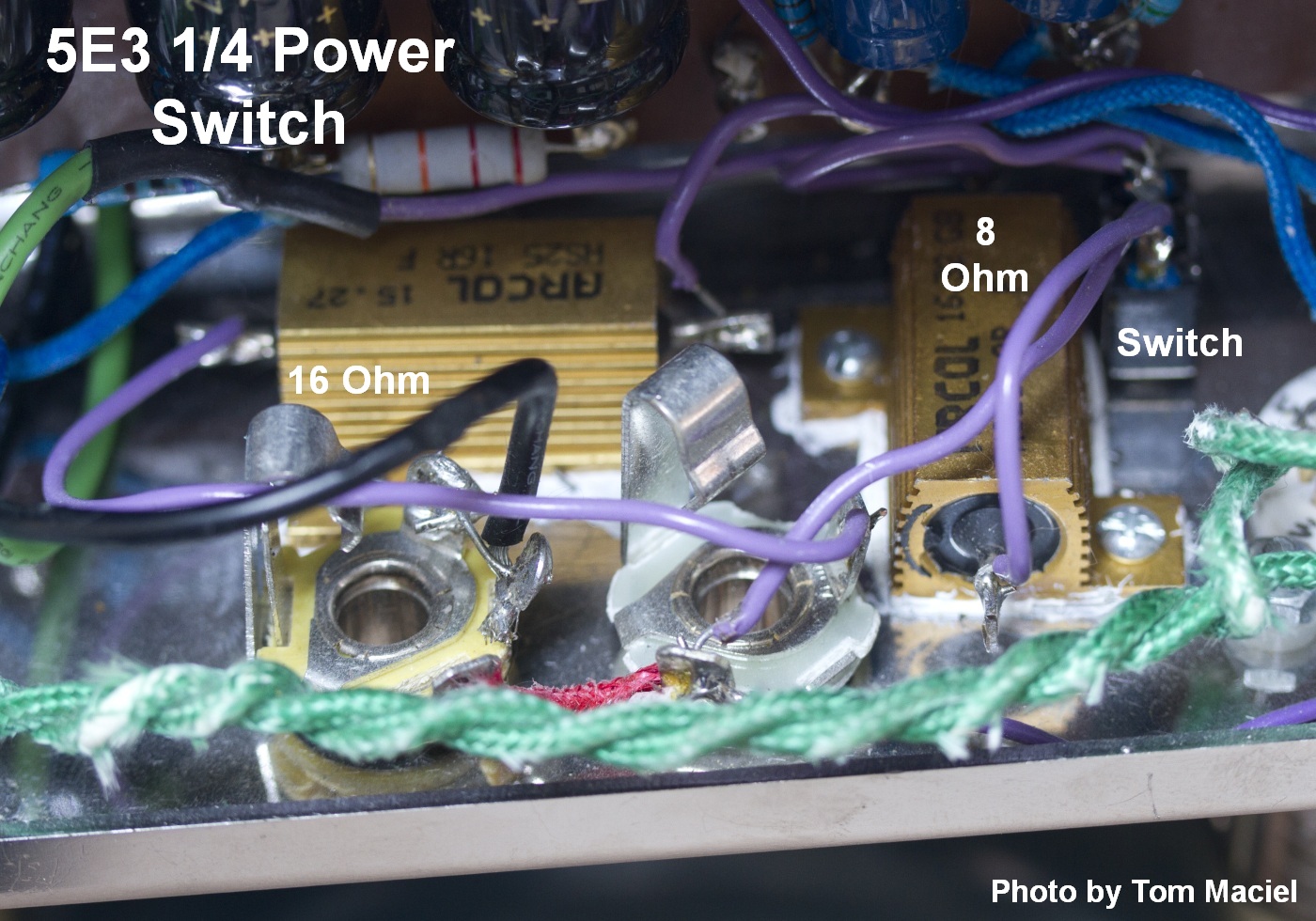
Large, gold colored 25 watt chassis mount resistors with 1/4 Power Switch at upper right. Photo by Tom Maciel.
Mouser.com: 8 ohm 25 watt wire wound chassis mount resistor, 16 ohm 25 watt resistor. The resistors are about $3 each.
These are chassis mount resistors and should be screwed or bolted to the chassis to dissipate heat. If they are not bolted to the chassis their heat rating drops to about 5 watts.
For a 4 ohm output transformer secondary change the resistors to a 4 ohm 25 watt and 8 ohm 25 watt.
For a 16 ohm output transformer secondary change the resistors to a 16 ohm 25 watt and 32 ohm 25 watt.
For a 1x6V6 cathode biased amp like the 5F1 Champ 10 watt chassis mounted resistors would be fine.
10% Power Switch
Several builders have complained that the 1/4 Power Switch shown above, which cuts 75% of the output power, only sounds like a 30 to 50% volume cut due to how our ears perceive volume. If you really want near-bedroom volume levels then a 90% cut in power can be attained by using a 16 ohm 25W resistor for the upper resistor and a 12 ohm 25W resistor for the lower resistor (8 ohm output transformer secondary). The 12 ohm resistor will burn most of the amp's output so for anything more powerful than a cathode biased push-pull 6V6 amp like the 5E3 Deluxe you'll need to bump the 12 ohm resistor's power handling to 50 watts to be safe (two 25 ohm 25 watt resistors in parallel will work).

90% of the amp's output power will be converted to heat.
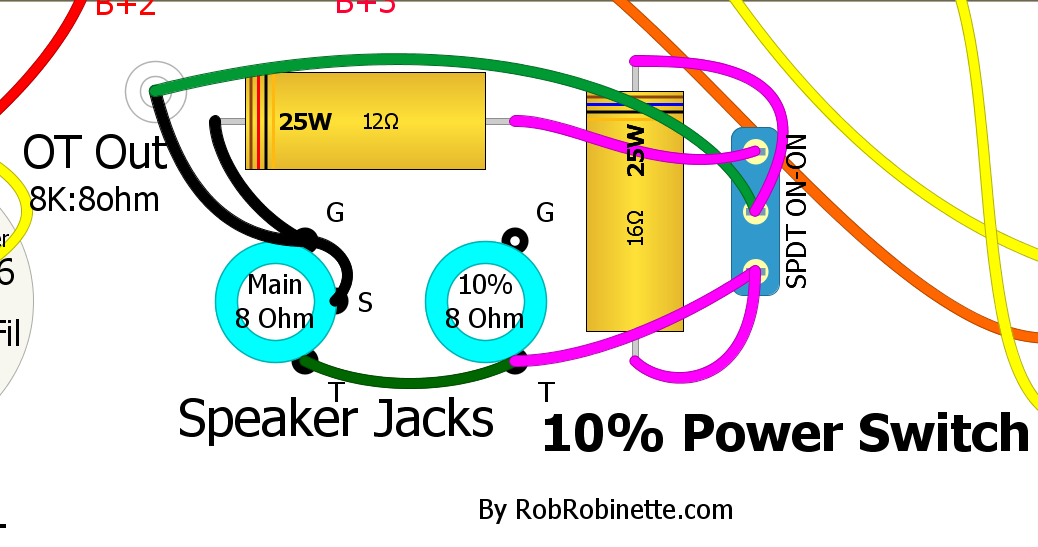
With the switch set to 10% both jacks will be 8 ohm with 90% of the amp power turned into resistor heat. These 25 watt resistors are adequate for 15 watt amps such as a 5E3 Deluxe or other cathode biased 6V6 push-pull amps.
These are chassis mount resistors and should be screwed or bolted to the chassis to dissipate heat. If they are not bolted to the chassis their heat rating drops to about 5 watts.
For 25 watt amps such as a blackface or silver face Deluxe or other fixed bias 2x6V6 push-pull amps I recommend 50 watt resistors (two 25 watt resistors in parallel will also give you 50 watts).
For 50 watt amps such as 2x6L6 amps I recommend 100 watt resistors (two 50 watt resistors in parallel will also give you 100 watts).
For a 100 watt amp such as 4x6L6 amps I recommend 200 watt resistors (two 100 watt resistors in parallel will also give you 200 watts). These would be difficult to stuff into an amp chassis.
For a 2 ohm output transformer secondary you would use 3 and 4 ohm resistors.
For a 4 ohm output transformer secondary you would use 6 and 8 ohm resistors.
For a 16 ohm output transformer secondary you would use 24 and 32 ohm resistors.
If your amp has a negative feedback loop then tap it from the main speaker jack tip connection.
10% Power Jack
You can wire your speaker aux jack as a 10% power output jack. This mod uses the circuit above but uses the main speaker jack switch to switch between full power and 10%.

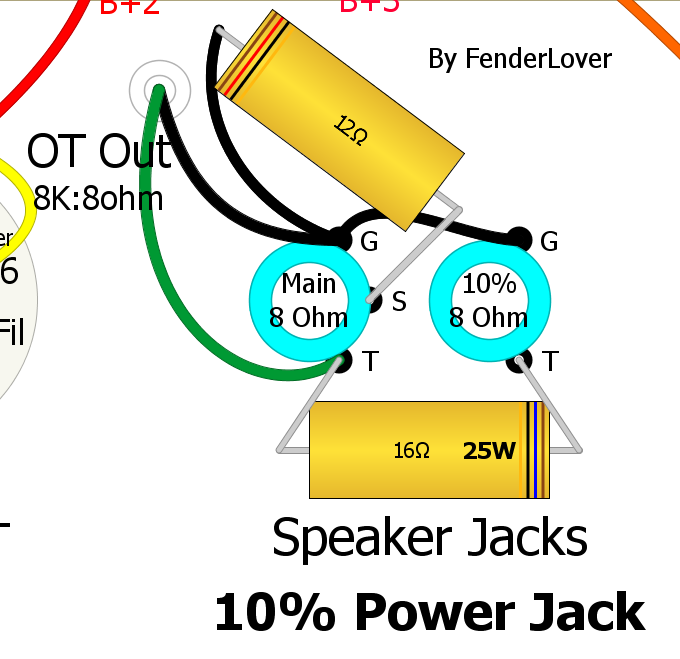
The main speaker jack on the left is 8 ohm full power. The 10% jack on the right is 8 ohm but 90% of the amp output power is burned in the two 25 watt resistors. These 25 watt resistors are adequate for 15 watt amps such as a 5E3 Deluxe or other cathode biased 6V6 push-pull amps.
These are chassis mount resistors and should be screwed or bolted to the chassis to dissipate heat. If they are not bolted to the chassis their heat rating drops to about 5 watts.
For 25 watt amps such as a blackface or silver face Deluxe or other fixed bias 2x6V6 push-pull amps I recommend 50 watt resistors (two 25 watt resistors in parallel will give you 50 watts).
For 50 watt amps such as 2x6L6 amps I recommend 100 watt resistors (two 50 watt resistors in parallel will also give you 100 watts).
For a 100 watt amp such as 4x6L6 amps I recommend 200 watt resistors (two 100 watt resistors in parallel will also give you 200 watts). These would be difficult to stuff into an amp chassis.
For a 2 ohm output transformer secondary you would use 3 and 4 ohm resistors.
For a 4 ohm output transformer secondary you would use 6 and 8 ohm resistors.
For a 16 ohm output transformer secondary you would use 24 and 32 ohm resistors.
If your amp has a negative feedback loop then tap it from the main speaker jack tip connection.
10% Power In External Box
This is the 10% power circuit in a box. The amp speaker out plugs into the IN jack and the speaker is plugged into the OUT jack.
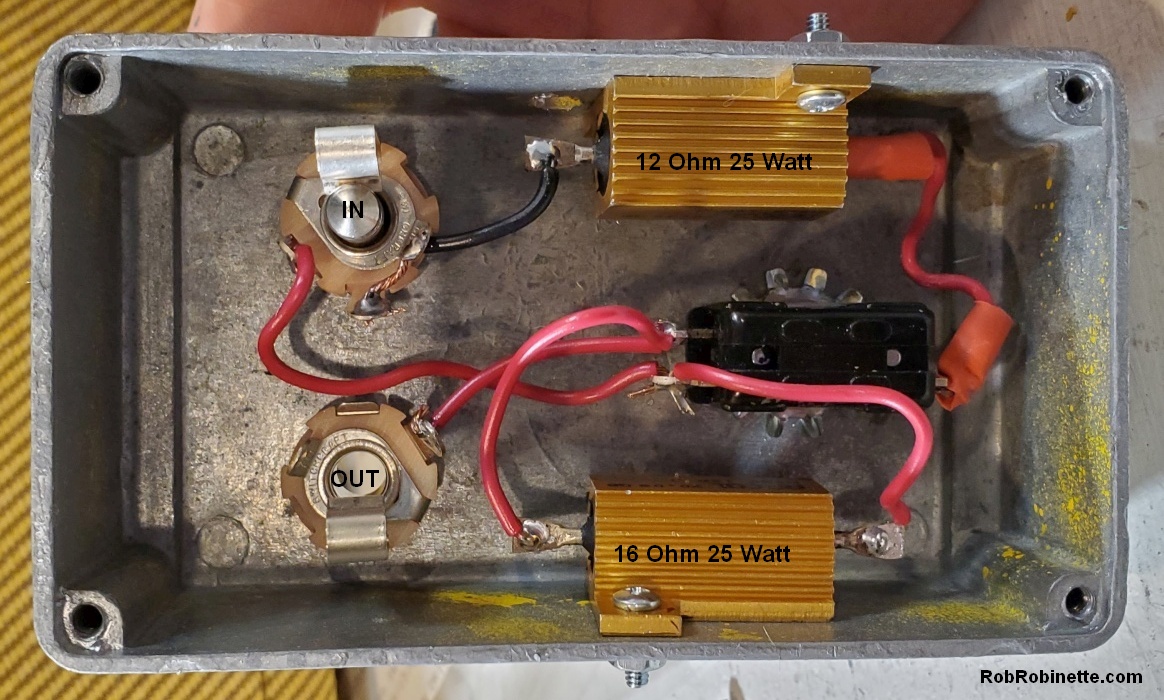
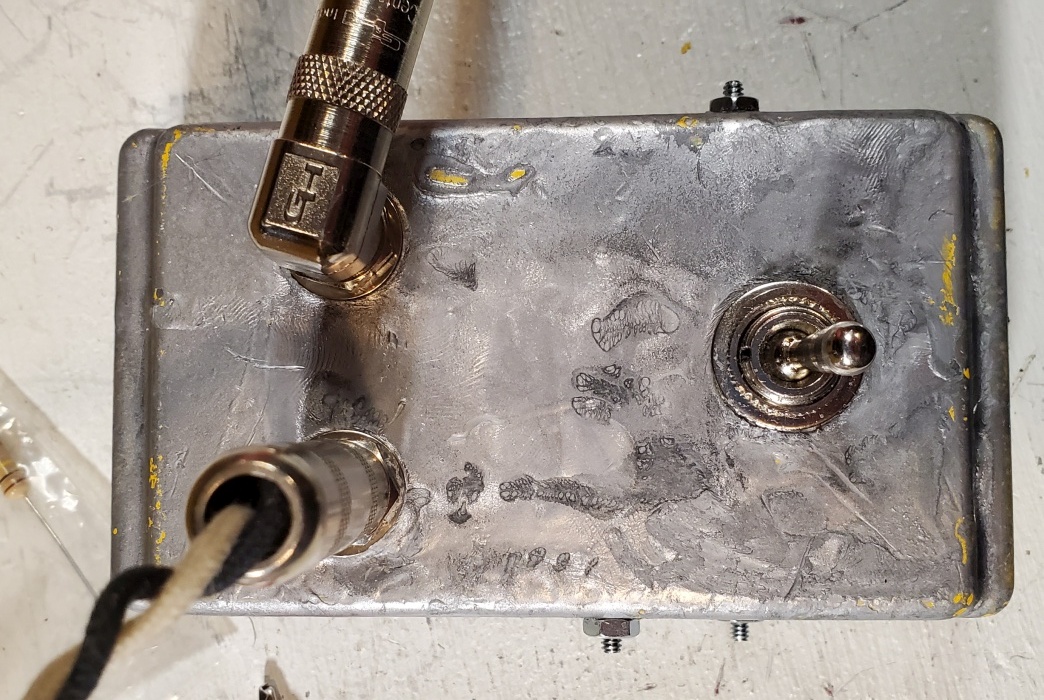
Another Box Using Cliff Jacks
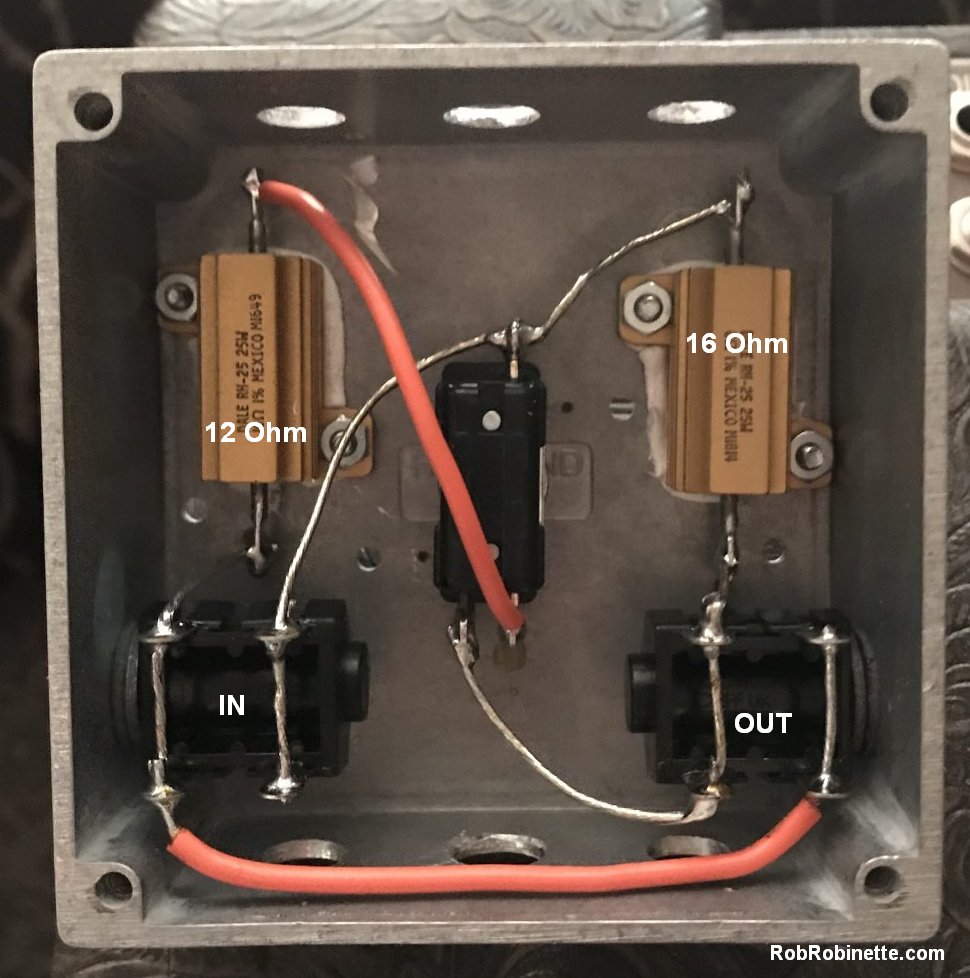
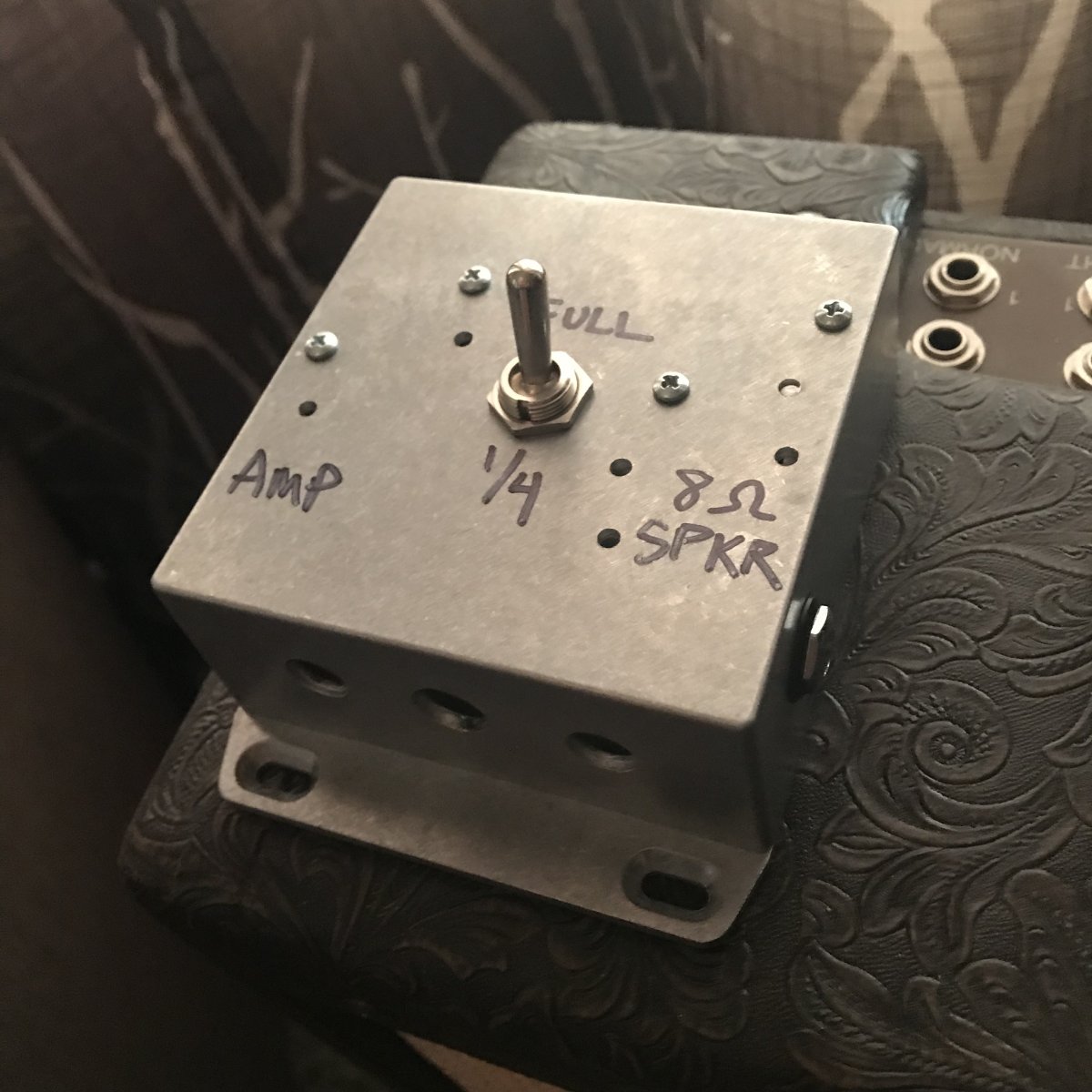
These are chassis mount resistors and should be screwed or bolted to the box to dissipate heat. If they are not bolted to the chassis their heat rating drops to about 5 watts.
For 25 watt amps such as a blackface or silver face Deluxe or other fixed bias 2x6V6 push-pull amps I recommend 50 watt resistors (two 25 watt resistors in parallel will also give you 50 watts).
For 50 watt amps such as 2x6L6 amps I recommend 100 watt resistors (two 50 watt resistors in parallel will also give you 100 watts).
For a 100 watt amp such as 4x6L6 amps I recommend 200 watt resistors (two 100 watt resistors in parallel will also give you 200 watts). I don't recommend this because the box would have to be really big to provide an adequate heat sink for the big resistors.
For a 2 ohm output transformer secondary you would use 3 and 4 ohm resistors.
For a 4 ohm output transformer secondary you would use 6 and 8 ohm resistors.
For a 16 ohm output transformer secondary you would use 24 and 32 ohm resistors.
1/2 Power Switch
This is a standard 'Pentode / Triode' type switch that lowers the power tube output for lower maximum volume. In reality this switch changes the 6V6 power tube from a pentode (5 electrodes: cathode, control grid, plate, screen grid and suppressor grid) to a tetrode (4 electrodes since the screen grid is deactivated) but by convention we call it a pentode / triode switch.
A triode tube's plate normally 'pulls' free electrons from the cathode but a triode's plate voltage fluctuates as it amplifies a guitar audio signal. When the plate voltage drops it does not pull electrons as hard as it does when the plate voltage is high. Adding a fixed, high voltage screen grid makes a tube much more efficient because the screen's constant strong pull of electrons does not drop when the plate's voltage drops so the tube flows more electrons.
The Half Power Switch (ON-ON DPDT mini switch) connects the power tube screens (pin 4) to B+2 (normal full power pentode) or to the power tube plates (pin 3 for half power 'triode' mode). Removing B+2 and tying the power tubes' screen and plate together deactivates the screen by allowing the screen voltage to fluctuate along with the plate voltage effectively creating a lower power 'triode.' Running a pentode in 'triode' mode definitely changes its clean and overdrive tone so it's more than just a 'half power' mode.
Half Power Switch in the BootHillAmps.com SixShooter
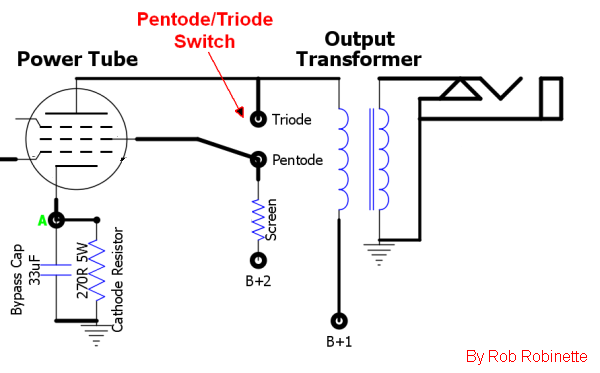
Power tube screen grid is connected to either the plate in the triode mode, or the B+2 screen power supply in the pentode mode.
This is a simple mod because there's room between the power tubes for the mini switch so the resistors can be connected directly between the tube sockets and switch. 470Ω 2 watt screen resistors are added to keep the screen voltage slightly lower than plate voltage. These resistors have no effect on amp tone but give the added benefit of protecting the power tubes from excessive screen current which can extend the life of your power tubes.
With the switch lever 'IN' you get normal full power. With the lever 'OUT' you get 'tetrode' half power.
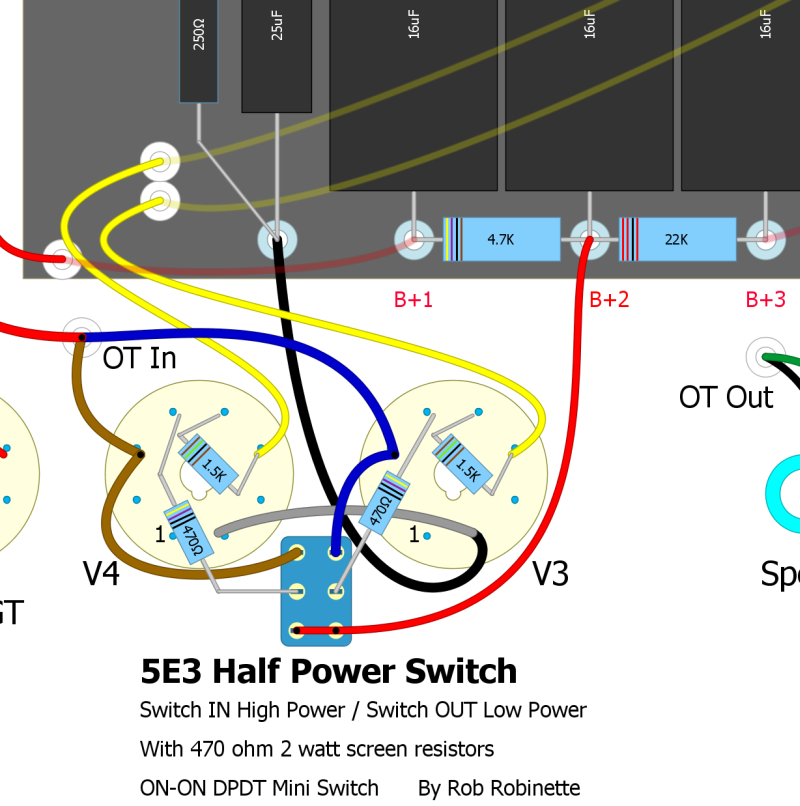
This is my recommended layout with 470Ω 2 watt screen resistors always in circuit to provide excess screen current protection.
Alternate Design With Screen Resistors Used only For Low Power
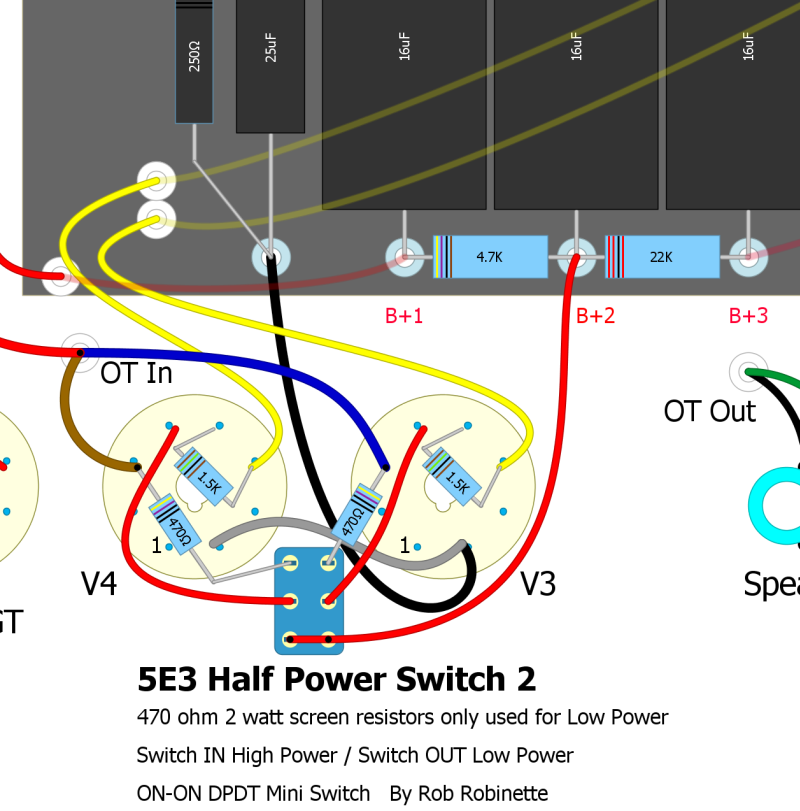
470Ω Screen Resistors moved to switch input so they are only used in the 'Low Power' switch position. Use this layout if you don't want to alter your 5E3's circuit with the switch in the normal 'High Power' position.
FX Loop
Add a simple, passive FX loop. Effects like reverb and delay sometimes sound best when inserted after the first gain stage and volume/tone circuit. This simple mod works really well so I add them to most of my amp builds. The Normal volume control works as the "send level" control.
The Send jack can also be used as a preamp out to another amp or recording rig. The Return jack can be used as a "power amp in" jack. You can also plug your guitar into the Return jack to bypass one gain stage and the volume/tone circuit for a really clean, low gain, unprocessed tone. When plugging a guitar into the Return jack you will have to control the volume with your guitar's volume control.
Insert the jacks between the Normal Volume out and V2 Pin 2. The upper "Send" jack is non-switched Switchcraft 11 jack, the lower "Return" jack is a three terminal Switchcraft 12A jack with shunt (switch)--just like the input jacks.
Here's a buffered, zero-loss, $85 FX loop kit that gets great reviews: Metroamp Zero-Loss FX Loop Kit
Change the Tone Cap Value
The 5E3's tone cap is an enormous 4,700pF which partly causes the strange tone and volume interaction we love about the 5E3. The problem is it's such a large capacitor it dips into the mid frequencies and cuts the highs and mids when turning down the tone control.
Dropping the tone cap size down to 680pF to 820pF will leave the mid frequencies alone but allow you to cut the harshness some brighter guitar pickups exhibit.
Framus Mid Tone Control
This simple mid tone control was used in the Framus Cobra amp. It allows you to turn down the mids and go from a flat tweed frequency response to a mid scooped blackface tone. Use your guitar tone control to control the highs and you've got a pretty flexible tone setup.
On the 5E3 you can leave its Tone Control intact and connect the output of the Normal Volume pot to the input of this Mid Control and have both a high bleed interactive Tone Control and this Mid Control. You can also remove the Tone Pot and its .005uF Tone Cap if you like and just run the Mid Control.
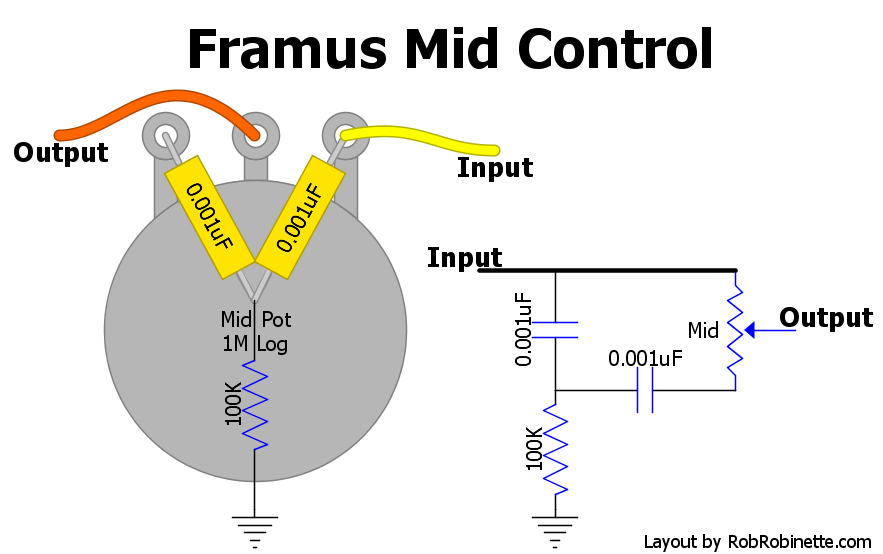
Simple but effective mid tone control. The caps and 100k resistor are NOT soldered to the back of the pot--that would ground them out.
The component values can vary from 100k to 1M for the tone pot, .01uf to .001uF (50 volts or higher) for the tone caps and 10k to 100k (1/4 watt or higher) for the resistor. A 100k resistor reduces the depth of the mid scoop and places a lighter load on the signal compared to a 10k resistor.
Connect the 100k resistor to your preamp ground bus. The Mid Control must be downstream of a coupling cap to keep high voltage DC out of the Mid pot.
If you break the connection between the caps and resistor or resistor and ground with a switch you can eliminate the tone circuit's effect by opening the switch. This is called a Raw Switch because it lets raw, unfiltered guitar signal through.
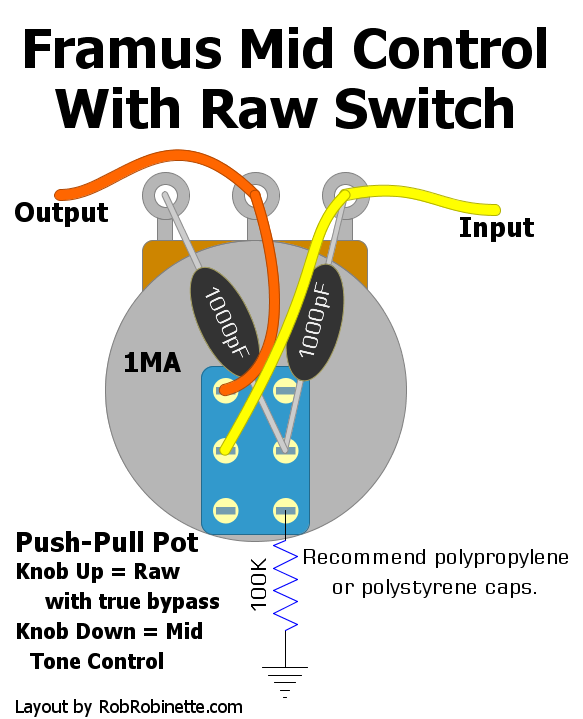
Push-Pull 1MA (audio) pot wired as a "Raw Switch." Pulling the knob up breaks the connection between the caps and resistor so the guitar audio is not filtered. Special thanks to "FenderLover" for the idea of the "true bypass" (two wires on the left side of the switch).
Baxandall or James TB Tone Stack
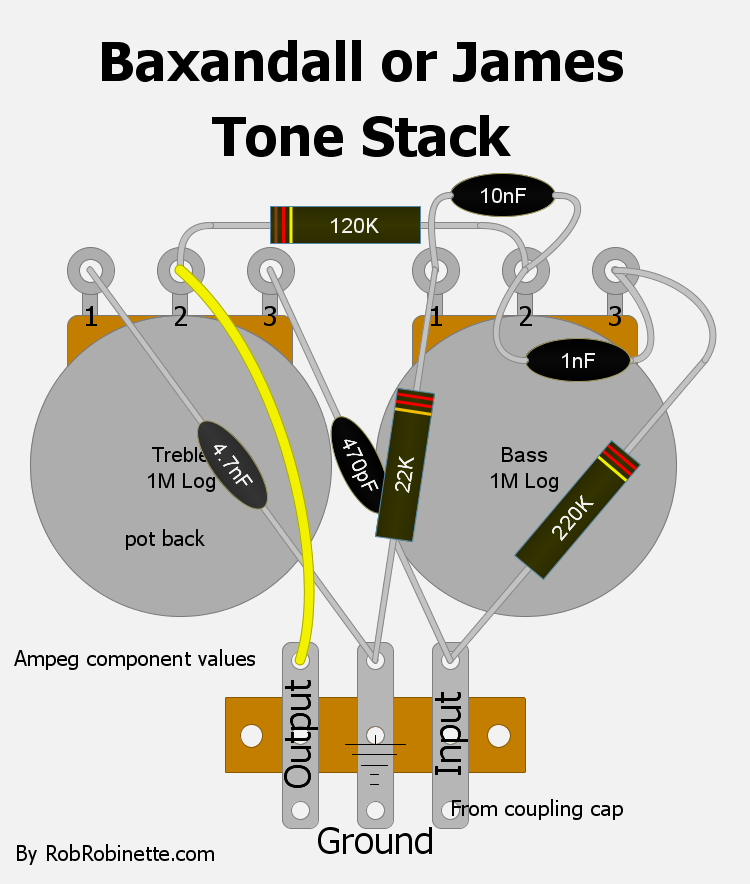
The James (or passive Baxandall) Treble/Bass tone stack allows more control with less quirks than the Fender/Marshall/Vox TMB tone. Unlike the Fender tone stack you can achieve a mid hump by setting the treble and bass controls low.
Note: The Baxandall or James tone stack must have a coupling cap between itself and a tube plate. It cannot function as a coupling cap like the Fender/Marshall/Vox TMB tone stack.
A 1MA Push-Pull Pot can be used as a Raw switch to effectively remove the tone circuit from the amp. When you remove the circuit's ground by pulling the Treble knob up all the tone shaping and circuit load disappear. More info on the tone circuit here.
Standby Switch 'Pop Reduction' and Current Surge Protection
One modification I highly recommend is a resistor across the Standby Switch terminals. It will quiet or eliminate the Standby Switch 'pop' by allowing a small current to flow around the Standby Switch to charge the Filter Capacitors. This prevents a current surge when you close the Standby Switch.
You should always ensure the Standby Switch is in the standby position before powering up the amp. Turn on the Power Switch then wait around 15 seconds for the tube heaters to come up to temp and for the pop resistor to charge the filter caps enough to prevent a current inrush which is what causes the pop. Preventing the current inrush will also make your filter caps last longer.
The Valve Wizard recommends a resistor between 47k (2watt) or 150k (1watt). I had a 100k 2watt on hand so I used that. Adding the resistor eliminated all pop for my 5E3. If you still get a standby pop you can install a .047uF 1000volt disk capacitor across the Standby Switch terminals (in parallel with the above resistor if you choose to install both).
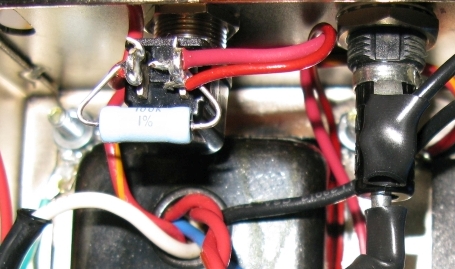
Pop Resistor (grey 100k 2 watt) across the Standby Switch
Bleeder Resistor
Another mod to consider is a 'bleeder resistor' to bleed the charge out of the big filter capacitors when power is removed. This is especially helpful when you test your amp with no tubes installed when the capacitor charge has no place to go and just sits there waiting to bite you. A bleeder resistor is a nice safety feature which can keep you from getting seriously zapped by your amp. Just solder a 470k 1watt resistor from the first filter cap's + lead to ground.
Rectifier 'Backup' Diodes
Installing two 'backup' diodes can extend the life of your rectifier tube and prevent a dying rectifier tube from frying your power transformer or amplifier circuit with high voltage AC. The backup diodes pre-rectify high voltage AC from the power transformer into pulsing DC and feed it to the tube rectifier which will power the amp and give you that loved tube rectifier voltage sag. The 20 cent 1N4007 diode has a 1000v peak-to-peak or 353v RMS peak inverse voltage (PIV) rating. The 5Y3 rectifier tube is rated at 1400vpp PIV or 495v RMS on each plate. Having two diodes in series (one solid state and one tube) will increase the rectifier circuit's peak inverse voltage to 848v RMS which should greatly increase the rectifier tube's lifespan. You're rectifier tube should outlive your amp with these backup diodes sharing the load. Here's a quote from the Valve Wizard's web page:
If we were worried about running a valve rectifier too close to its maximum Va(rms) [AC voltage rating], we could place one or more silicon diodes having a much higher peak inverse voltage in series with each anode, as protection elements. In theory, the valve rectifier can then be used with supply voltages up to twice the rated Va(rms). The silicon diodes will have no adverse effects on the normal operation of the valve rectifier.
I installed two 1N4007 diodes on the rectifier socket pins 3 to 4 and pins 5 to 6. Place the diode's stripe (cathode end) on the power outflow side (pins 4 and 6). I attached the power transformer high voltage output wires to the unused pins 3 and 5 (instead of the normal 4 and 6). The AC power then flows through the diodes to the plate pins 4 and 6. The diodes are cheap insurance and I install them in all my amps.
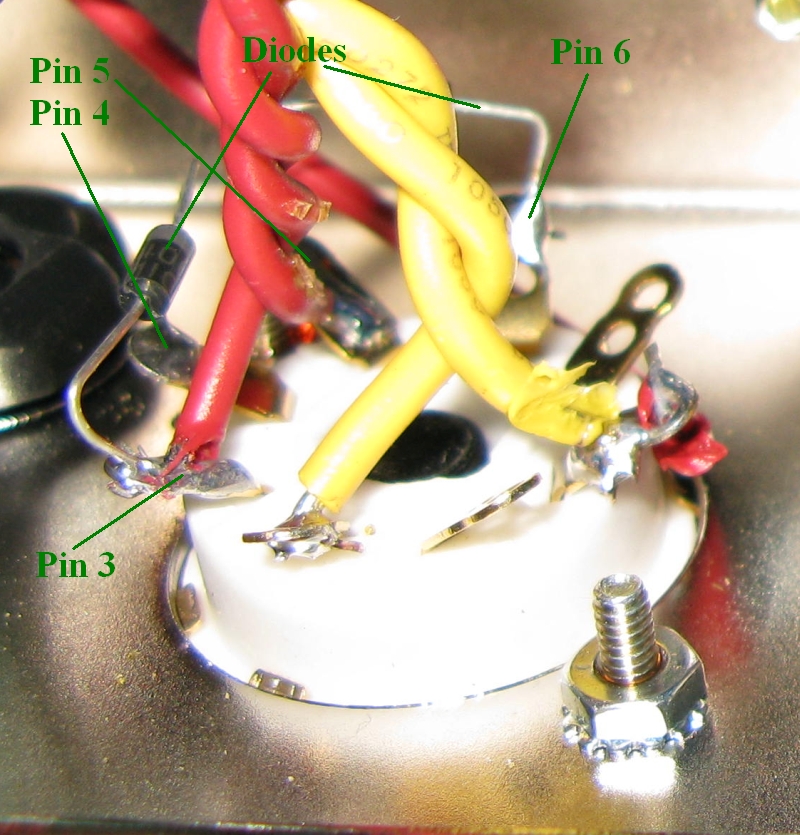
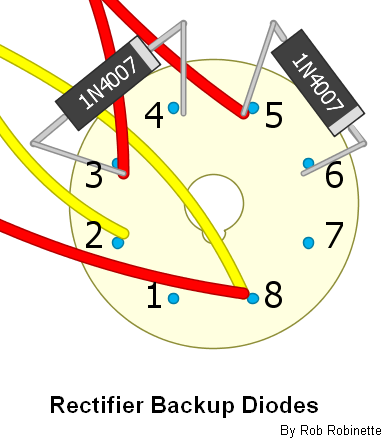
The stripe on the diode indicates polarity.
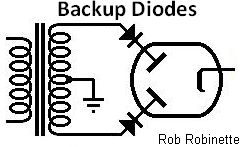
Installing backup diodes greatly increases the peak inverse voltage (PIV or reverse repetitive maximum voltage Vrrm) handling of the tube rectifier to extend the life of the tube rectifier. Should the rectifier tube fail and short out damaging AC will not enter the amplifier circuitry.
No Transformer Center Tap Hybrid Tube Rectifier
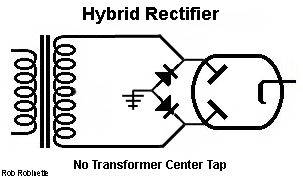
You can use a transformer with no center tap with a tube rectifier by installing the 'bridge half' of a bridge rectifier to provide a current return path. Two 1N4007 diodes running from the tube plate pins to ground will do the trick. Diode polarity is important, install the diodes with their stripes to the tube plates.
Hybrid Tube Rectifier With No Center Tap + Backup Diodes
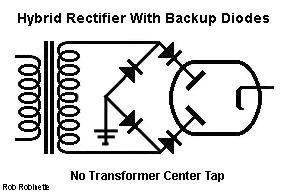
Simulate Tube Rectifier Voltage Drop and Sag Using a Solid State Rectifier and Sag Resistor
Voltage drop is the amp's no signal voltage drop caused by the rectifier. A solid state rectifier will only drop about 1.4 volts per diode used so its drop is usually 3 to 6 volts. A tube rectifier will drop more voltage than a solid state rectifier. A GZ34 will drop 10 to 15 volts more than solid state and the 5Y3 will drop around 60v more than solid state.
Voltage sag is the dynamic voltage drop that varies with current demand and causes compression of loud and quiet notes.
If your amp has a solid state rectifier we can simulate tube style voltage drop and sag by adding a sag resistor to the rectifier's output. To determine the value and watt rating of the sag resistor we need to know what type of tube rectifier we're trying to emulate (how much voltage drop do we want) and how much B+ current will flow through the resistor. We already know the 5E3 pulls about 80 milliamps of B+ current so we have that value. If you want to do this for another amplifier you can get a good estimation of B+ current with this online calculator.
Here's a chart from 300guitars.com showing different rectifier voltage drops:
So if we want to simulate a 5Y3 we need to drop about 60 volts.
The equation to determine the amount of resistance in ohms to drop a voltage is:
Resistance needed = Volts to drop / Amp B+ current = 60 volt drop / .080 amps = 750 ohms
Luckily 750 is a standard resistor size. The voltage drop from a tube rectifier is not linear and there's less sag at high demand so I recommend you always round down to the next standard resistor size.
The equation to determine power in watts is: Watts = Volts * Amps = 60 volts * .080 amps = 4.8 watts
We need to double the watts to cover ripple currant and to ensure the long term reliability of the resistor so I would use a 750 ohm 10 watt sag resistor to simulate a 5Y3 tube rectifier in a 5E3 with a solid state rectifier. The sag resistor would go between the solid state rectifier's output and first filter capacitor.
Add a Variable Voltage Regulator (VVR)
VVR installed in a fixed bias 5E3P Proluxe to scale the voltage of the entire amp. If adding a VVR to a 5E3 then just ignore the "Bias In" and "Bias Out" connections.
You can turn down the VVR for lower volume and not effect the tone too much. It's great for low volume practice. The VVR controls both the B+ and fixed bias voltages with one knob. If you have a standard 5E3 then you could use a VVR with no fixed bias control. Adjusting voltage with the VVR will also allow you to fine tune your B+ voltage so you can bias your power tubes in their sweet spot. This comes in handy when switching between 6L6 and 6V6 power tubes by using a higher voltage output GZ34 rectifier tube then use the VVR to set max voltage for the 6L6 and reduce the B+ voltage to keep from burning up the 6V6.
Other Ways to Reduce Your Amp's B+ Voltage
Modern wall voltages are higher than they were back in the 50's when Fender tweed amps were designed so today's wall voltages can increase your B+ by over 30 volts. Lowering your amp's B+ voltage can lengthen tube life and change its tone. You can do this with a rectifier tube swap. Here's a chart from 300guitars.com showing the different voltage drops:
My Rectifier Tube Comparison
| Solid State | JJ GZ34S | GT 5U4 | JJ 5U4GB | |
| AC in to Rectifier | 682v AC | 678 | 677 | 677 |
| B+ | 434v DC | 416 | 392 | 384 |
| Drop from Solid State | - | 18v | 42 | 50 |
| V2B Plate | 252v DC | 238 | 226 | 221 |
| V2A Plate | 206v DC | 195 | 185 | 181 |
| V1B Plate | 207v DC | 197 | 188 | 184 |
| V1A Plate | 201v DC | 190 | 182 | 177 |
| Power Tube Plate to Cathode V | 403v DC | 379 | 360 | 351 |
| Cathode Voltage Drop | 32.2v | 30.3 | 28.6 | 27.7 |
| 6L6GC Cathode Bias Output @ 4ohms | 17.9 watts | 15.5 watts | ||
| 6L6GC Fixed Bias Output @ 4ohms | 32.5 watts | 30.8 watts |
Notes: Wall voltage measured at 122.3 volts rms. Power Transformer rated at 330v-0-330v. No power tube cathode resistor bypass capacitor is installed.
My power transformer is rated at 330-0-330 volts but actually puts out 341-0-341 under idle load and an input wall voltage of 122.3v. With that I get 434 volts B+ with a solid state 1N4007 diode rectifier and 416v B+ with a JJ GZ34S rectifier tube (18v drop). I tried a Groove Tubes 5U4G to get down to a more 'vintage' B+ voltage. It gave me a 392v B+ (42v drop from solid state). A JJ 5U4GB dropped the B+ to 384 volts (50v drop) which is low enough to run 6V6 tubes in my 5E3 in both fixed and cathode bias modes. A standard 5Y3 would also lower the voltage enough for 6V6 tubes.
By simply swapping out the rectifier and power tubes and flipping the bias switch I can go from 5E3 Deluxe (6V6 cathode bias) to 6G3 brown face Deluxe (6V6 fixed bias) to 5E5 Pro (6L6 cathode bias) to 5E5-A Pro (6L6 with high power fixed bias).
It is also possible to drop your B+ voltage using a dropping resistor before your first filter capacitor. To take 20 volts off the 5E3's B+ you can use a 3 or 5 watt 220 ohm resistor (this applies to a standard 5E3). A standard 5E3 pulls about 80 milliamps of B+ so to determine the size of the resistor use these equations:
Desired voltage drop / amps = resistor ohms
20 volt drop / 0.080 5E3 amps = 250 ohm dropping resistor
amps * voltage = watts of dissipation
0.080 amps * 20 volts = 1.6 watts
So a 250ohm 3w or 5w resistor will drop your B+ around 20 volts. You could also use two 500ohm 2 watt resistors in parallel to get the same voltage drop because they are the equivalent of a single 220 ohm 4 watt resistor.
To find the B+ current for other amplifiers use this easy to use excellent power transformer calculator.
For cathode biased amps we can install Zener diodes on the power transformer center tap to lower the B+ voltage. The power transformer center tap is the return path for all the B+ current so it's a convenient location for controlling an amps voltage. Zener diodes do not cause voltage sag, they cut the voltage and hold it there. You can also use a resistor on the center tap but the voltage will sag with current draw--this may or may not be desirable.
For a single Zener diode solder a ring terminal to its cathode (striped) end and bolt it to your chassis ground bolt. Solder the power transformer center tap wire to the diode's other end. For 10 volt Zeners a 5 watt rating is all that is needed for most amps. You can also string together Zeners to drop more voltage:
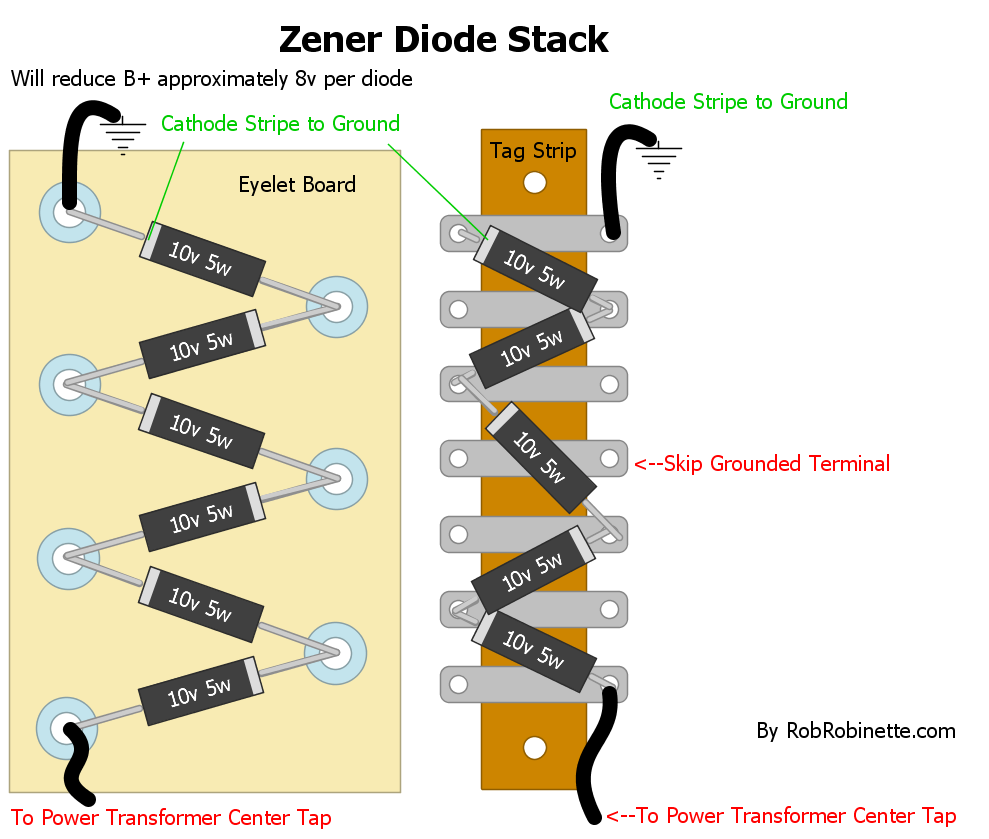
The diode stripe marks the cathode and negative end of the diode. The other end is the + anode.
For fixed-bias amps we need to connect the Zener string between the rectifier and the amp circuit, just like a sag resistor. We can't use the center tap as above because it will affect the fixed bias circuit because negative voltage bias current flows the opposite direction and doesn't get cut by the Zener.
Install the Zeners with their stripe (cathode) toward the rectifier, the other end (anode) toward the first filter cap. Since neither end of the Zener is grounded we can't bolt the Zener to the chassis for cooling so be conservative with your Zener watt rating--I wouldn't go above 10v for a 5 watt rated Zener.
One other option to lower B+ voltage is to build an inexpensive 'bucking' transformer to lower your wall AC voltage which will lower all the AC and DC voltages in your amp including the tube heater circuit. I use a bucking transformer for all my vintage amplifiers to lower stress from high voltage and to make them sound more period correct.
Cliff Jack Fender Style Wiring
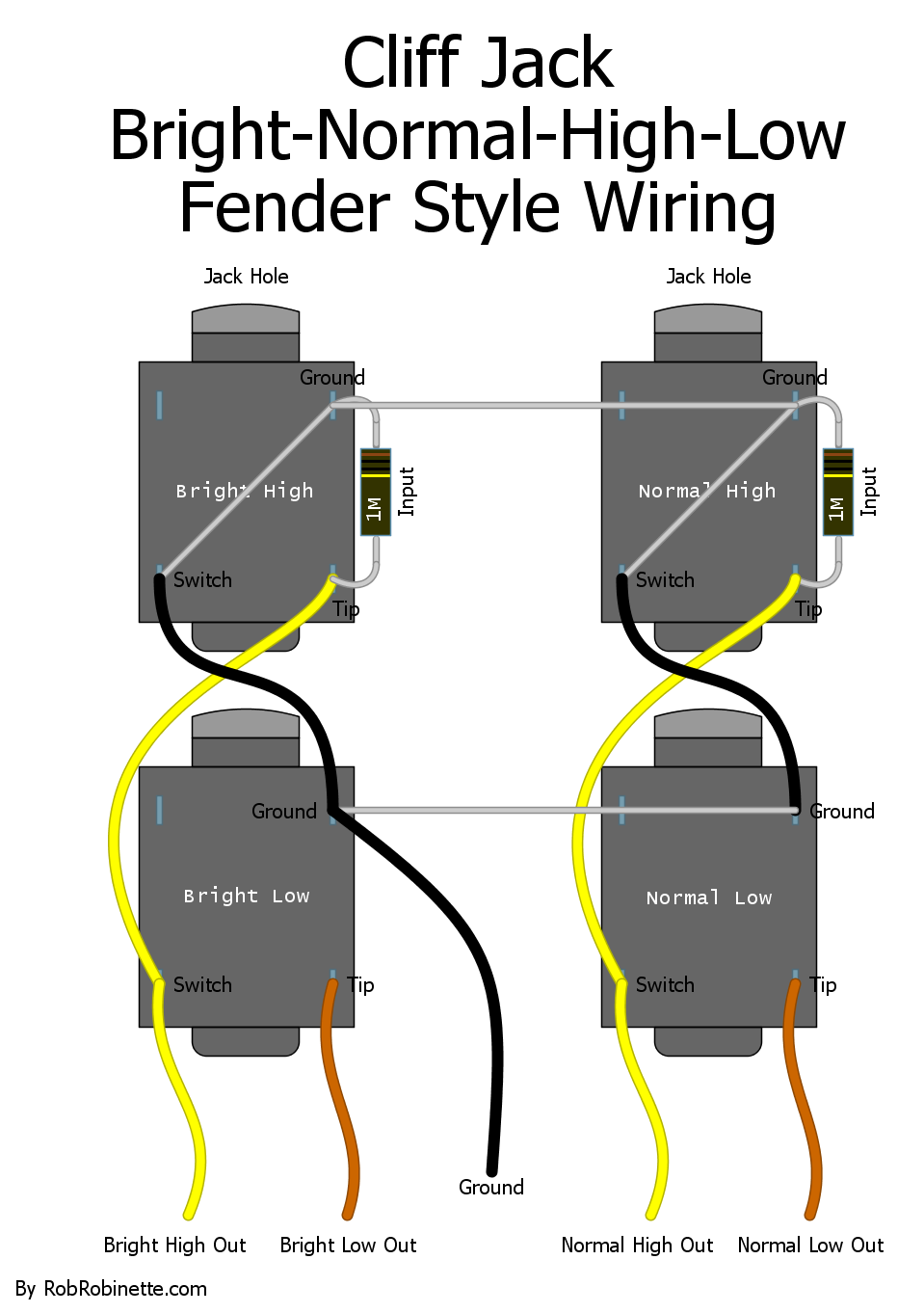
Cliff jacks are isolated from the chassis and must be grounded via a ground wire. View is from the rear with jack holes forward.
Use 2 Input Jacks Instead of 4
This is how to drop the two "Low" jacks from any amp with the standard Bright/Normal/High/Low four input circuit:
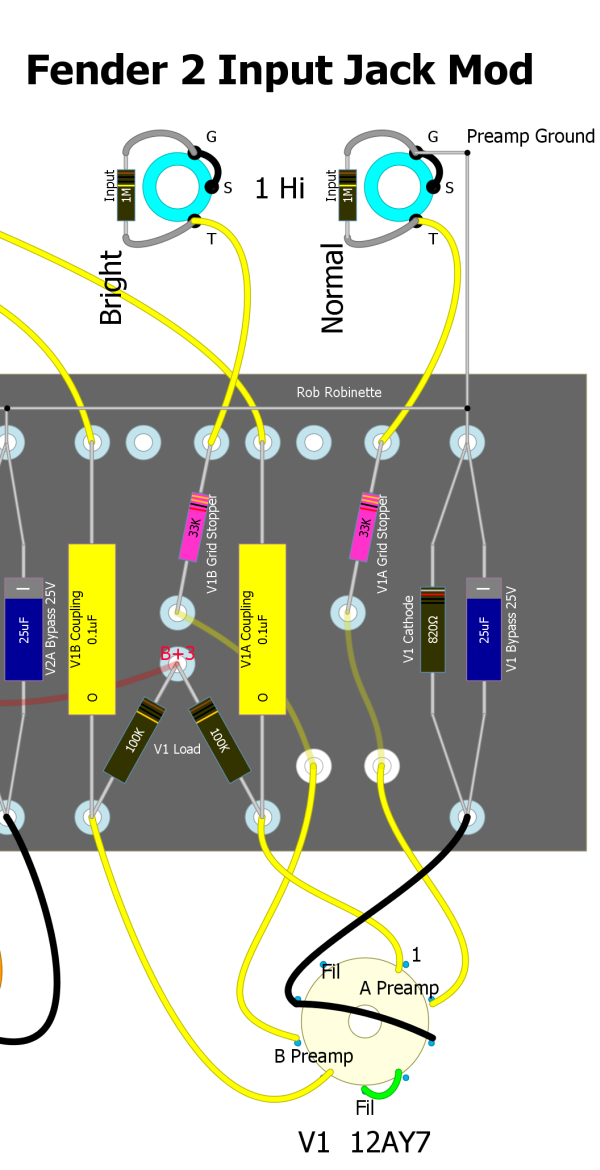
Note the grid stopper resistors (pink) were reduced from 64k to 33k because the Hi input jacks use both 64k grid stoppers in parallel for 32k of grid stop resistance.
Another option is instead of removing one 64k grid stopper resistor and changing out the other for a 33k as shown above, you simply run a jumper between the two 64k resistors so the signal goes through both for 32k of grid stop resistance.
Use 1 Input Jack Instead of Four
This switch will allow you to select Normal High or Bright High channel using just one jack.
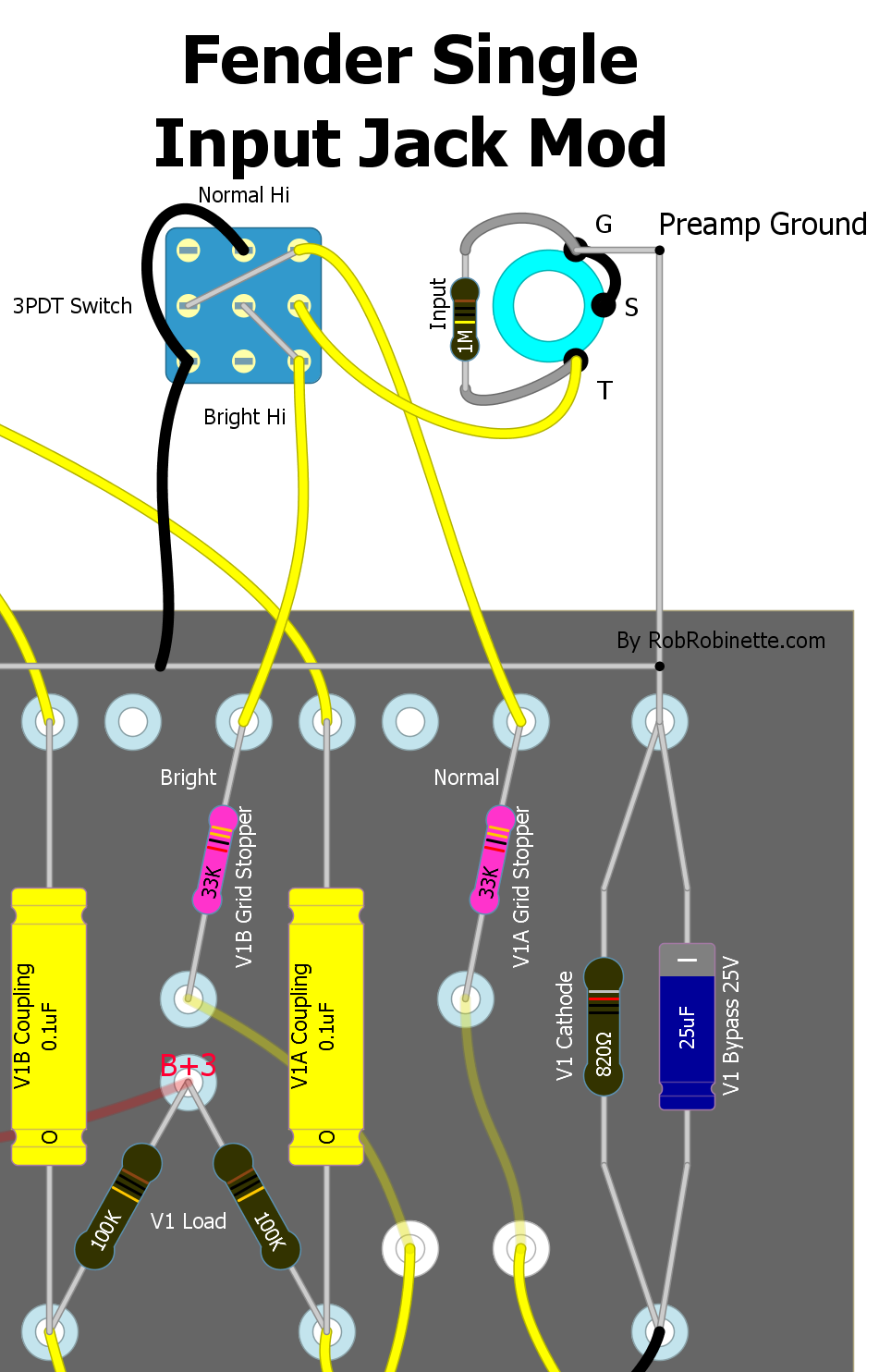
Note the grid stopper resistors (pink) were reduced from 64k to 33k because the Hi input jacks use both 64k grid stoppers in parallel for 32k of grid stop resistance.
Another option is instead of removing one 64k grid stopper resistor and changing out the other for a 33k as shown above, you simply run a jumper between the two 64k resistors so the signal goes through both for 32k of grid stop resistance.
Hi/Low Input Switch
This switch allows you to use one input jack and select Hi or Low output. The switch inserts a 33k/33k voltage divider which dumps half the guitar audio signal to ground--just like a standard Fender Low Input jack. With the switch open you have the High Input and switch closed you get the Low.
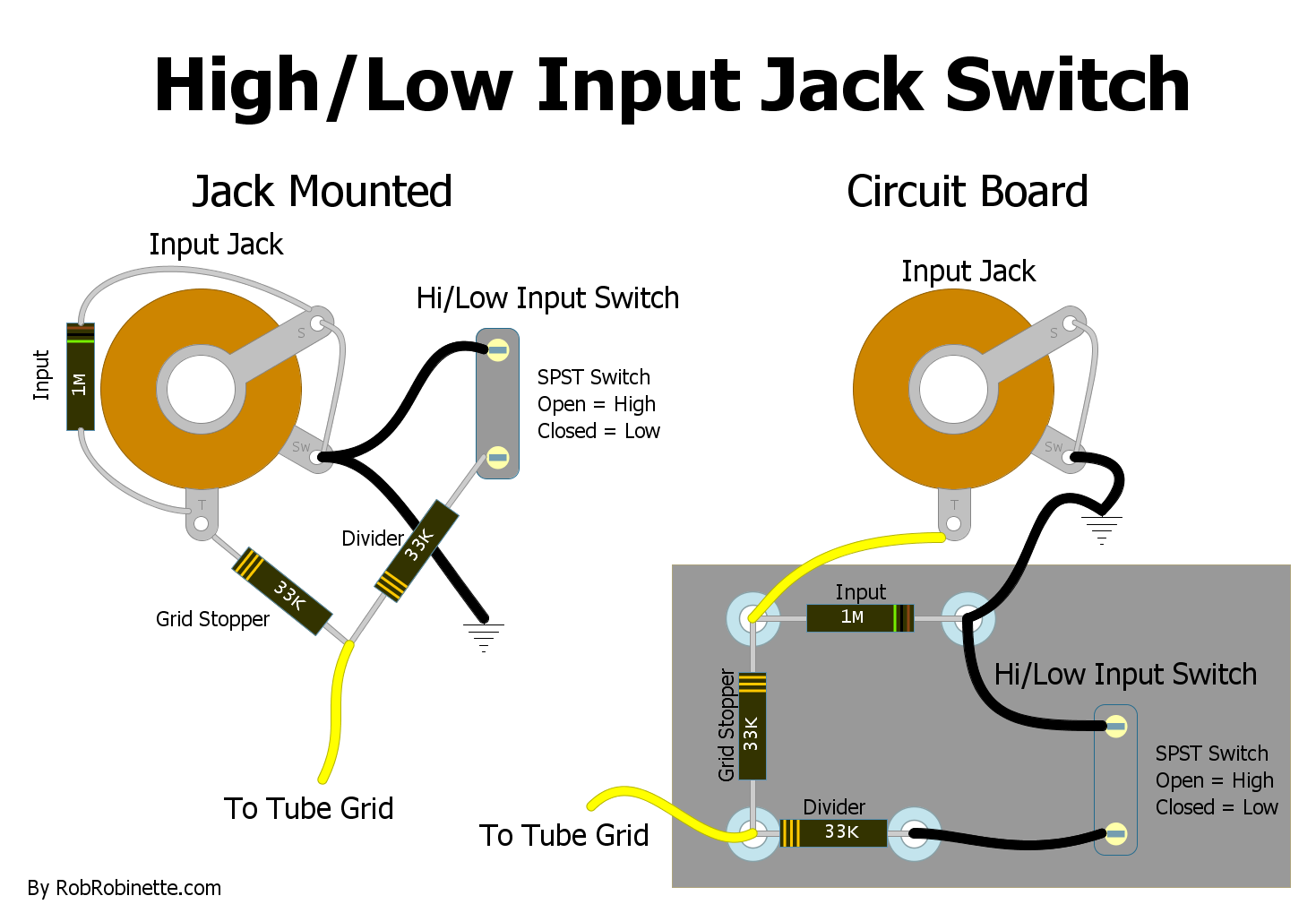
Jack mounted circuit on the left, circuit board version on the right. Download the high resolution pdf here and DIYLC file here.
In the High position input impedance is 1M and grid stopper resistance is 33k--exactly as the 5E3 Deluxe.
In the Low position input impedance is 62k (1M in parallel with 66k) and grid stopper resistance is 33k.
The factory 5E3 has a Low input impedance 138k and grid stopper resistance of 68k but this mod will give us a tone that's so close to factory that I'll buy you a case of beer if you can hear a difference.
Since channel jumpering is so common among Fender players this mod will let you leave your jumper cable at home and jumper the Bright and Normal channels with the pull of the Normal volume knob. You can plug your guitar into any jack and you will get a Hi jack-to-Hi jack jumper.
Just swap out the Normal Channel volume pot for a 1MA Push-Pull pot with DPDT switch (Bourns Model PDB183-GTR). If you prefer you can use a separate ON-ON DPDT switch to do the same thing. This switch will work on any amp that has Fender style four inputs (Bright/Normal/Hi/Lo).
Note the wires between both Hi Jack ground and switch terminals have been removed (or clipped).
With the Normal volume knob down the input jacks function normally with the jacks grounded when nothing is plugged in. Pull the Normal volume knob up and the two Hi jacks are jumpered together for a fatter tone. Your guitar signal will flow through both V1A and V1B preamp tubes in parallel which adds some texture and complexity to the tone. For more info on channel jumpering see this.
To install the switch first remove or clip both Hi jacks' wire that runs between their tip and switch terminals. Then remove the Normal volume pot and wire the three volume pot terminals normally. Wire the DPDT switch part of the pot as in the layout above and you're done.
5E3 Humbucker Switch
2-Way Humbucker Switch
High output pickups can tax the amplifier's power supply and cause low frequency "farting out." They can also push the phase inverter into unpleasant sounding double frequency distortion. You can prevent this by reducing the amount of bass passed by the coupling cap. You can modify just one channel and use it for high output guitars.
With this mod you use the Bright Channel and select the 22nF (.022uF) 630v coupling cap for humbucker guitars or the standard 100nF (.1uF) 630v cap for non-humbucker pickups. The switch is an ON/ON SPDT (Single Post Dual Throw) mini switch. The smaller value coupling cap will filter out some unwanted low frequencies.
The "Humbucker" position also works very well with high output effects pedals such as gain, reverb and delay.
For a 3-way option use an ON/OFF/ON SPDT mini switch and connect three 630v caps like this: 22nF/22nF/68nF (which is equal to .022uF/.022uF/.068uF)
3-Way Humbucker Switch
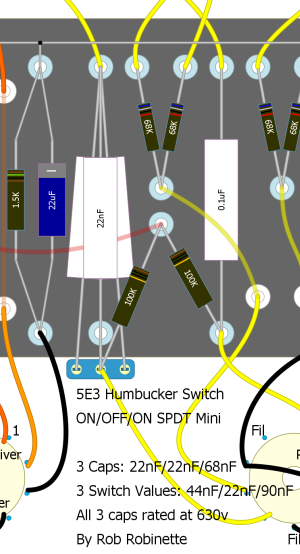
The mid switch position will give 22nF. The left position will give 44nF (22nF + 22nF). The right position will give 90nF ( 22nF + 68n = 90nF which is close enough to the 5E3 standard 100nF or .1uF).
Add a Simple Line Out Jack
This, along with a headphone jack, is a common mod request. Line outs work well for feeding effects boxes but don't work well for recording or amplification (unless the signal will be sent out a guitar cab) because an amp's guitar speaker does a lot of tone shaping, high frequency de-emphasis and adds speaker breakup distortion.
tdpri member mungus comments: The raw amp output sounds like crap until its passed through a guitar speaker to tone down the excessive high end - hence the need for some kind of cab simulator.
That's why using a microphone in front of the guitar amp's speaker is the most common way to feed a PA system. If you do go the microphone use a high quality instrument microphone placed 1/2 to 1 inch from the grill cloth and about halfway between the center and edge of the speaker cone for best tone.
With the cautions out of the way here is a very simple Line Out that does capture the tone and distortion of the entire amp except for the speaker.
Matchless Spitfire Line Out Jack
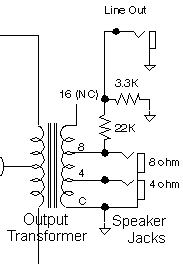
8 ohm speaker jack tip terminal tapped as signal source for the addition of a Line Out jack.
The Matchless Spitfire Line Out jack gets its signal from the 8 ohm speaker jack's tip terminal and the 22K ohm and 3.3K ohm resistors form a voltage divider to lower the signal voltage to line out levels. Of course the amp's output volume control will control the Line Out volume too--which brings up an important point. A speaker must be attached to the amp's speaker jack when using the Line Out to prevent output transformer damage. This tiny little circuit cannot load the transformer properly to run speakerless.
If you are cramped for space for an additional jack you can use your amp's 'extra' speaker jack or even add a small 3.5mm (mp3 player size) jack to save room. To convert the extra speaker jack replace the tip-to-tip green wire with the 22K resistor and add the 3.3K resistor.
You can replace the 22k resistor with a 250k reverse audio pot (wired as a variable resistor) as a line out level (volume) control. I recommend you also add a 5k resistor between the pot and either jack to set the max volume level. Run the level at minimum volume when not using the line out.
5E3 Line Out Jack
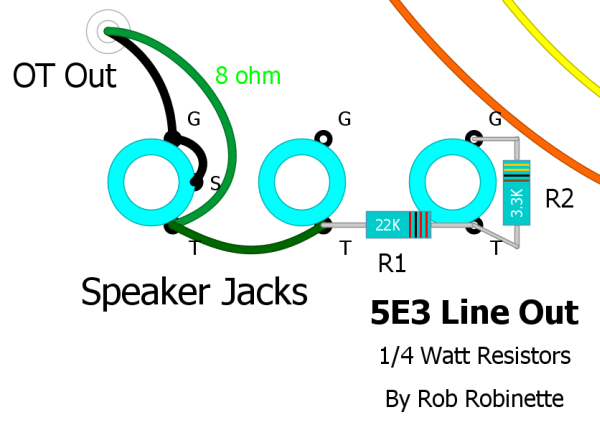
The resistors form a voltage divider and cut the speaker signal by 87%. In this layout the Switchcraft output jacks are self grounded to the chassis. If your output jacks are insulated then the Line Out's ground terminal will need to be connected to ground. The jack can be full size 1/4" or 1/8" (3.5mm) mp3 player size.
If you install the Line Out jack near the speaker jack you can use the 22K resistor itself to make the connection from the speaker jack tip terminal to the Line Out tip terminal. Then run the 3.3K resistor from the Line Out jack tip terminal to your Line Out jack ground terminal. If you use metal Switchcraft style jacks that ground themselves use a star washer to ensure a good Line Out jack ground. If your Line Out jack is insulated from the chassis then you must connect the Line Out jack's ground terminal to a suitable ground point.
The formula to calculate the % of attenuation is:
% Attenuation = 1 - R2 / (R2 + R1) * 100
% Attenuation = 1 - 3.3 / (3.3 + 22) * 100 = 87%
A more powerful amp like the 5F6A Bassman would need more attenuation so dropping R2 to 1K would give you 95% attenuation. Increasing R1 or decreasing R2 will give more attenuation.
Gerald Weber describes a Line Out mod specifically for the 5E3 in his book, A Desktop Reference of Hip Vintage Guitar Amps. He uses a 2.2K 1/2 watt resistor in place of the 22K and 100 ohm 1/2 watt in place of the 3.3K. His resistor values cut the speaker voltage by 95%.
Eliminate Volume Interaction
The Volume and Tone control interaction is part of the charm of the 5E3 amp but some people would prefer to simplify the operation of the amp. If you are new to the 5E3 I recommend you watch this excellent demo video of how to use the two volume and tone controls to get the most out of the amp before you do one of these mods. These modifications completely separate the volume and tone controls between the Bright and Normal Channels.
Simple Volume Interaction Mod
With this simple mod the Normal Channel looses its tone control altogether but remember you can control the tone with your guitar tone control. The Bright Channel's tone circuit is unchanged except for its interaction with the Normal Channel is removed.
With this mod you remove both wires connected to the Normal Volume pot's pins 2 and 3. We'll switch the pot's input and output to improve V1A's load impedance. Install two 220k ohm 1/4 watt mixing resistors on both volume pots' output pins. You have the option of leaving the Bright volume pot alone or you can swap its input and output also for optimal impedance loading as shown in the layout diagram below. It isn't as critical to swap Bright's input because the Tone pot adds load impedance for the Bright channel's V1B. Connect the resistors from each volume control pots' output pins to the solder pad that connects to tube V2's pin 2. The mixing resistors prevent volume interaction between the two channels.
Swap the volume pots' input and output and install 220k ohm 1/4 watt mixing resistors. This layout shows the Bright volume with its input and output swapped but its OK to not swap them.
Eliminate Volume Interaction With a Dual Gang Tone Pot
This mod is a little more complicated but both channels will have a tone pot as you replace the original tone pot with a dual gang 1M log (audio taper) tone pot so each channel has its own tone control (but one knob controls both tone pots). Another option is a dual concentric 1M audio pot which has a split knob and allows different tone settings for each channel. You can also use different value tone capacitors on each channel to fine tune.
The layout below shows both volume pots with their inputs and outputs swapped for optimum impedance loading for V1A and B but this isn't absolutely necessary because the tone pots add impedance to both channels.
Tone pot is replaced with dual gang 1M audio (log) pot. Mixing resistors on the volume outputs are used to keep the two channels from interacting.
Balance the Phase Inverter
The standard 5E3 Phase Inverter is slightly imbalanced due to where the cathode output was tapped. The plate resistor is 56k but the cathode has a 56k and 1.5k resistors which bring its load to 57.5k. This imbalance will push one power tube more than the other and create more 2nd order harmonic distortion (which can be a good thing for the overdrive tone). Moving the cathode output tap will balance the loads to 56k at the plate and cathode which can give the amp more actual output, increase headroom and clean up the overdrive tone a little. The results are subjective, some like it and some don't. The modern VHT 12/20 amps tap the phase inverter the same way as the 5E3 so this mod is probably not worth pursuing. When building a 5E3 it's a good idea to measure and match the phase inverter's two 56k resistors because carbon comp resistors can easily be 20% off their marked value. The more the two 56k load resistors differ the more distortion they will cause.
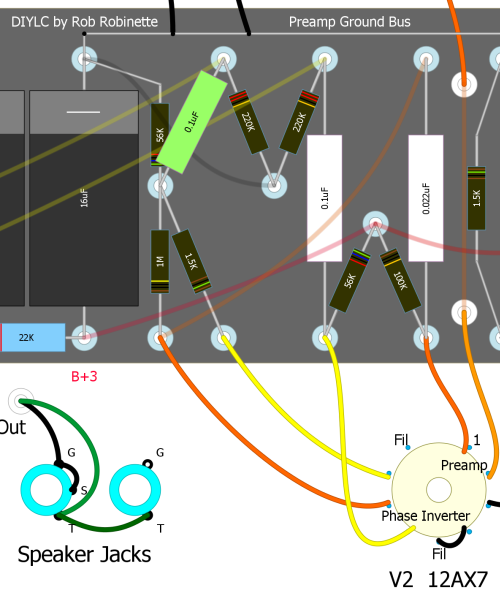
Coupling capacitor (shown green) lower connection point moved to tap the Phase Inverter cathode output to the junction of the 1.5k and 56k cathode resistors.
How to Lacquer a Tweed Cab
by Cab Maker Extraordinaire John Mergili of www.mergili.com
Go to Ace Hardware, Lowes, Home Depot, Wal-Mart...anywhere that has MINWAX Polyshades Honeypine. Get the regular, not the glossy.
Get a 3" paint brush.
Get four wood screws at least 1" tall.
Screw the screws in the cabinet bottom where you would put the feet.
Turn cab upside-down and brush a light coat on the tweed, then do the sides. When brushing, make sure to keep globs/pools of lacquer away from the tweed seams. Because the seams will act like a wick, and suck in the lacquer, giving a dark blotch. Soooo, brush very carefully. If you go too thick, it will make a black/grey blotch in the tweed.
Now, turn the cab upside-up and lacquer the top and sides. Countinuously check for brush strokes, runs and drips. You can even lacquer the inside bare wood.
Let each coat dry overnight.
Repeat this at least 3 times depending on how thickly you want to seal the tweed. I like it thick as glass.
Now, before your last coat, get a fine grade sanding sponge, and with light/medium pressure, sand the whole cabinet. Get a damp rag a wipe off all the lacquer dust.
Now take a block of wood or small hammer and tap all the corners down to get any tweed threads and burs smooth.
Do your final coat as normal.
Let dry.
Admire your work.
Oh yeah, do the back panels the same way. But don't put any screw holes in them till your done lacquering.
-----------------------
Many people use a 50/50 mix of MINWAX Clear and Honey Pine for a lighter tone.
If you are interested in using old fashioned shellac take a look at Marsh Amps shellacing technique.
Other 5E3 Modifications to Consider
Make the 5E3 more humbucker friendly by changing the Bright Channel's cathode circuit to a 2.2KΩ resistor & .68µF bypass capacitor. Run humbucker & hot pickup guitars through the Bright Channel. Try the Bright Channel's Low input jack to help tame really hot pickups.
Use a larger power tube cathode resistor, 270 to 330Ω 10watts (250Ω 5w is standard) to compensate for higher wall voltage and cool the power tube bias. I highly recommend you or your tech measure and calculate the power tube bias before making this change. Fender tended to bias their cathode bias amps around 95% of maximum idle dissipation and you shouldn't exceed 100%.
Add 470Ω to 1.5k 3 watt screen resistors to protect the power tubes from excessive screen current. Most amplifiers have screen resistors installed for this purpose. These resistors have the added benefit of increasing power tube distortion caused by overdrive screen current. You can use a small terminal strip to anchor the resistors and solder them directly to the V3 & V4 pins 4 as shown below. See Tube Guitar Amplifier Overdrive for more info on how they affect the amp's tone.
Screen Resistors Added to Power Tubes

Increase the power tube grid stopper resistors from 1.5kΩ to 5.6k to eliminate 'gain spike' and blocking distortion. This will not affect the tone or audible frequency response of the amp. 1.5k and 5.6k seem popular with modern amp designers.
Replace the 4.7KΩ dropping resistor between the first and second filter capacitors with a 5 to 12 Henry choke and add 470Ω to 1.5k 3 watt screen resistors shown above. This mod reduces noise but realize it can really change the 5E3's character by tightening it up and giving it a more modern punchy tone. Most people that have tried this mod have removed it for that reason.
Use a larger first filter capacitor, up to 33µF is ok even with a 5Y3GT rectifier tube. This will reduce hum and beef up the low end and help prevent 'farting out.' It will also reduce power supply sag and make the amp a little more punchy.
Lower all the coupling cap values from .1µF (100nF) to .022 to reduce bass which will reduce the 'farty' lows and make the amp more agreeable with high output guitar pickups and effects pedals. The famous AB763 blackface circuit used .022uF for the Vibrato Channel and .047uF for the Normal Channel. You can also do this only on one channel and then run humbucker guitars on that channel. Doing this also will reduce blocking distortion.
Fender guitar amp fuses are MDL type "slow blow" or "time delay" 1/4 inch (6mm) wide by 1 1/4 inch (30mm) long.
Replace all the signal resistors (especially input, plate load, grid leak and grid stopper resistors) with metal film resistors like the Vishay RN65 for less noise (hiss). Most 5E3 kits use period correct carbon composition resistors but metal film resistors generate 1/10th the noise of carbon comp. In reality resistor hiss is usually drowned out by filament heater hum and power supply ripple so this won't be a dramatic improvement but every little bit helps with noise suppression. If you want to be thorough then replace every resistor except these three: the higher watt rated voltage dropping resistors (between the first filter caps) and the power tube cathode resistor. R.G. Keen recommends metal film for all signal resistors except for the 5E3's 56k plate load and 56k tail resistors of the V2B phase inverter. Those two 1/2 watt carbon composition resistors would ensure "vintage" carbon comp tone without generating excess noise.
Building a 5E3 amp head? Consider a hybrid head/combo with the addition of a little 6" Eminence 620H hemp coned speaker to your head amp. The 620H is an inexpensive but great sounding speaker that punches above its weight. It requires no additional cabinet size and it adds very little weight. You'll always be able to practice with it and people freak out when a meaty tone emanates from a "speakerless head amp."
Stealth Eminence 6" 620H 20 watt Hemp Coned Practice Speaker
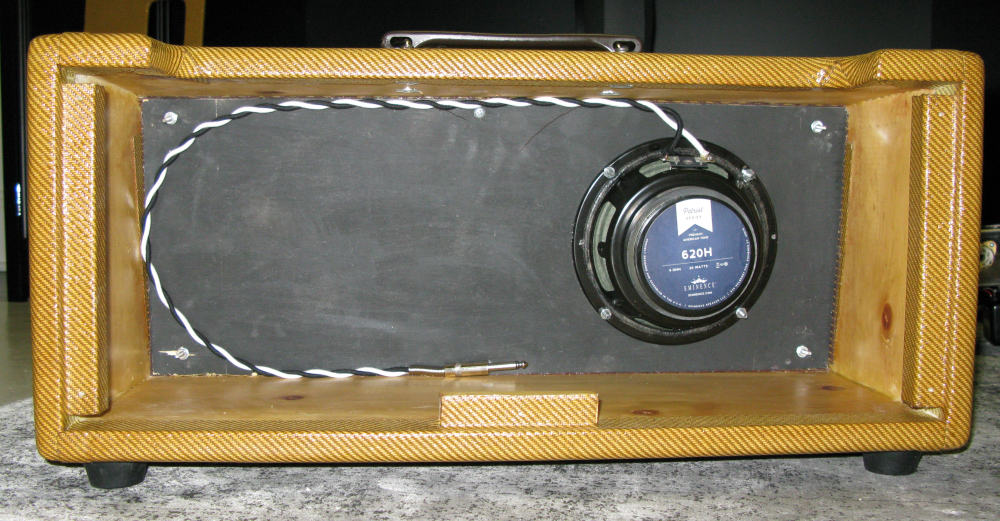
This is a very cool little $55 speaker. It adds very little weight to the head cab. It's mounted on the preamp side to clear the transformers. The custom lacquered tweed cab with baffle was made by John Mergili of www.mergili.com and cost only $259 delivered.
Wish your tweed amp had reverb and tremolo like the blackface amps? This is a great way to add it, with my favorite pedal of all time, the Strymon Flint. It does everything from adding a little warmth and thickness to full up 60's surf. The "Color" control is a very usable tone knob. The '61 harmonic tremolo setting is a really nice bonus that sounds very much like the very complicated harmonic tremolo circuit. Try this surf setting and you'll have a blast:
Surf City
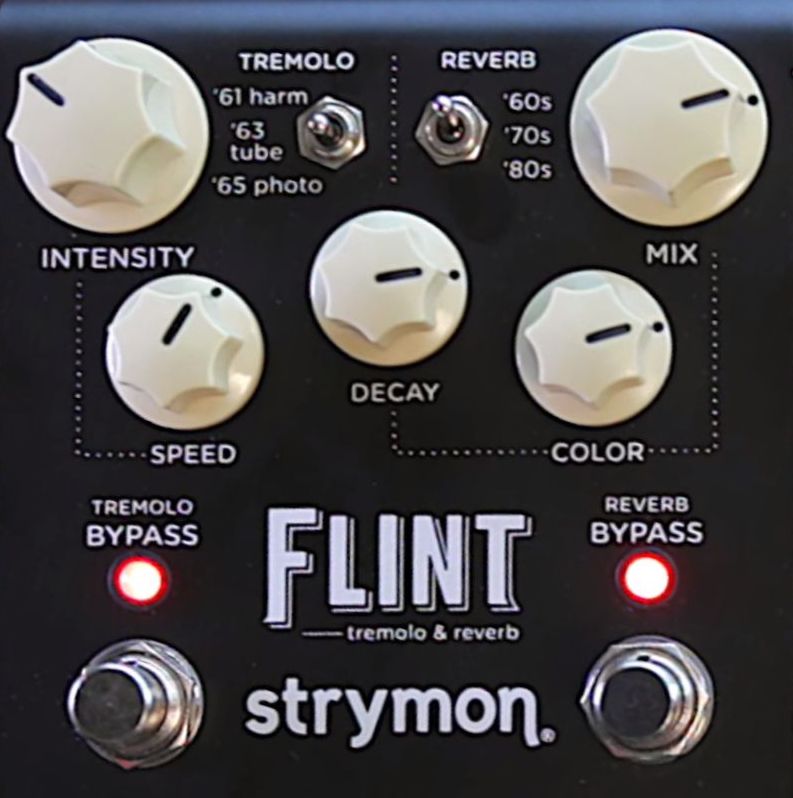
This Strymon Flint + 5E3 = surf heaven. Use the above knob and switch settings for a wonderfully authentic surf tone. Switches are set for '63 tube tremolo and '60's reverb. Here's an excellent youtube demo by 60Hz Hum.
Heater Artificial Center Tap
Install a 6.3v filament heater artificial center tap (sometimes called "artificial ground"). If your 5E3 power transformer did not come with a 6.3v heater center tap then you should add an 'artificial center tap' to reduce 60Hz heater hum. It does this by balancing the voltage between the two heater wires. When each wire carries an equal AC voltage 60Hz hum will be cancelled out by twisting the heater wires. Unbalanced voltage will allow some hum to leak out. If your power transformer has a 6.3v center tap then I recommend you use that instead of this 'artificial center tap,' but do not try to use both real and artificial center taps together.
You simply connect both 6.3v green heater wires to ground through two 100ohm 1/2 watt resistors. I like to place the resistors on one of the power tube's socket as shown below.
Filament Heater Artificial Center Tap
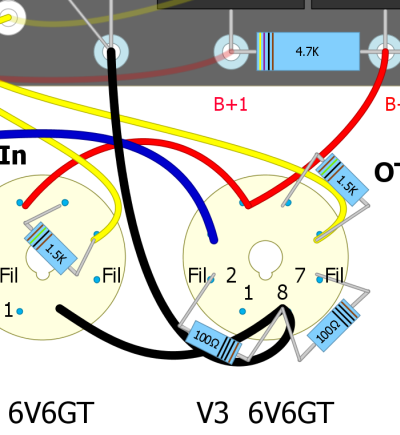
Filament heater artificial center tap consists of two 100 ohm 1/2 watt resistors connected between either one of the power tube socket's pins 2 and 7 (heater wires) and pin 8 (cathode). This works in both cathode bias amps (elevates the heater ground) or fixed bias amps (grounded cathode). Do this only on one power tube. These resistors are not required if your power transformer has a 6.3v center tap.
Humdinger Adjustable Heater Artificial Ground
The Humdinger is an adjustable heater artificial ground. A 100 or 250 ohm, 1 watt or greater linear pot is used to adjust the resistance value between ground reference and the two heater wires to even out their voltage and minimize 60Hz heater hum. You simply adjust the pot by ear for least hum. If you don't notice a change in hum when adjusting the Humdinger then just set it in the middle of the pot travel to equalize the resistance for each heater wire. Remove your current 6.3v center tap before installing a Humdinger.
You can connect the Humdinger to the heater wires anywhere along the heater wire chain. You can use the pilot light or tie it into any one of the tube's heater terminals.
For cathode biased amps you can connect the Humdinger's ground wire to a power tube socket cathode pin (pin 8) or to the hot side of the cathode resistor (as shown in the next section) to elevate the heater reference voltage. A voltage elevated Humdinger can eliminate more heater hum than any other type of heater real or artificial center tap.
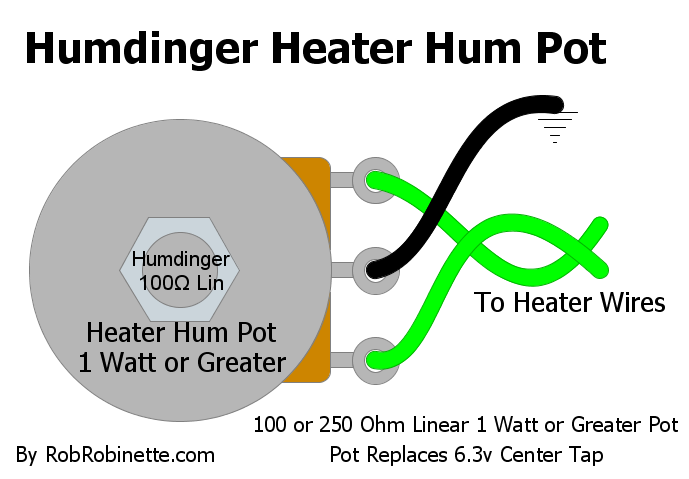
250 ohm linear pot is used to balance the voltage on the two heater wires for minimum hum. A 100 ohm linear pot will work fine too. The pot needs to be rated at 1 watt or higher. This 100 ohm, 5 watt pot is perfect as a humdinger. Instead of connecting the center terminal to ground as shown, connecting it to a cathode biased amp's cathode resistor will elevate the center tap and reduce hum.
Elevate 6.3v Heater Center Tap
If your power transformer has a 6.3v center tap, instead of grounding it to the chassis you can elevate the heater circuit ground reference voltage by connecting the 6.3v center tap to the tube side of the power tube cathode resistor. This elevates the heater ground reference by the voltage on the cathode which is around 17 volts in the 5E3. The elevated heater ground reduces the voltage difference between the heater filaments and the tube cathodes which helps minimize 60Hz heater hum.
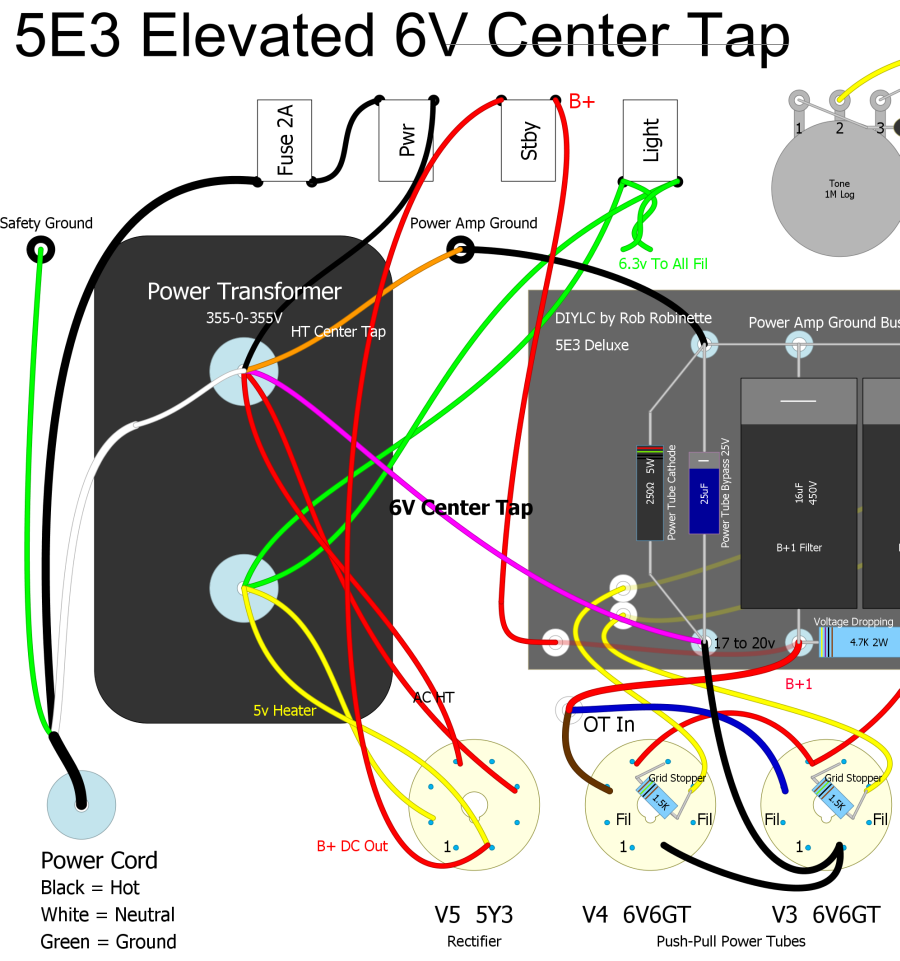
Power transformer 6.3v center tap (shown in magenta) is connected to the hot side of the power tube cathode resistor.
LED Pilot Light
This simple circuit powers an LED from the 6.3v heater wires.
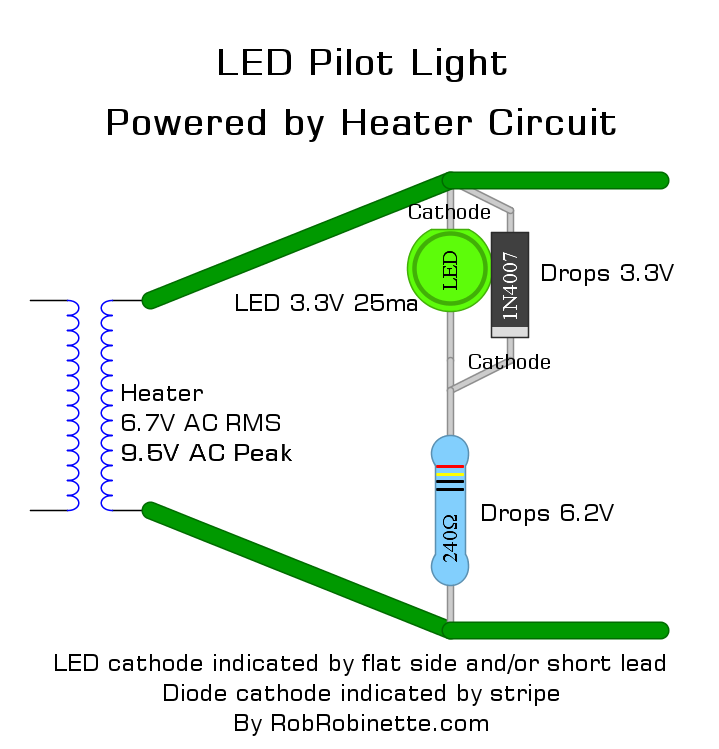
Just use any 1N4001 to 1N4007 diode, an LED and a 240 to 1000 ohm 1/2 watt (or higher watt rating) resistor connected across the heater wires. Note the LED and diode are lined up with their cathodes opposite one another. The diode has a stripe on its cathode end, the LED's flat side and/or shorter wire lead is the cathode so wire the LED's short wire to the diode's non-striped end. 6.7VAC is used due to higher than spec mains voltage.
The diode limits the LED's reverse voltage to 1.7v. The resistor drops excess voltage. The voltage drop of typical LEDs runs from about 1.8v to 3.3v and varies by the color of the LED. A typical red LED drops about 1.8 volts and rises as the light frequency increases. Blue LEDs drop around 3.3 volts. You can reduce the value of the resistor to brighten the LED if it appears dim. A higher resistor value will dim the LED.
Here's how to calculate the exact values needed for your particular LED:
Find your LED's voltage and current requirements. 3.3v and 25ma is typical.
We start with converting the heater voltage in rms to peak voltage. Your volt meter gives rms. Typical real world heater voltage is around 6.7 AC volts RMS * 1.414 = 9.5 volts peak.
Calculate excess voltage: 9.5 volts - the LED voltage drop of 3.3v = 6.2v
Calculate resistor value needed to drop excess voltage: excess voltage / led current = 6.2v / .025 amps = 248 ohm resistor (240 ohm is closest standard value)
Calculate resistor watt value: (LED current)^2 * 240 ohms = .025 * .025 * 240 = .15 watts so a 1/2 watt resistor will have some breathing space.
This LED would probably light up nicely with any resistor value between 240 to 1000 ohms.
Optimized 5E3 Layout
This is my take on the best possible layout for a standard 5E3 chassis. This is a basic 5E3 circuit, there are no modifications that will affect the tone. I have deleted the totally unnecessary Standby Switch and Ground Switch/Death Cap.
Gray resistors are metal oxide, brown resistors are carbon film and the V2A plate load resistor is carbon composition for mojo. Click on the layout to see the full size image. The .diy file is here and the pdf is here.
You can upload this DIYLC Hoffman Board file to Hoffman Amps and he can make a turret or eyelet board.
Shielded cable is used to connect the grid stoppers directly (across the chassis) to V1. The cable shield is grounded to an input jack ground tab. The V1 end of the cable is not grounded to prevent a ground loop. A nice, clean option is to use shielded microphone cable which has four conductors and run both input wires through one microphone cable. Shielded cable isn't a necessity in the 5E3 but if you use standard wire I recommend you run it along the chassis floor and below the circuit board to allow the chassis act as a noise shield.
Separate eyelets are provided for the preamp tube cathode resistors and bypass caps to make mods easier. The B+3 filter cap is moved to supply V1 directly. The V2A coupling cap is reoriented to reduce cable runs. Wire routing is optimized for shorter runs, 90 degree wire crossings and maximum separation between grid and plate wires.
The choice of resistor is up to you but I recommend 1 watt carbon film for the signal path. Carbon film resistors generate much less resistor hiss compared to carbon composition resistors but I did use a carbon comp (1 watt preferred) resistor on the last plate load resistor before the negative feedback loop for a little carbon comp mojo. The power resistors are shown above in gray and are metal oxide resistors. A 10 watt 250 ohm cermet resistor is used for the power tube cathode for longevity and compatibility with 6L6 power tubes. The power tube cathode bypass cap is upgraded from 25v to 50v for component longevity. The plate load resistors are bumped up to 2 watts for less hiss and longevity and the voltage dropping resistors are upgraded to 3 and 5 watt metal oxide also for longevity.
I employed a unified ground bus that is only grounded at the Normal Low input jack. The power transformer high voltage center tap is connected directly to the B+1 filter capacitor negative terminal to minimize hum. The typical split-bus ground sends all the preamp return current through the chassis. This ground scheme doesn't flow any current through the chassis which any electrical engineer will tell you is a good thing.
The 6.3v center tap is connected to the tube side of the power tube cathode resistor to elevate the reference voltage to reduce hum. If you want to use an artificial 6.3v center tap then I recommend putting the two 100 ohm 1/2 watt resistors on the V3 power tube socket like this.
I also shortened up the component span to keep from stretching the small component leads so much.
I added optional 3 watt carbon film power tube screen resistors to the circuit board. They are shown on the circuit board between the power tube cathode resistor and the B+2 filter cap. I add them to all my 5E3 builds because they help protect the tubes during heavy overdrive and they sweeten the power tube distortion. If you choose to use them then do not use the red wire that runs from the B+2 cap to the power tube pins 4, use the wires from the top of the screen resistors to pins 4 instead.
Do not twist output transformer primary or secondary wires. Doing so can cut hurt high frequency response.
Optimized 5E3
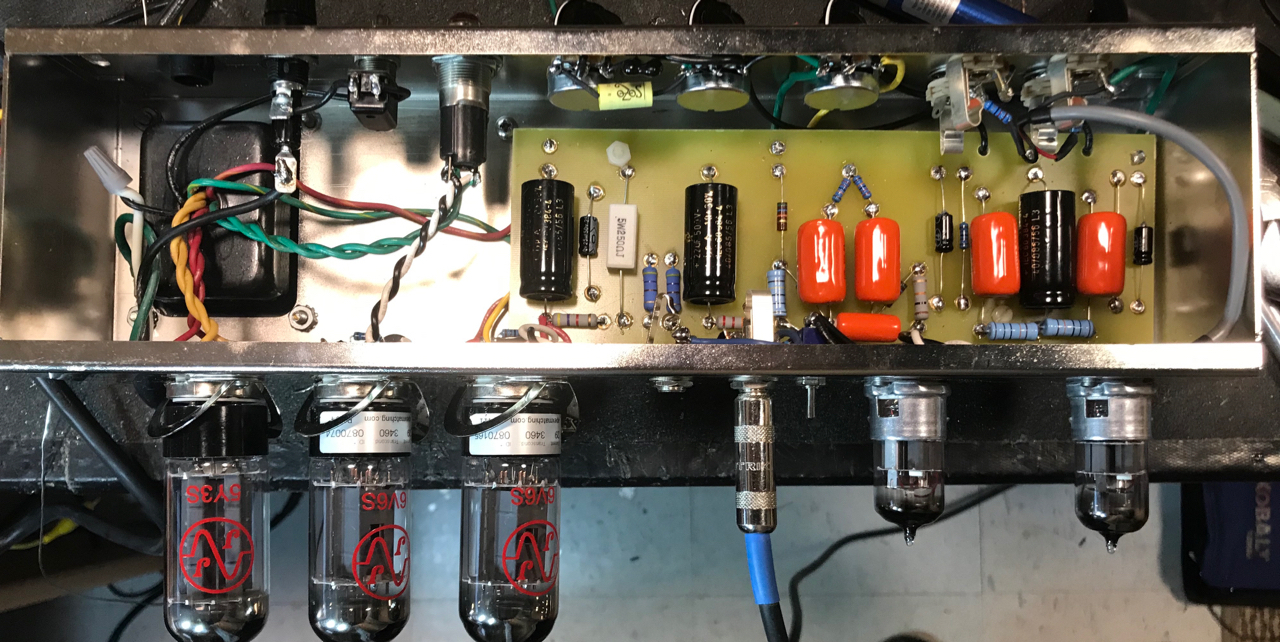
Amplifier build and photo by Derryck Wilson.
Quote From builder Derryck Wilson: I got a little bored so I built a Deluxe based on your optimized layout and I gotta say it is unbelievably quiet!! I’ve built over 20 5E3s and this is by the far the quietest of all, and from I’ve heard so far sounds just as good. Only tone mod is the NFB mod, but I’m thinking a Master Volume in the standby hole might be doable with this layout.
5E3 Point-to-Point Layout
This point-to-point (PTP or P2P) layout is intended for a blank Hammond style chassis or a "cake pan" build. You've got to keep everything pretty close together to make PTP work. Keep in mind you can build in "3D" with point-to-point and elevate some components up, over the top to avoid component crowding.
If you want to build your 5E3 Deluxe Old, Old School. Point-to-point wiring minimizes wires by using components to make connections when possible. Click on the layout to see the very large, full size layout. Components are anchored to the chassis with terminal tag strips.
For more info see the 5E3 Point-to-Point page.
RobRob Deluxe Amplifier
Take a look at this 5E3 Deluxe with many of my favorite modifications incorporated:
See the RobRob Deluxe page for more info.
Single vs. Split Ground Bus
The split ground bus with a separate power amp and preamp ground bus is the current standard that DIY amp builders use. That's what I show in the 5E3 layout at the top of this webpage but most electrical engineers will tell you a single point grounding scheme should be the quietest. The original 5E3 used a brass plate under the input jacks and pots that acted as the whole amp's ground bus but corrosion between the steel chassis and brass plate can cause problems in the long term.
Here's a single ground bus scheme that theoretically should be superior and keep the EE's happy:
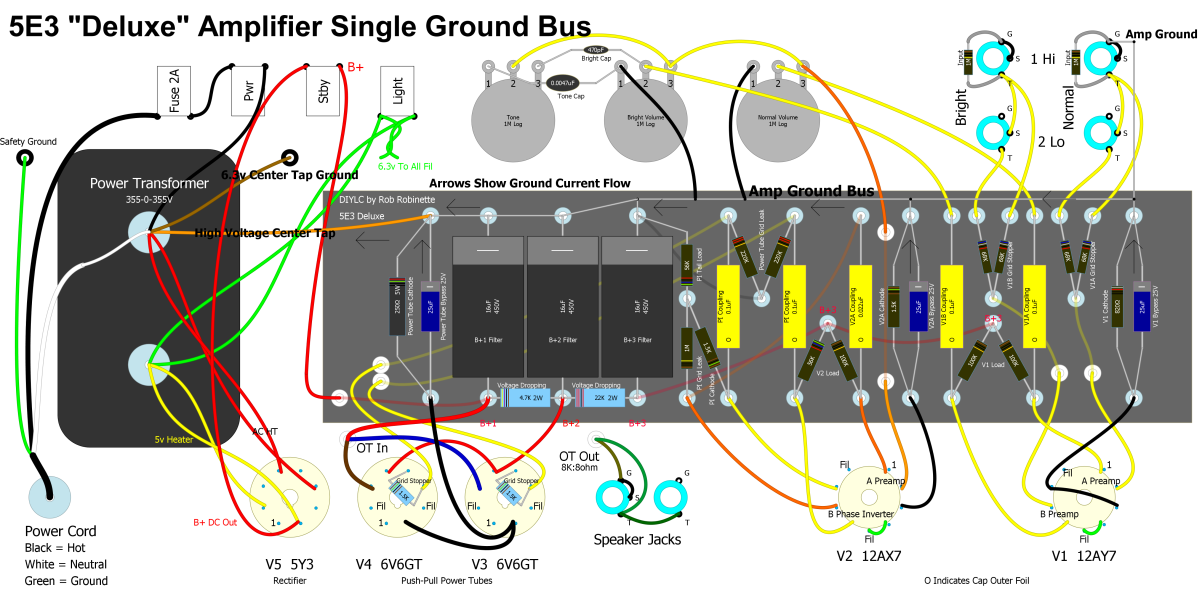
The only chassis ground point is the guitar input jack at upper right so be sure and use a star washer on that jack for a good electrical connection between jack and chassis. The power transformer's high voltage center tap is connected to the left end of the amp ground bus. Arrows show the flow of ground current through the ground bus back to the power transformer. All DC current must return to the power transformer through the center tap. The 6.3v heater center tap is connected to the upper right power transformer bolt. The 6.3v center tap acts only as the heater voltage ground reference and does not function as a current return. The speaker jacks are grounded to the chassis for a hum reducing ground reference--this ground connection does not function as a current return.
If you try the single ground bus and then want to try a split bus you can convert the single ground bus to split by simply clipping the bus wire between the second and third filter caps and then run a wire from the left side (power amp) ground bus to a power transformer chassis bolt.
VHT Standard 12 With True Star Ground Bus
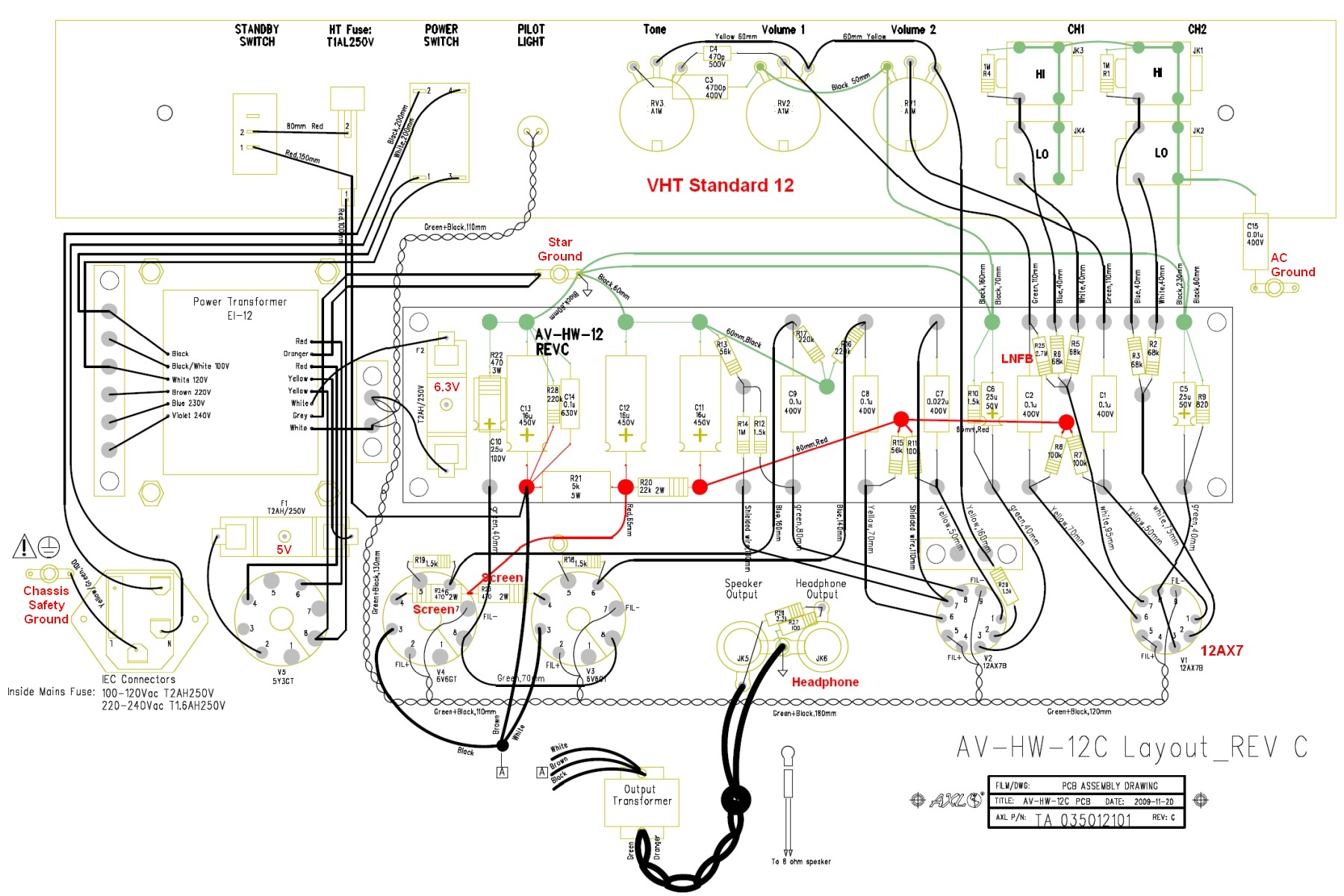
The VHT Standard 12 is a modified 5E3. Star ground point is center left. Ground wires shown in green. Note the input jack AC ground connection at capacitor C15 (upper far right). Input jacks are isolated Cliff jacks. Speaker jacks are not isolated.
Typical 5E3 DC Voltages
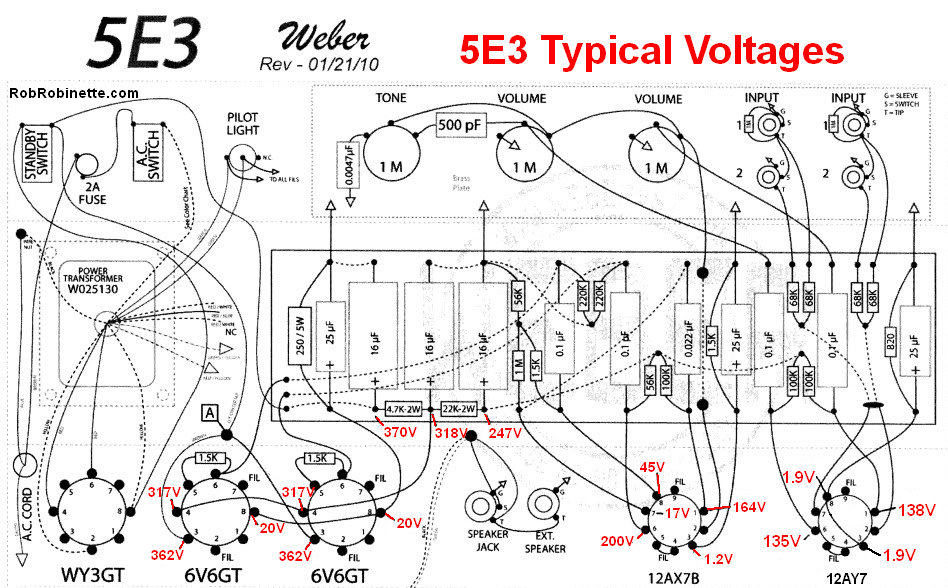
Note: The V2 pin 7 voltage will be around 3 volts if you use an inexpensive volt meter that has 1M of impedance. If you measure 3 volts on pin 7 and pin 6 and 8 match the voltages shown above then you're OK.
Typical 5E3 B+ Idle Currents
V1A 1.1ma
V1B 1.1ma
V2A .83ma
V2B .84ma
V3 39ma (includes 1ma of screen current)
V4 39ma (includes 1ma of screen current)
Total: 81.9ma
Speaker Suggestions
Since the 5E3 puts out around 12 watts of power a speaker rated for 20 watts is adequate. It seems the most popular 5E3 speaker is the 20 watt Weber 12A125A which is a Fender tweed vintage style 12" AlNiCo (Aluminum, Nickel and Cobalt magnet) speaker with a 1.25 inch voice coil for a very reasonable $113. It gets great reviews and gives probably the most authentic 50's Deluxe tweed tone. I installed one in an extension cab and it really does sound like a tweed Deluxe should.
If $113 is too rich for your blood check out the Weber Signature AlNiCo 12 and 12S speakers at $58. Some people actually prefer them over the 12A125A. The Signature speakers are also reported as being less efficient than the 12A125A so they won't be quite as loud. The Weber 12A150 (larger 1.5 inch voice coil) and 12A125S (1.25 inch voice coil but with slightly different voicing) are also popular for the 5E3. If you do go with Weber I recommend you have them do their free speaker break-in service for you so they will sound great right out of the box.
The $60 20 watt WGS G12Q also gets rave reviews in the 5E3.
Other favored 5E3 speakers are the Eminence Patriot Cannabis Rex (ceramic magnet) $90 and Tone Tubby Alnicos, all with cannabis cones. The Eminence Canis Major is the AlNiCo version of the Rex but it's relatively expensive at $190. The vintage British voiced Eminence Red Fang AlNiCo is also well liked and very loud with a sensitivity of 102.5dB but expensive at $190.
The new $2400 Fender Edge 5E3 Deluxe comes with an expensive Celestion Blue AlNiCo that is normally considered a VOX type speaker.
I went a different route and installed a 15" JBL E130 re-coned with hemp by A. Brown Speaker Repair. It's a very accurate, efficient and loud speaker which makes it ideal for gigging. The hemp cone tames the brittleness of the standard E130 and just sounds freakin' great. The downsides are I get no speaker breakup and the amp is freakin' heavy.
15 Inch Hemp Reconed JBL E130
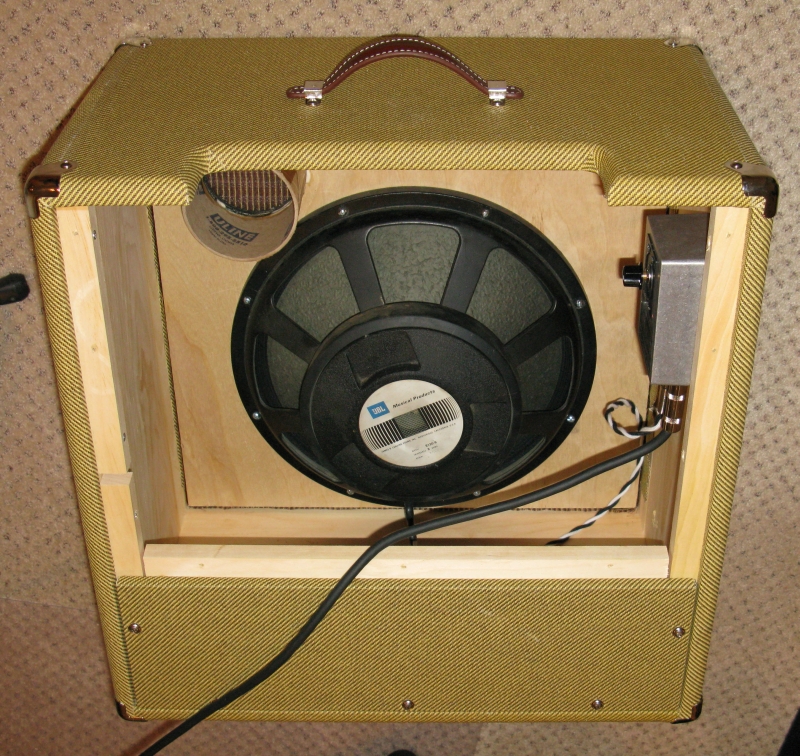
Note the cool green tint of the big 15 inch hemp cone. The speaker is very efficient (and loud) at 105dB SPL and is rated at 300 watts. This amp can keep up with any drummer. Carl's Custom Guitar's Speaker Soak attenuator installed at upper right to allow less-than-ear-splitting practice. The cab is a 5E3 combo but it's vented so it can also be used as a sealed back extension cab (you can't seal the back and run the 5E3 due to heat buildup).
Using a Bucking Transformer to Lower Your B+ Voltage
Back in the 1950's and 60's the US wall voltage was around 110 volts. Today it can be higher than 125volts. An amplifier's power transformer is stepping up the wall voltage by a factor of three or more so those extra 15 volts at the wall can be 45 volts of extra B+ which can affect the amp's tone (typically makes it louder and punchier). I built a simple and inexpensive bucking transformer to reduce wall voltage to a more vintage level.
My BuckMinister Bucking Transformer offers three voltage levels for your amp: full wall power in one socket and a choice of -7% or -12% voltage on the other socket. The mini-toggle SPDT ON/ON switch selects between -7% or -12% voltage reduction to lower your amp's voltages to vintage levels. The photos show a single power socket with a switch but a standard wall power outlet can be used so you will have three voltages available.
A good way to zero in on what voltage your amp should be at is to measure the heater circuits' AC voltage. They should read 5.0v AC for the yellow rectifier tube heater wires and 6.3v AC for the green tube filament heaters. Measure these voltages from wire-to-wire, i.e. put one voltage probe on one green wire and the other probe on the other green wire. If you measure one wire to ground you will get 1/2 of the true voltage. Use the bucking transformer switch position that gets these two voltages closest to spec and this should give you the 'intended output voltage' of your power transformer.
The Completed Buckminister Bucking Transformer
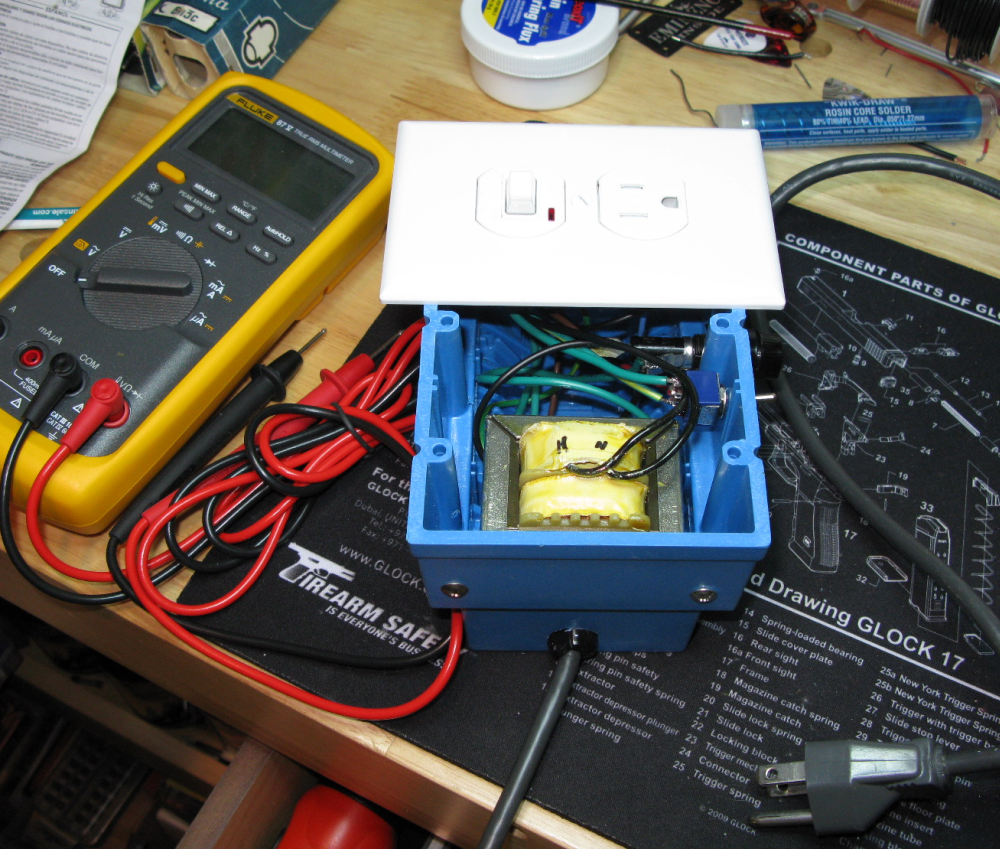
Note the fuse and toggle switch on the right side. The switch on the socket turns the socket on and off. The light on the socket indicates it is powered. I recommend using a normal two socket outlet so you will have full wall voltage on one socket and -7% or -12% on the other socket.
The fuse holder is standard Fender and houses a 125v 4A (or 250v 4A) fuse. The transformer is a Hammond 166N12B (12 volt 4 amp) tube filament transformer ($23 from Mouser.com).
Testing Before Final Assembly
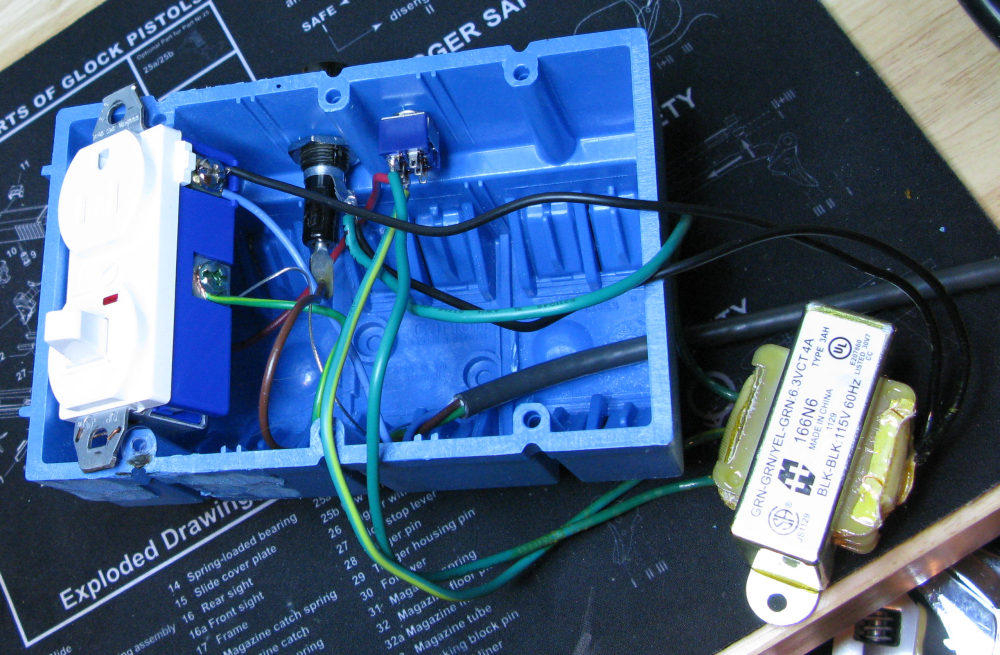
Photo shows a 166N6 6.3v transformer. I tried this transformer but got only -3.7% and -7% voltage reduction so I swapped it out for a Hammond 166N12B 12v 4 amp transformer and got -7% and -12% voltage reduction.
The blue box is a triple bay deep plastic electric switch box ($4 from Lowes). The switch/single-socket is a Cooper Wiring Devices TR274W ($9 from Lowes) with a built-in power light, switch and socket. If you use this switch be sure and use the right instructions. They're at the bottom right of the front page of instructions titled, "Single Pole Switch and Grounding Receptacle" and use configuration #3. "Remove Break-Off Tab. Receptacle controlled by switch. Connect jumper wire as shown. Pilot light is ON when switch is on." You have to run a jumper wire from the socket side black screw to the brass screw. Other black screw is Hot, silver screw is Neutral, green screw is ground.
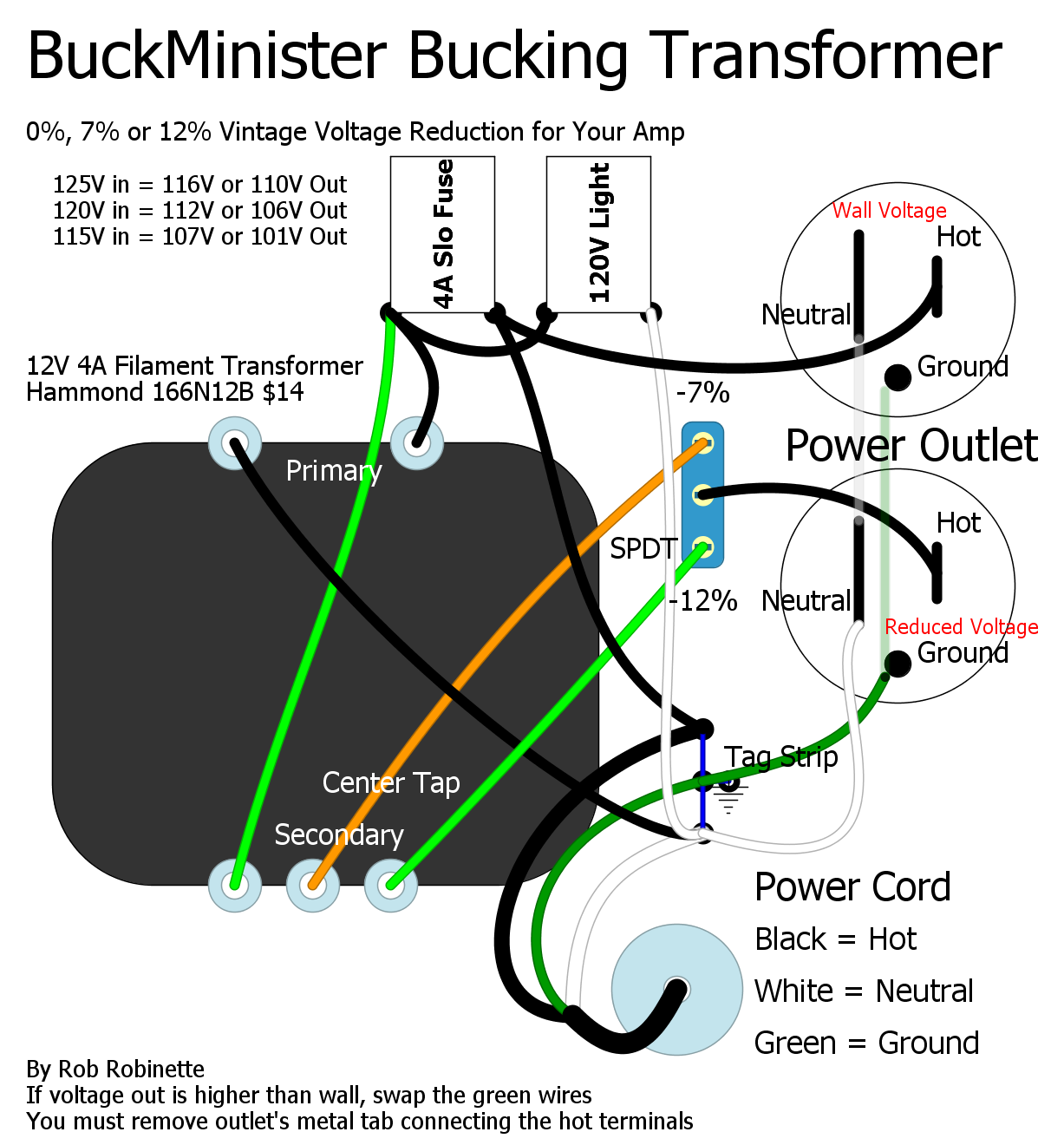
Upper socket has full wall voltage. Lower socket is selectable with the toggle switch for -7% or -12% voltage reduction.
I didn't use a tag strip since the box was plastic and didn't need to be grounded. If you use a metal chassis you must ground the chassis to the power cord's ground wire so a tag strip makes that easy. I ran the ground and neutral wires directly from the power cord to the output socket. The power cord's narrow prong black 'hot' wire is connected directly to the fuse.
In the U.S.A. 3-prong power cords have a narrow, wide and round prong. The 'Hot' (power) wire of the power cord connects to the narrow blade prong. The 'Neutral' (power return) wire is connected to the wide blade prong. The safety ground wire is connected to the round or 'D' shaped prong.
You must remove the power outlet's metal tab that connects the two 'hot' terminal screws (narrow blade sockets are hot). Do not remove the 'neutral' metal tabs because you want them to stay connected. Separating the two hot screw terminals will allow you to run two different voltages on the two sockets.
Your transformer must have a secondary center tap to use it as a bucking transformer. On the transformer one black and one green wire must be connected to the fuse. If you choose wires that are diagonal from one another (back right and front left) you will get a step-down voltage. If you use a black and green from the same end of the transformer you'll get a step-up transformer.
If you end up with higher voltage than wall power simply swap the two green secondary wires and you'll get a lower than wall voltage output.
I first tried using a Hammond 6.3 volt 166N6 transformer. With a wall voltage of 121.25 my B+ was 430. With the bucking transformer in the Low position my B+ was reduced to 414v for an actual reduction of 3.7% (output socket was at 116.9v). In the Lower position my B+ was 399 for a reduction of 7% (socket at 112.9v).
Since the voltage reduction with the 166N6 transformer was less than I expected I changed it out for a Hammond 12 volt 4 amp 166N12B ($23). With this transformer and wall voltage of 120.0 volts I got 112v (-7%) and 106v (-12%).
I did flip the switch between the two voltages with an amp plugged in and running and it didn't cause any drama or pops.
BuckMinister Bucking Transformer Schematic
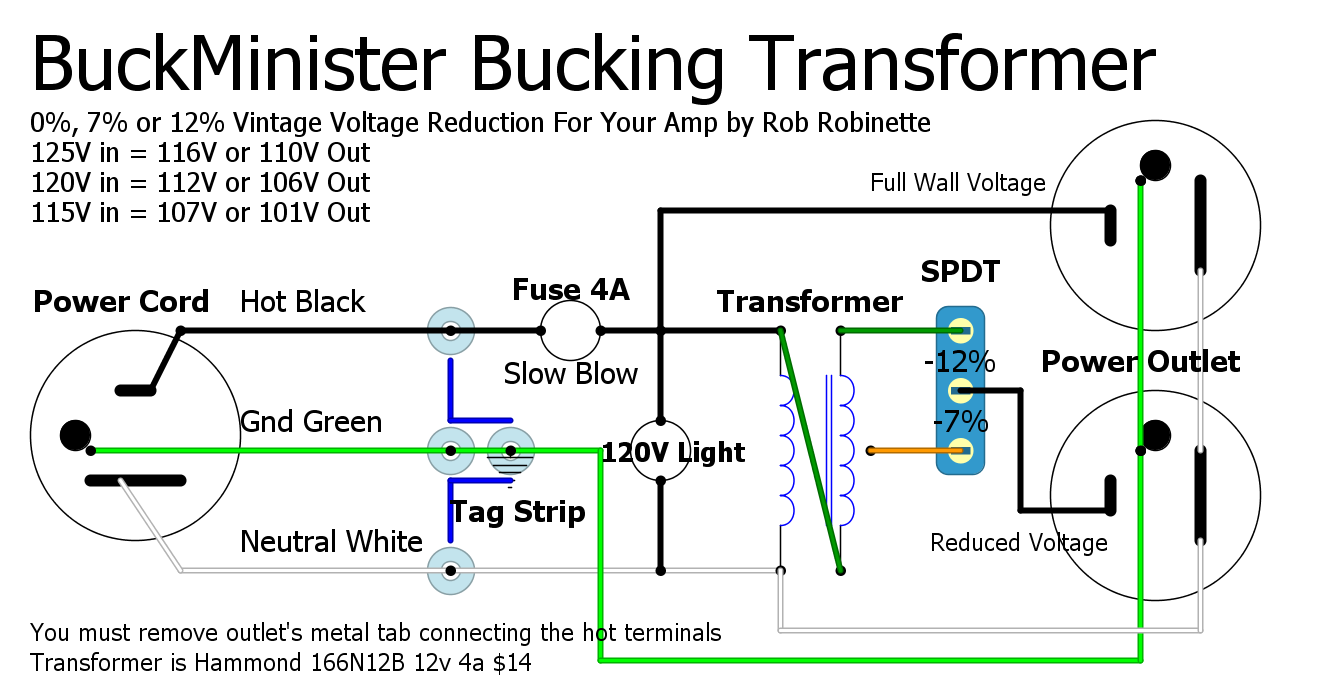
The indicator light is optional, the fuse isn't. Upper outlet socket is full wall voltage. The lower socket is selectable between -7% and -12% voltage.
You can download the Buckminister Layout and Schematic DIYLC (DIY Layout Creator) files.
Here's an even simpler design of a bucking transformer. There's no switch and each socket puts out a different reduced voltage:
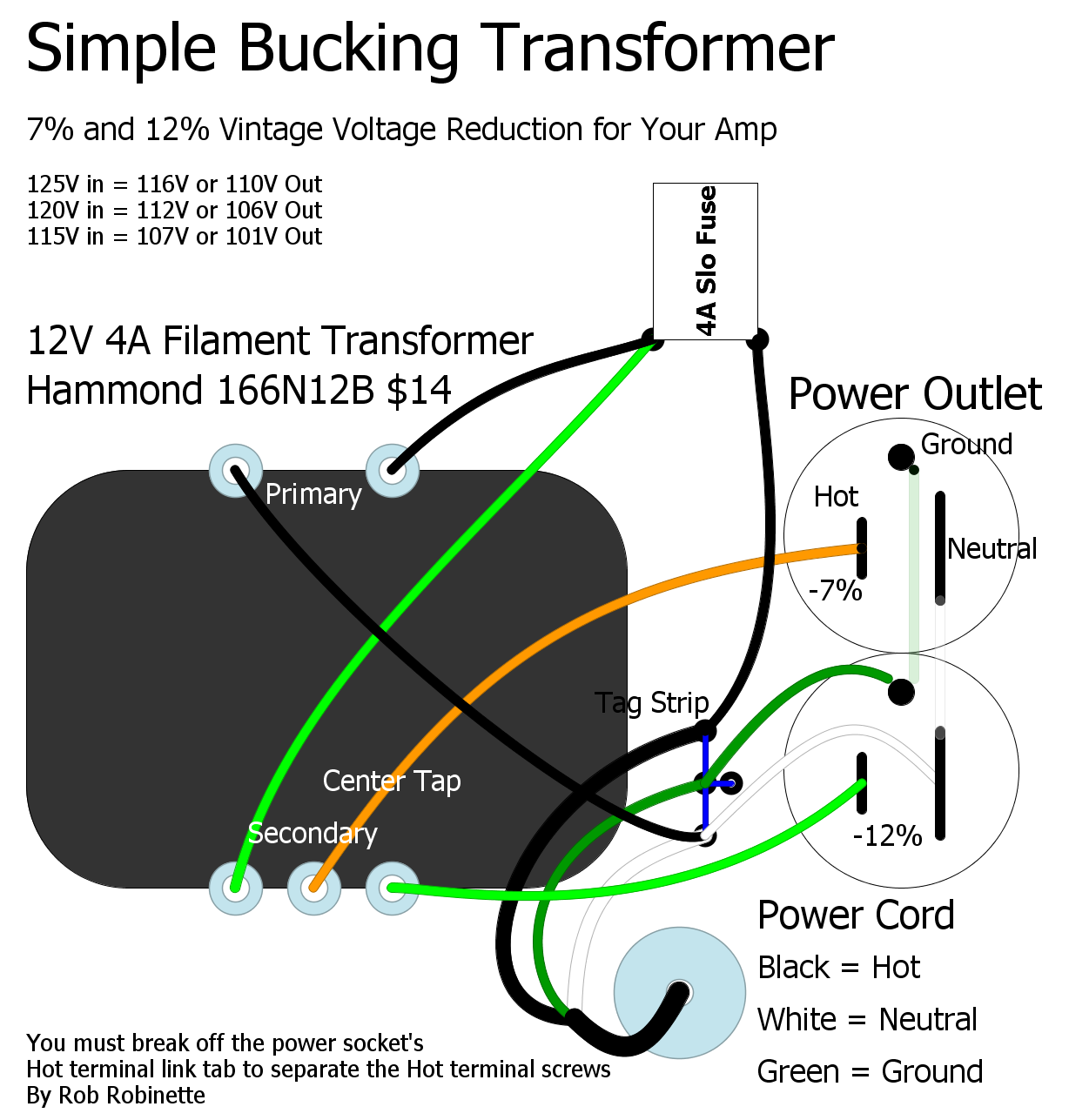
Most electrical sockets have thin metal 'Parallel Link Tabs' that connect the two sockets to one another. You must remove or break off the tab that connects the two 'Hot' (narrow prong) screw terminals. You can use a flat blade screwdriver or pliers to bend the parallel tab back-and-forth until it breaks off.
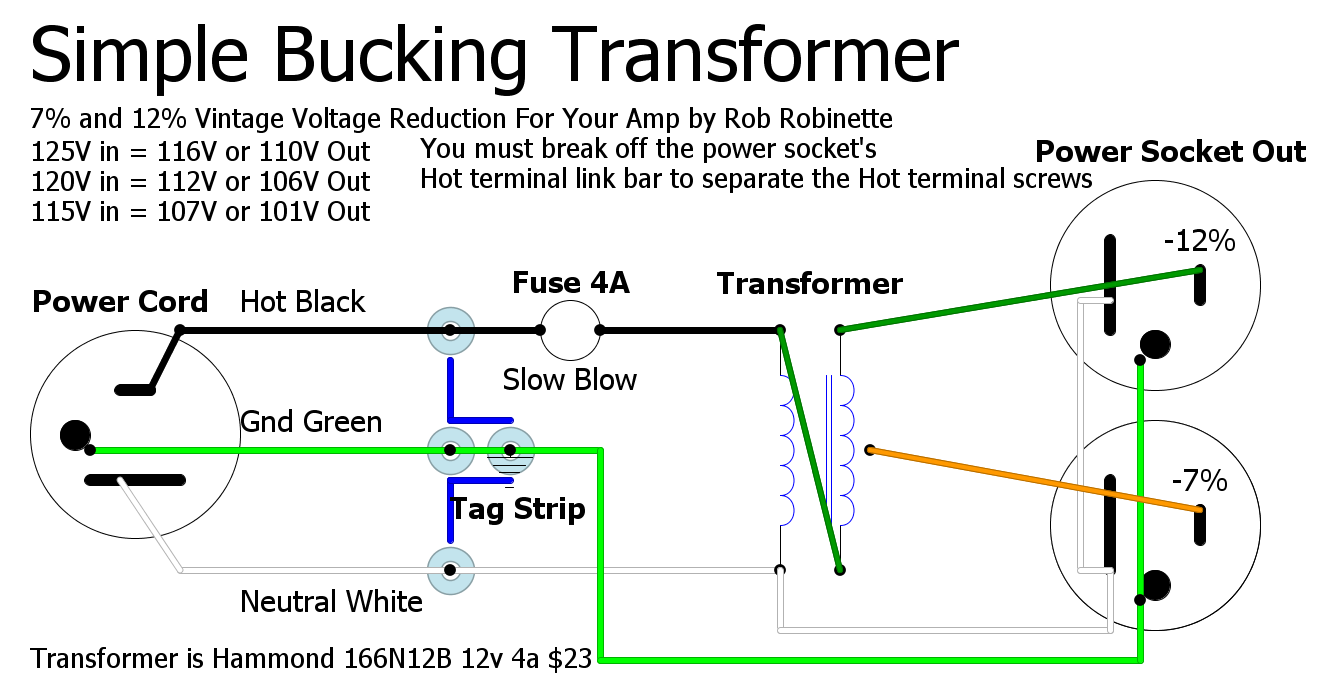
The power outlet's Hot link tab between the Hot screw terminals must be broken off so you can supply different voltages to the two Hot terminals.
Inexpensive Line Conditioner for Clean Constant Voltage
This $99 Tripp Lite LC1200 available from Walmart will protect your amp from power-related damage and cut line noise. It has transformer-based voltage correction circuits that maintain 120V output during voltage fluctuations between 89 and 147 volts. It also has advanced Isobar surge and noise suppression circuitry to reduce noise and hum--this is what separates it from the $50 APC LE1200 voltage regulator which I also use. Their rating of 1200VA is enough for a 100 watt tube amp.
Build a Light Bulb Current Limiter
An amplifier light bulb current limiter is useful for starting up a newly built amplifier and can keep you from blowing fuse after fuse as you troubleshoot a problem amp. It can also help prevent wiring mistakes from causing component damage in the amp.
It can be used on all kinds of electronics but heavy current users such as electric motors will be affected by the low current limit of the light bulb. A 150 watt incandescent light bulb will only allow about 1.25 amps of max current (150w / 120v = 1.25a) to flow through the amp. Most amp's main fuses are 2 amps or greater so you shouldn't blow a fuse even with a full on amplifier short circuit. If your equipment needs more power move up to a higher wattage light bulb, a 300w bulb is good for about 2.5 amps.
You can also use a dual bulb adapter that has two bulb sockets so you can use two bulbs to double the amperage available to use with bigger amplifiers.
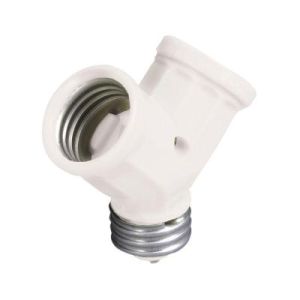
Keep in mind that this limiter will drop the AC voltage supply to your amp so don't be surprised by the low B+ voltages and if you play the amp it will sound weak and different.
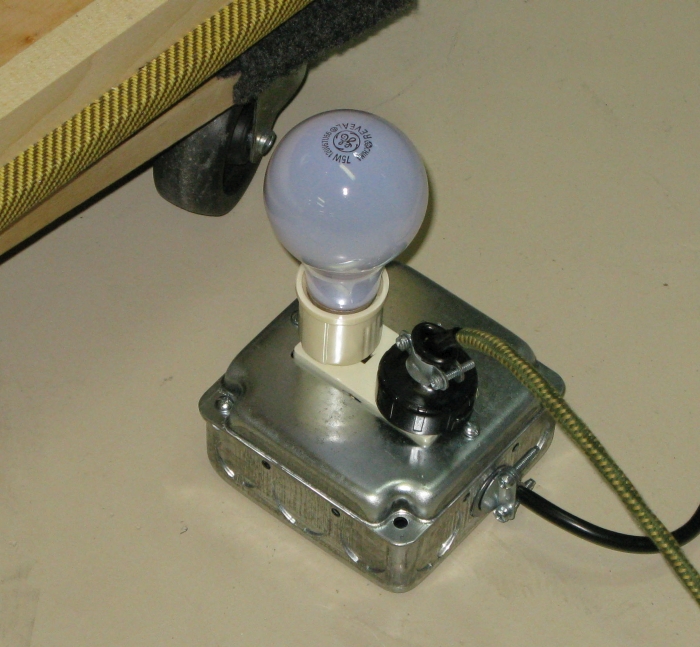
See my Light Bulb Limiter Youtube video to see how it should light up when a working amp is turned on.
The limiter pulls all the amp's power through the light bulb filament so the more the amp pulls the brighter the bulb. With the amplifier turned off the bulb will not be lit.
On a normal amp turn-on using a 150w light bulb it will only make the bulb's filament glow a bright red for a few seconds and then dim as the amp is turned on. The bulb will go bright again when the Standby Switch is turned on and the amp's capacitors are charged, then dim as the amp's power stabilizes. If the amplifier has a problem (like a short to ground) the light bulb will glow brighter than normal. If the amp has a short circuit the light bulb will stay lit at its normal, full brightness.
Building the Light Bulb Current Limiter
Everything you need to build a light bulb limiter is available from Home Depot or Lowes:
Electrical power box ($3), 3-prong power cord ($5), duplex electrical outlet ($2), outlet face plate ($1), 100W to 150 watt incandescent light bulb (no fluorescent or LED) and socket adapter ($3), and power cord strain relief bushing ($1).
Start the build with breaking off the electrical outlet's two metal 'Parallel Power Link Tabs' that connect the two sockets in parallel. The are located between the two sets of screw terminals. Since we want to run the power in series between the two plug receptacles we need to separate the two screw terminals on both sides of the receptacle by removing the tabs.
Run a jumper wire diagonally from one terminal screw on one side of the socket to the other side's screw terminal (as shown below). Install the conduit strain relief bushing on the box and push the power cord through. Connect the power cord's black (hot) wire to an open screw terminal--this side of the outlet is where you should insert the light bulb. Connected this way power will flow through the black hot wire, through the light bulb then to the amplifier so if the light bulb blows then the amplifier will be disconnected from the hot supply wire.
Connect the power cord's white (neutral) wire to the remaining open screw terminal which should be on the amplifier side of the outlet. Mark or label the sockets so you know where to plug in the amp and bulb.
Attach the power cord's green (ground) wire to the metal electrical box and power outlet green ground screw. If a plastic electrical box is used then the box does not need to be grounded but the outlet ground must be connected to the power cord ground. Attach the outlet to the electrical box and install the outlet faceplate.
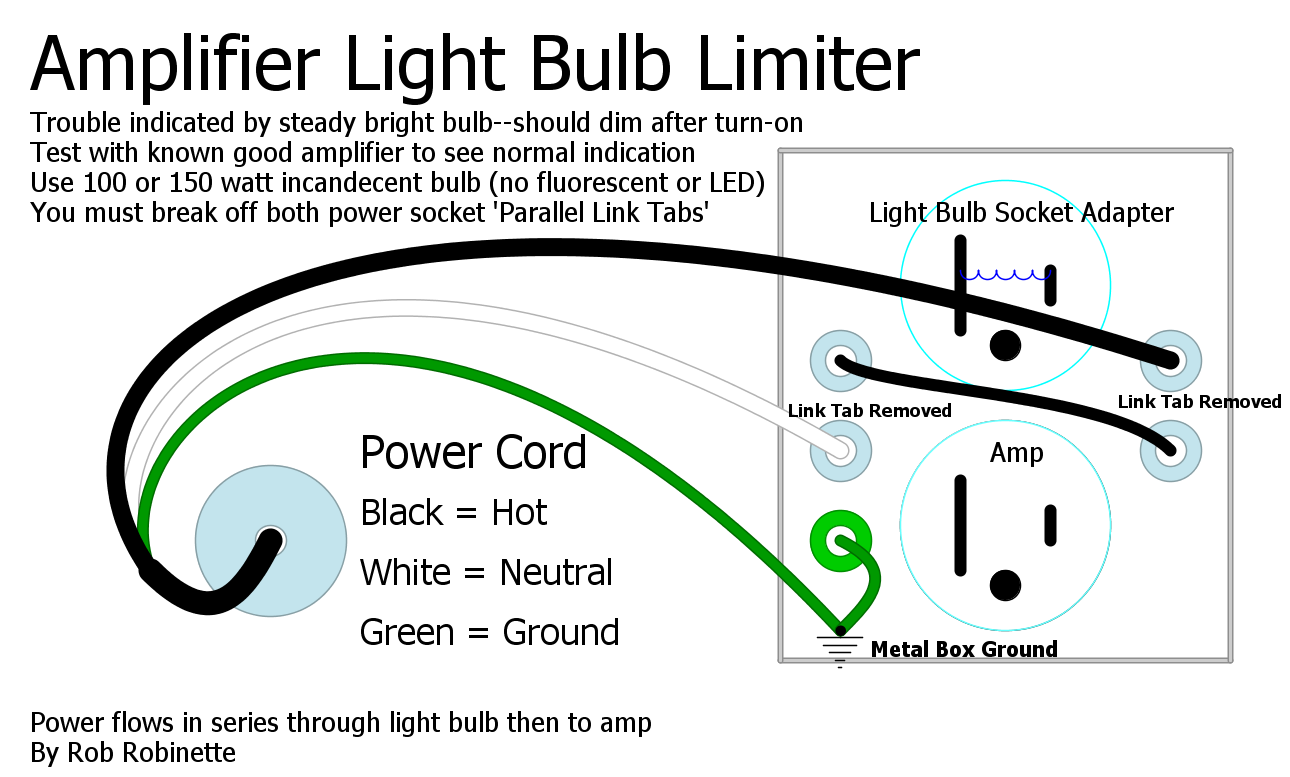
Plug light bulb with 'light bulb to socket adapter' into its socket and plug the amplifier into the other socket. Power flows in series through the light bulb filament and then to the amplifier. During normal amplifier startup a 150 watt light bulb's filament will glow bright red as the amp's capacitors are charged, then dim as the amp's power stabilizes. If the amplifier has a short circuit the light bulb will light up to its rated brightness.
Duplex Outlet Light Bulb Socket Adapter Power Cord Strain Relief
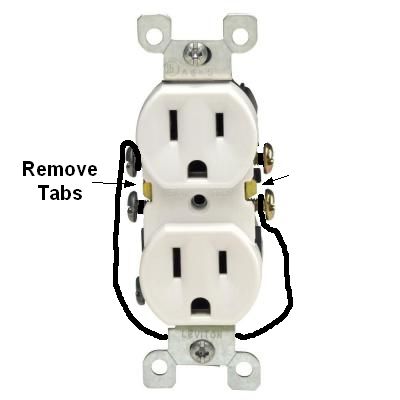
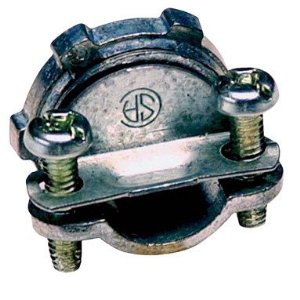
Wired Limiter
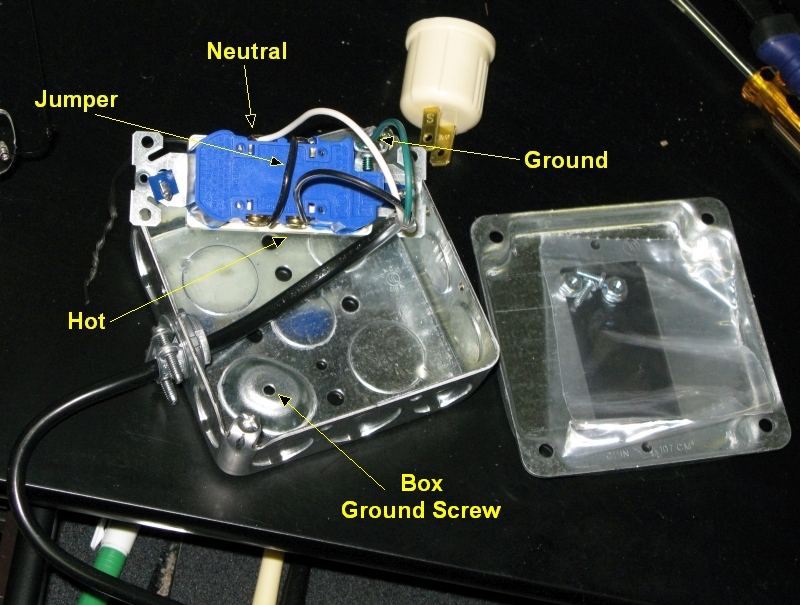
Note black diagonal jumper wire running across the back of the outlet. Power cord black and white wires go to the other two terminal screws and the green wire goes to the outlet ground screw. Run a ground jumper wire from the outlet ground screw to the metal box ground screw (not shown above). Cord strain relief bushing (on left side of metal box) shouldn't be tightened until assembly is complete.
See a short youtube video of the light bulb limiter in action. In the video I use a 75 watt bulb but a higher watt 100 or 150 watt bulb will more clearly show when a short is happening because a normal amp will only make the bulb filament glow red but a short circuit will light it up to its full brightness. Try the limiter with a known healthy amp so you'll know how the bulb should look during startup.
Remember, all amplifier voltages will be abnormally low when it's connected to a light bulb limiter. Remove the limiter to measure your amp's voltages.
Create an Amplifier Tube Chart
This is a reproduction of a standard tweed era tube chart that Fender glued to the inside of their amps:
Click the image to download the editable 5E3_Tube_Chart.doc
Here's a good "glue paper to wood" how to.
The Original Fender Deluxe 5E3
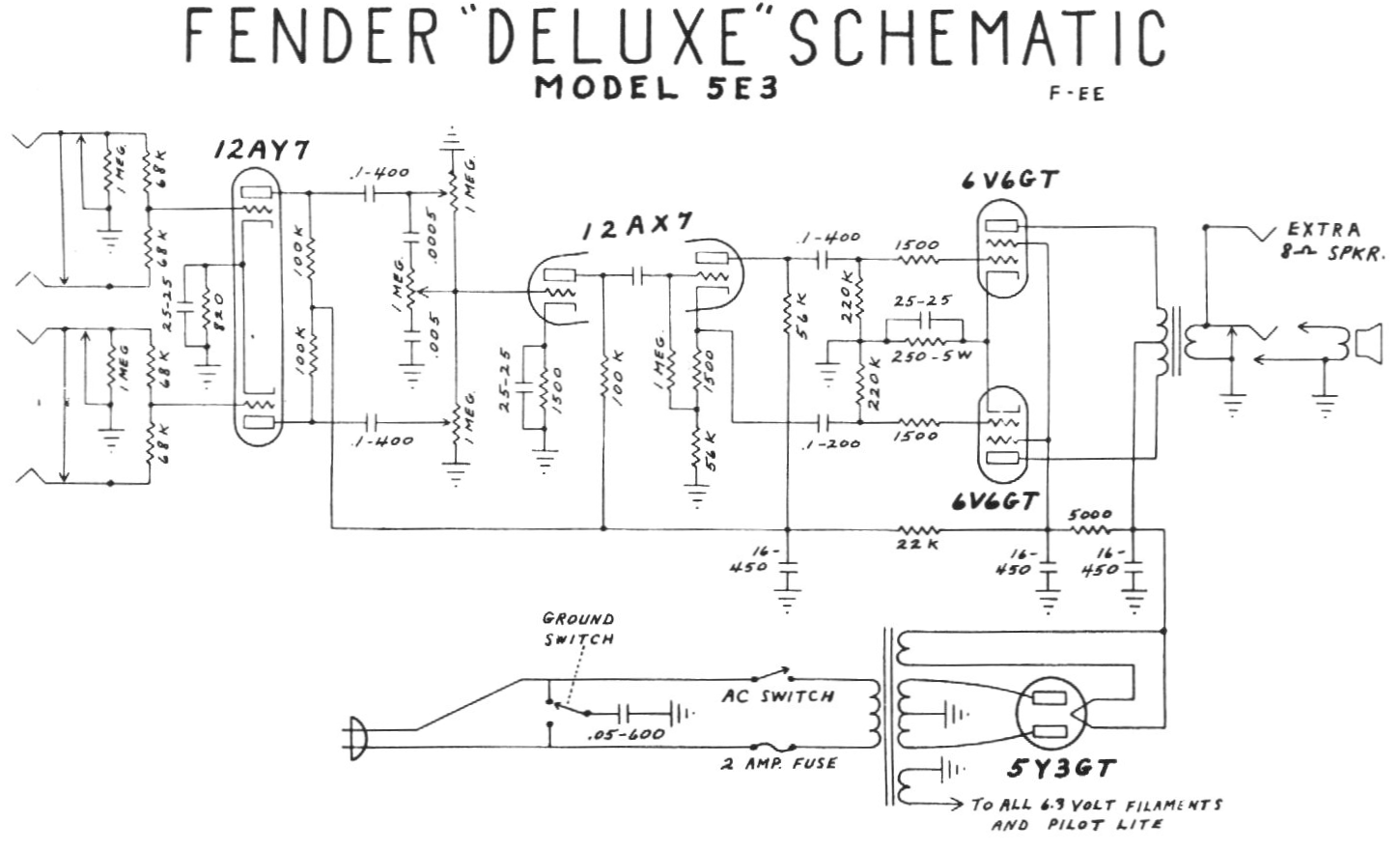
This is a beautifully simple and elegant design. Can it be improved upon? Leo Fender thought so when he created the next generation Deluxe, the 'brown face" (see below). He upgraded the first preamp tube, separated the volume controls, changed the phase inverter to a long tail pair (LTP), switched to fixed bias power tubes, added a 16uF filter cap to stiffen the power supply, added tube bias tremolo and increased voltage with a GZ34 rectifier tube.
The Follow-On 6G3 "brown face" Deluxe
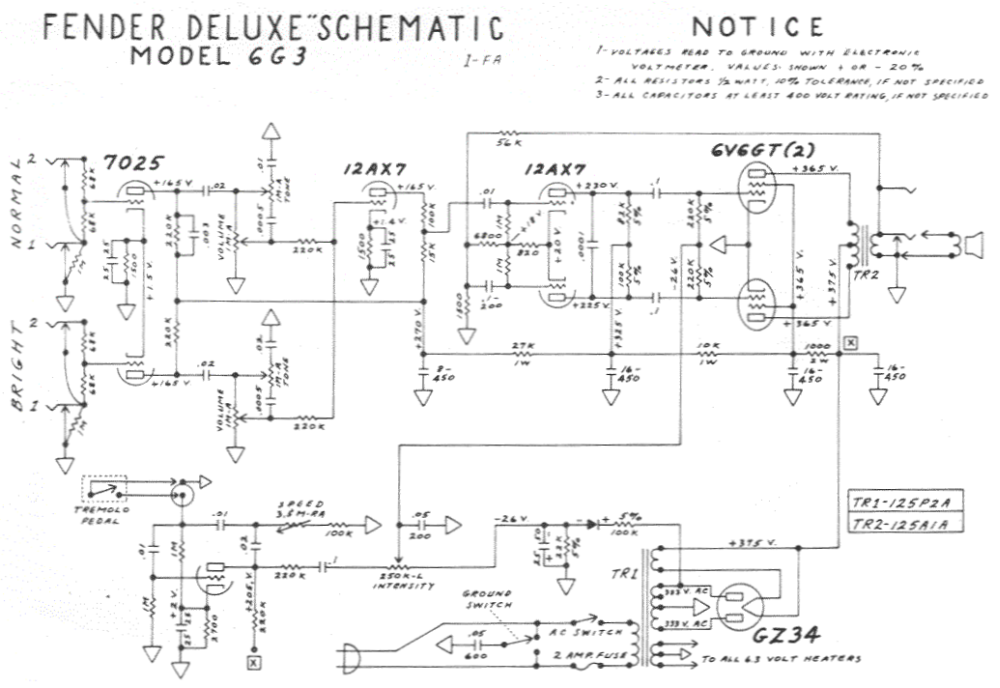
This is the next version of the Deluxe following the iconic 5E3. The 7025 preamp tube is just a high quality 12AX7. Today a good 12AX7 is used in its place. For more info on all the other Fender Deluxe amps see the Deluxe Models page.
Have comments or corrections? Email rob at:
![]()
By Rob Robinette
References
RCA Corporation, RCA Receiving Tube Manual, RC30.
Merlin Blencowe, Designing Tube Preamps for Guitar and Bass, 2nd Edition.
Merlin Blencowe, Designing High-Fidelity Tube Preamps
Morgan Jones, Valve Amplifiers, 4th Edition.
Richard Kuehnel, Circuit Analysis of a Legendary Tube Amplifier: The Fender Bassman 5F6-A, 3rd Edition.
Richard Kuehnel, Vacuum Tube Circuit Design: Guitar Amplifier Preamps, 2nd Edition.
Richard Kuehnel, Vacuum Tube Circuit Design: Guitar Amplifier Power Amps
Robert C. Megantz, Design and Construction of Tube Guitar Amplifiers
Neumann & Irving, Guitar Amplifier Overdrive, A Visual Tour It's fairly technical but it's the only book written specifically about guitar amplifier overdrive. It includes many graphs to help make the material easier to understand.
T.E. Rutt, Vacuum Tube Triode Nonlinearity as Part of The Electric Guitar Sound
[ How the 5E3 Deluxe Works ] [ Deluxe Models ] [ DRRI & 68 CDR Mods ] [ Amp Troubleshooting ] [ My 5E3 Build ] [ Spice Analysis ] [ The Trainwreck Pages ] [ Fender Input Jacks ] [ B9A Prototype Boards ]

